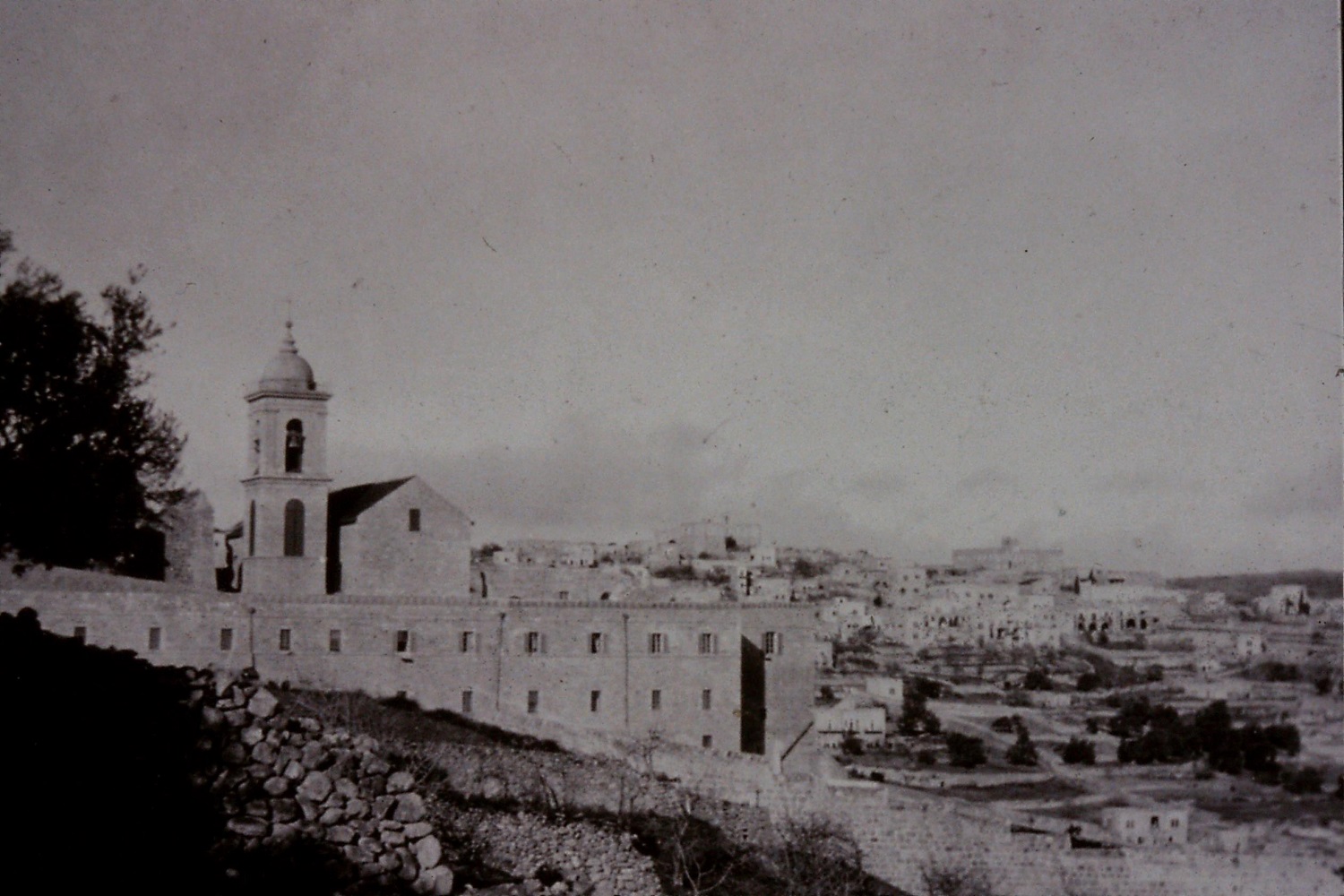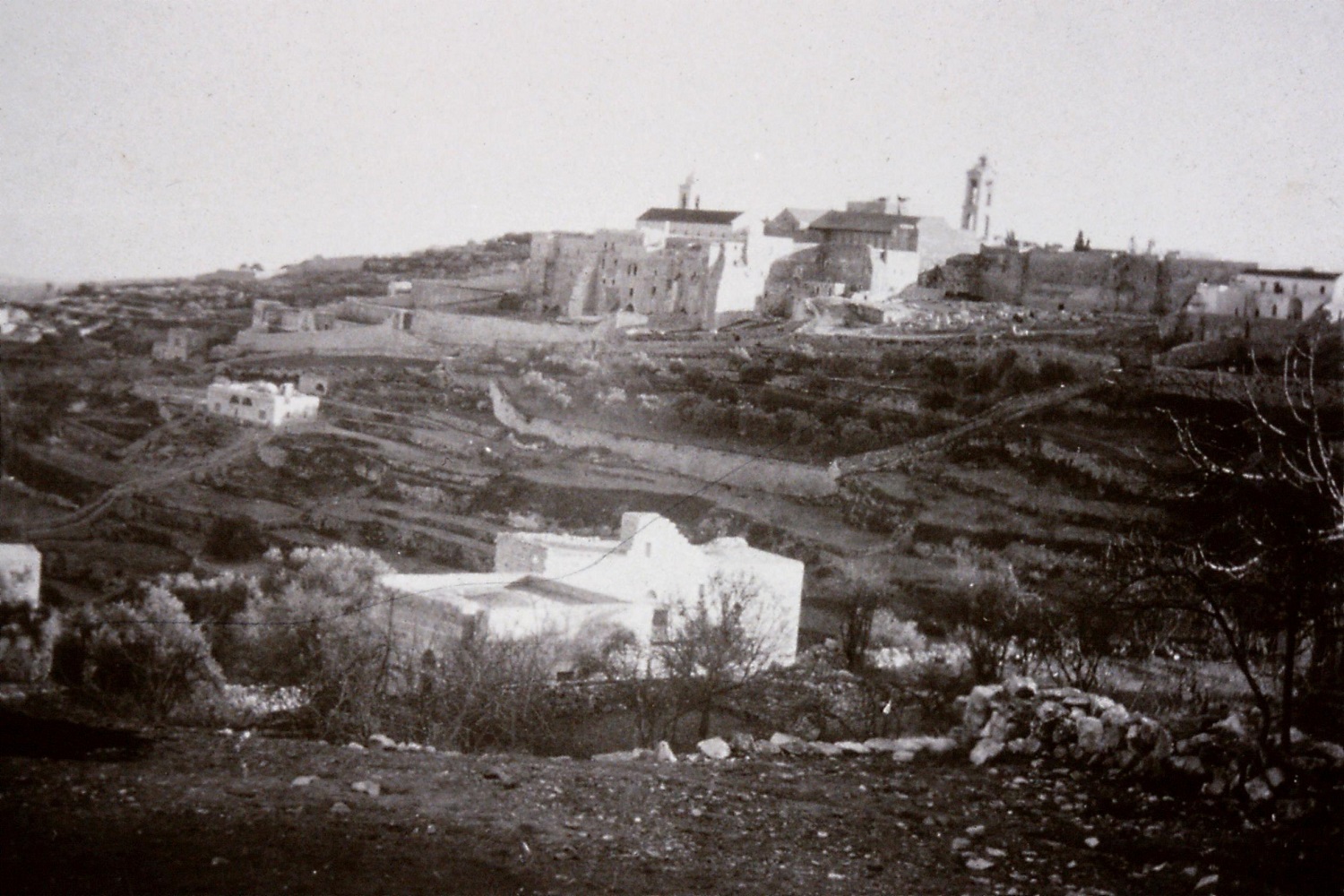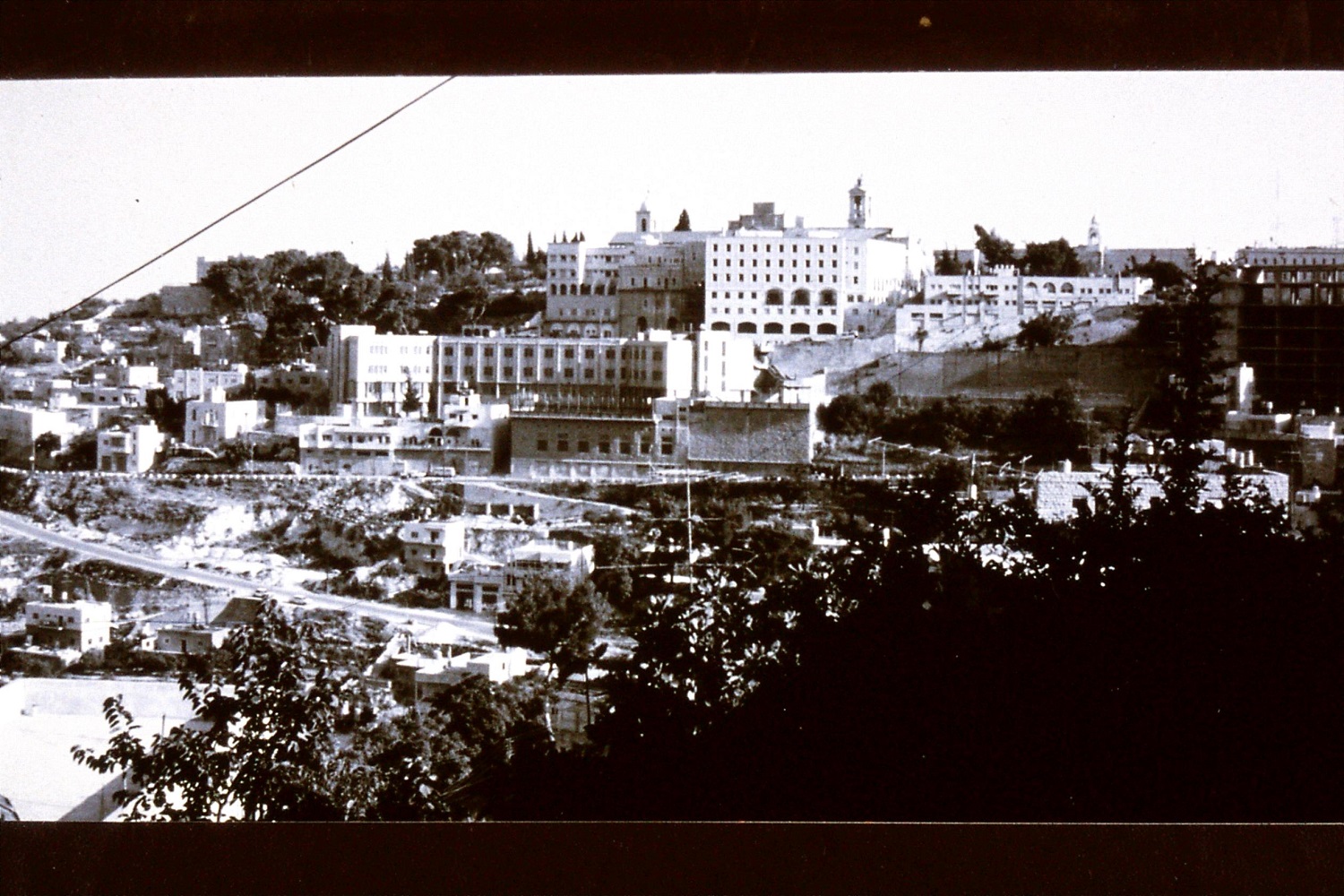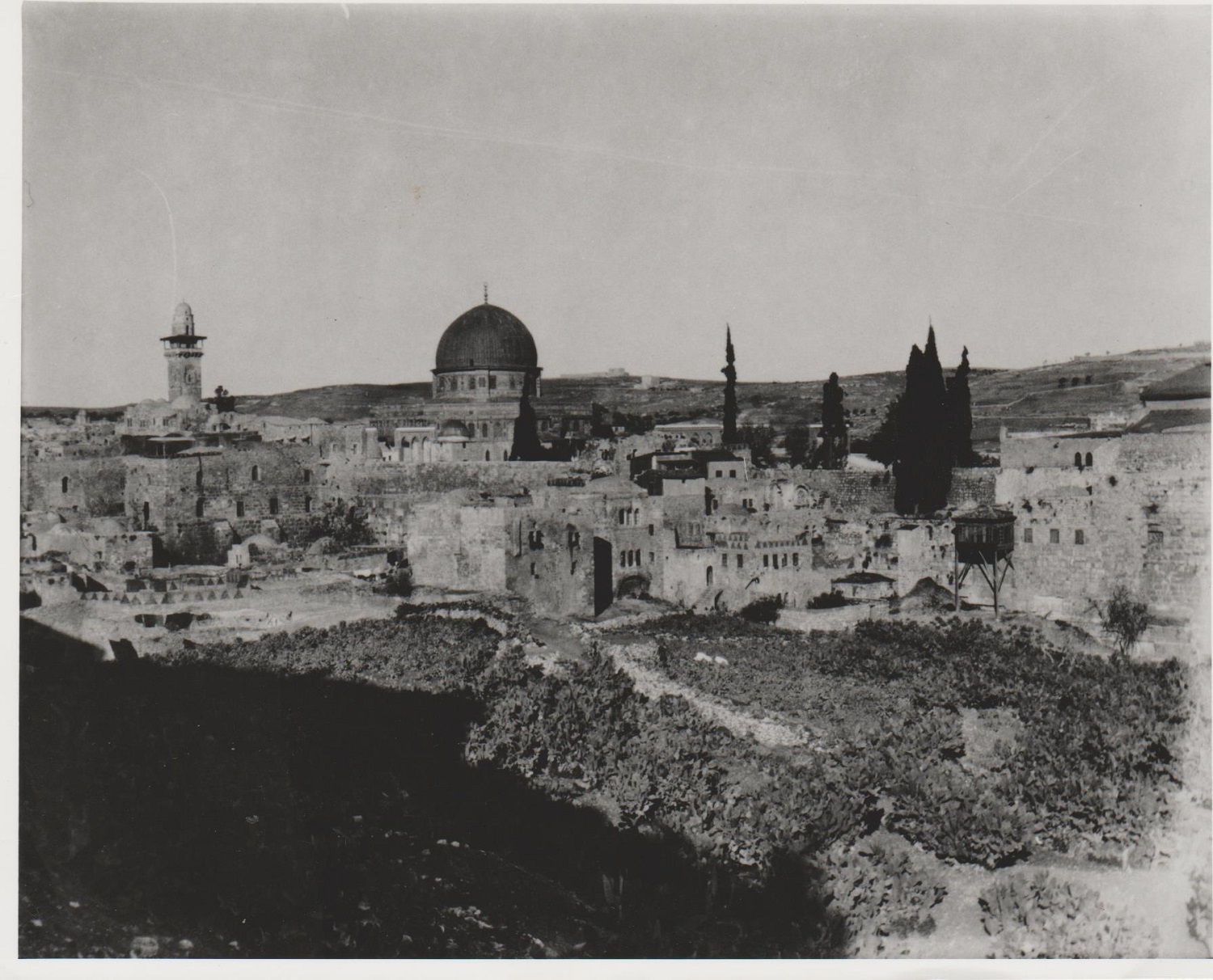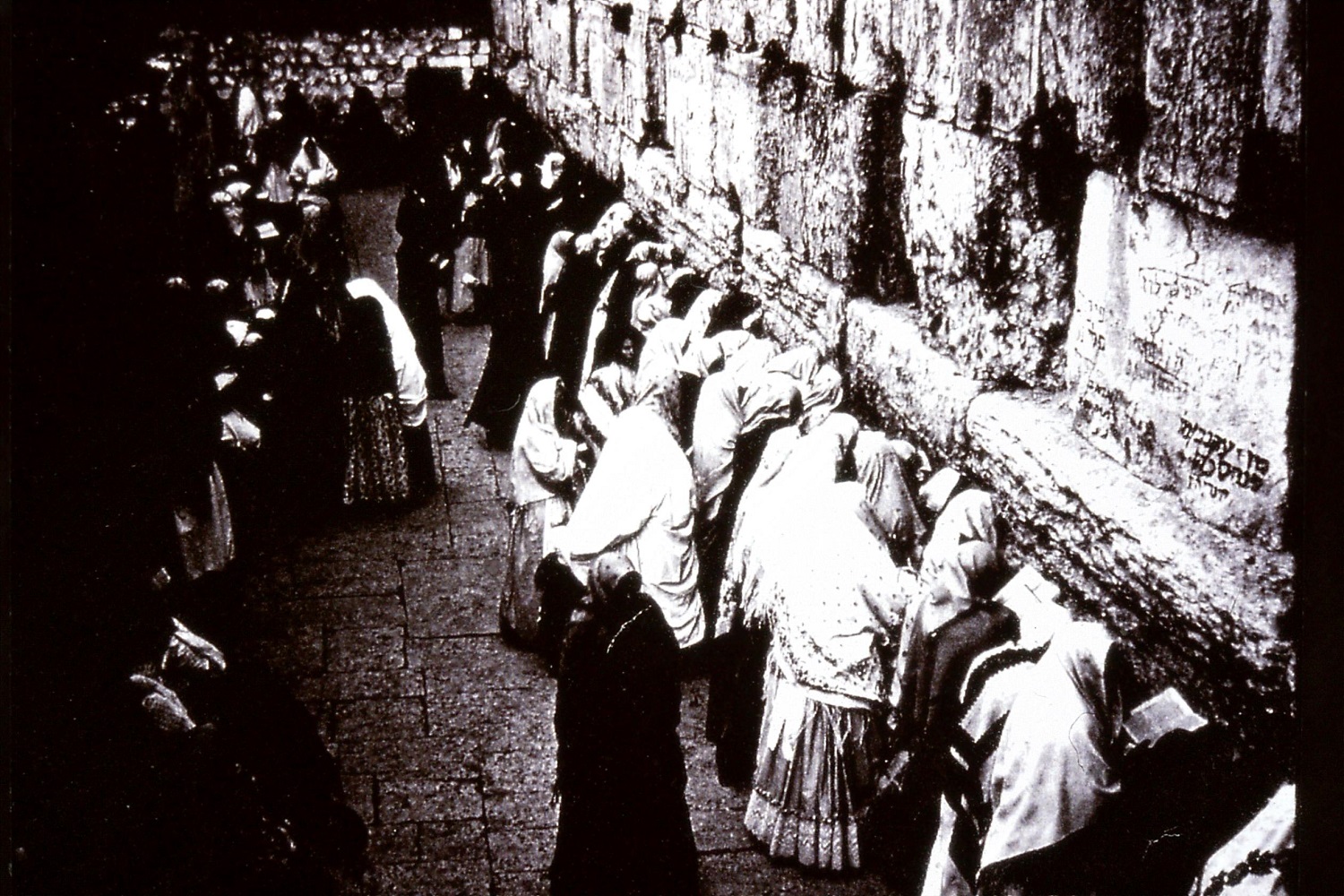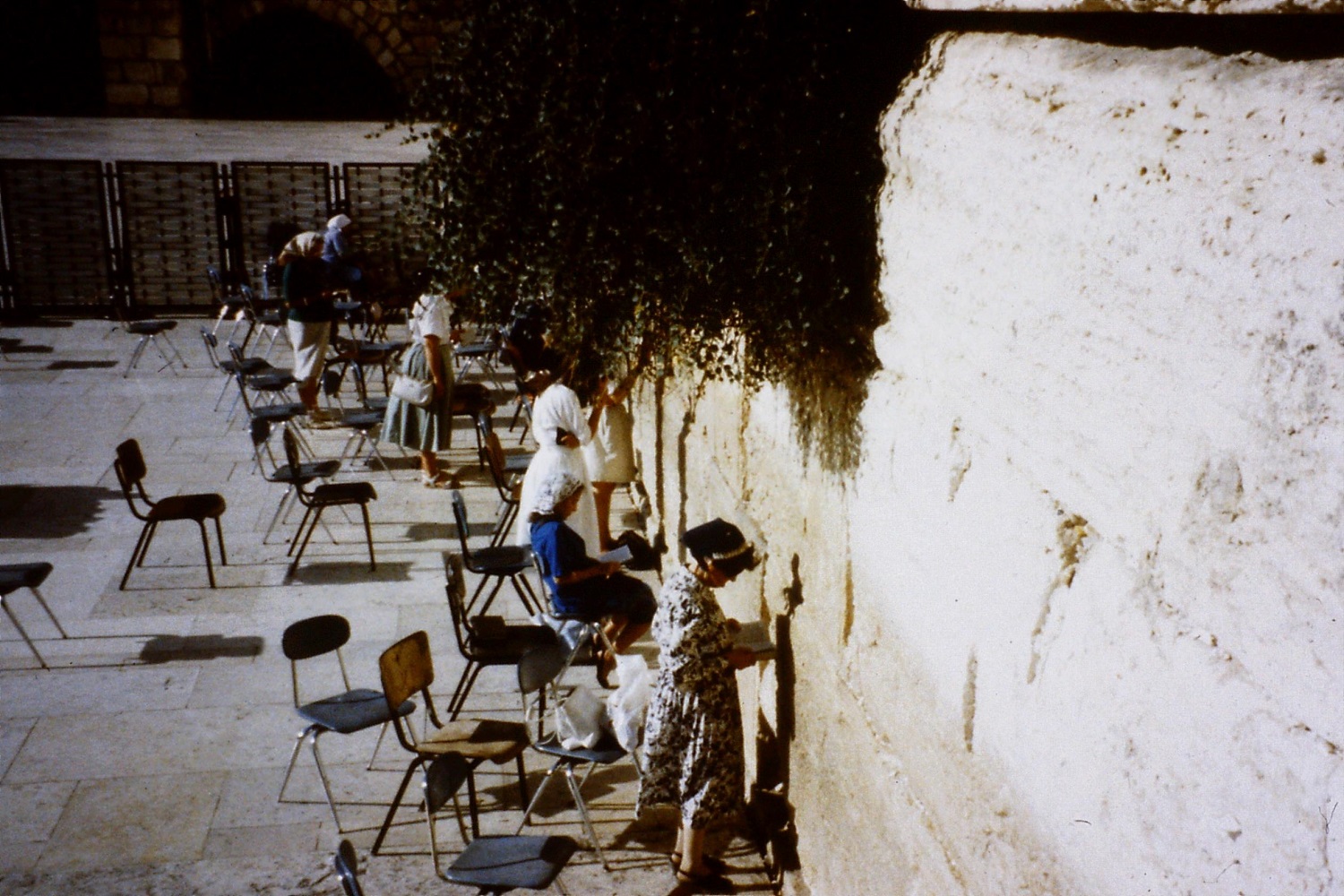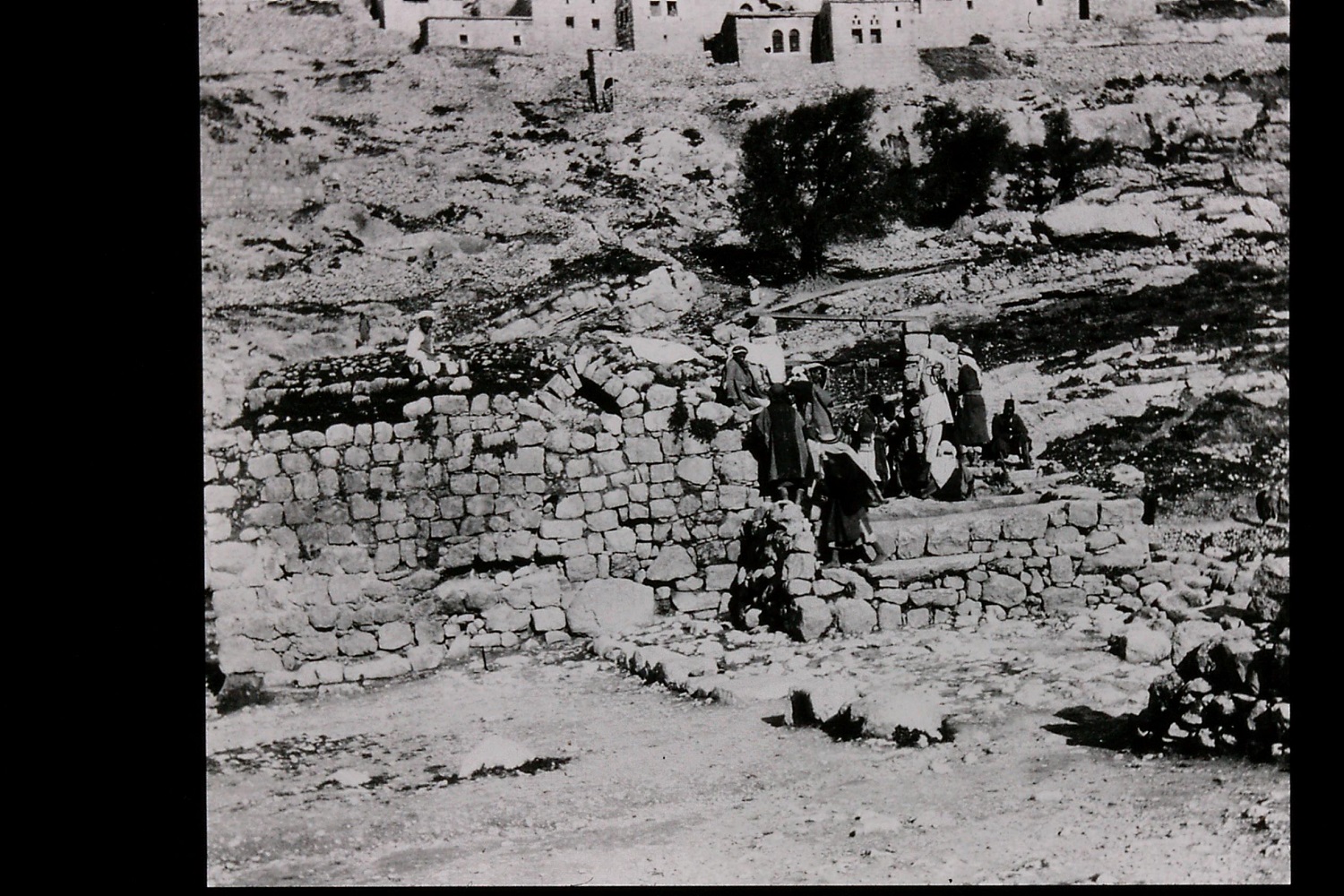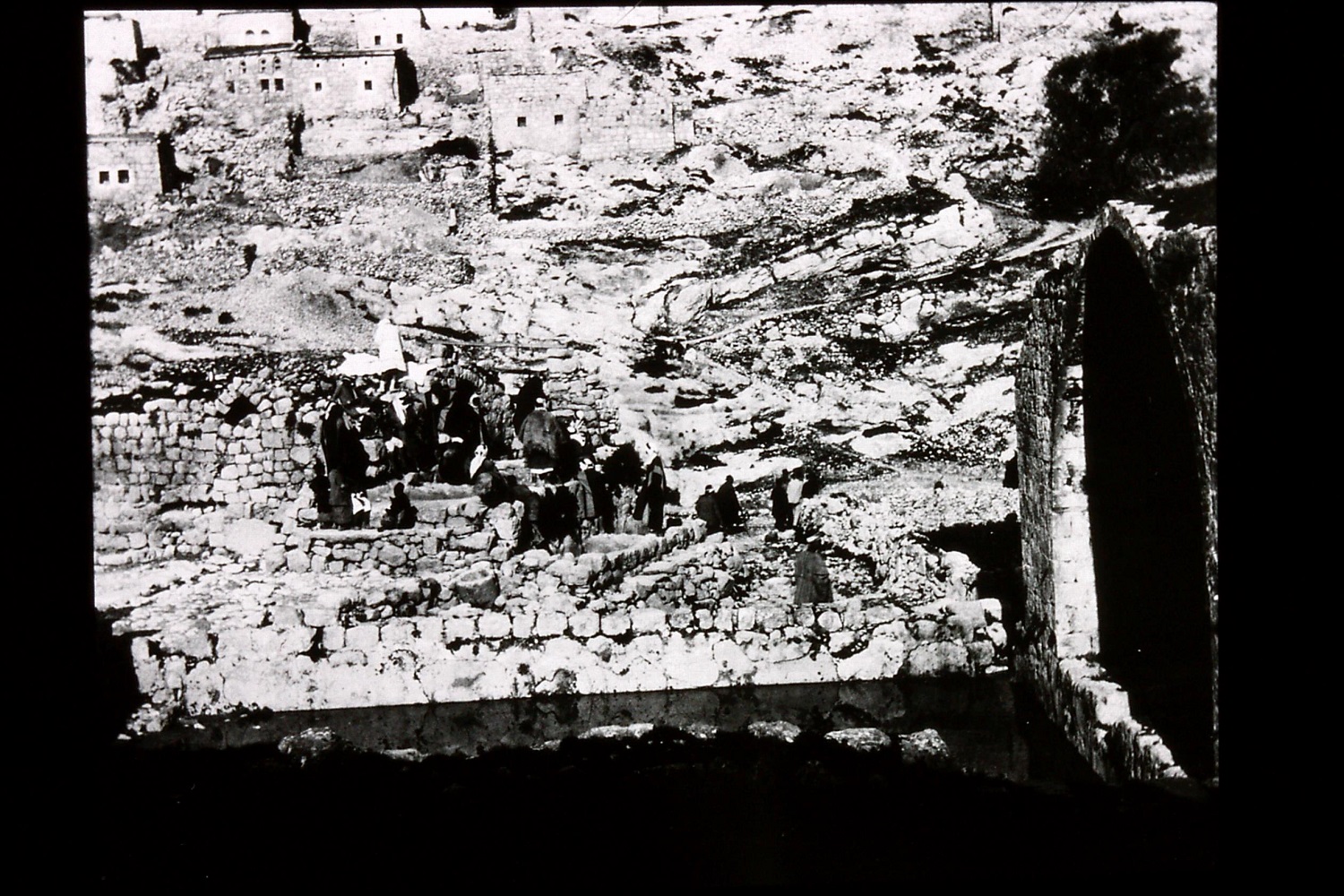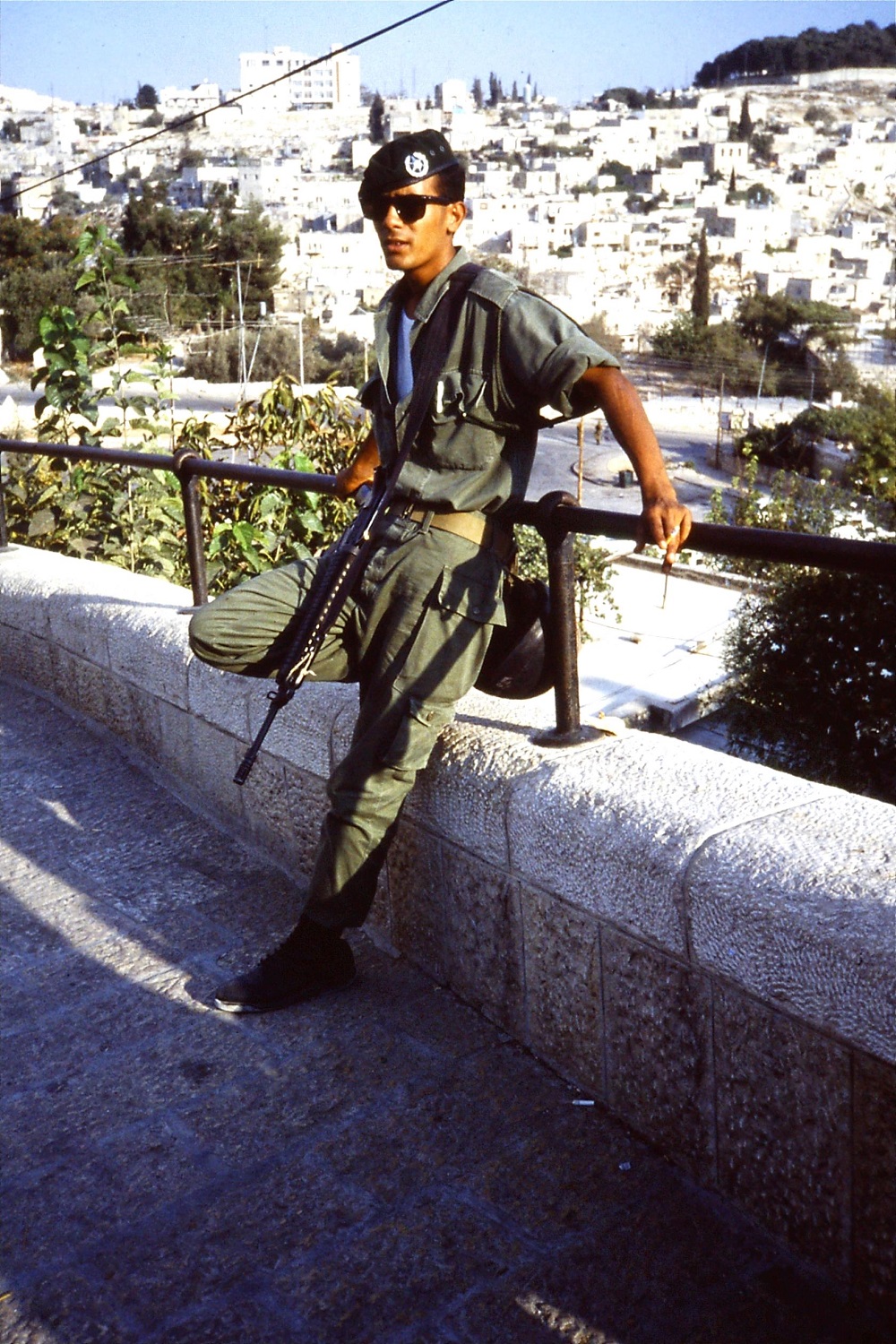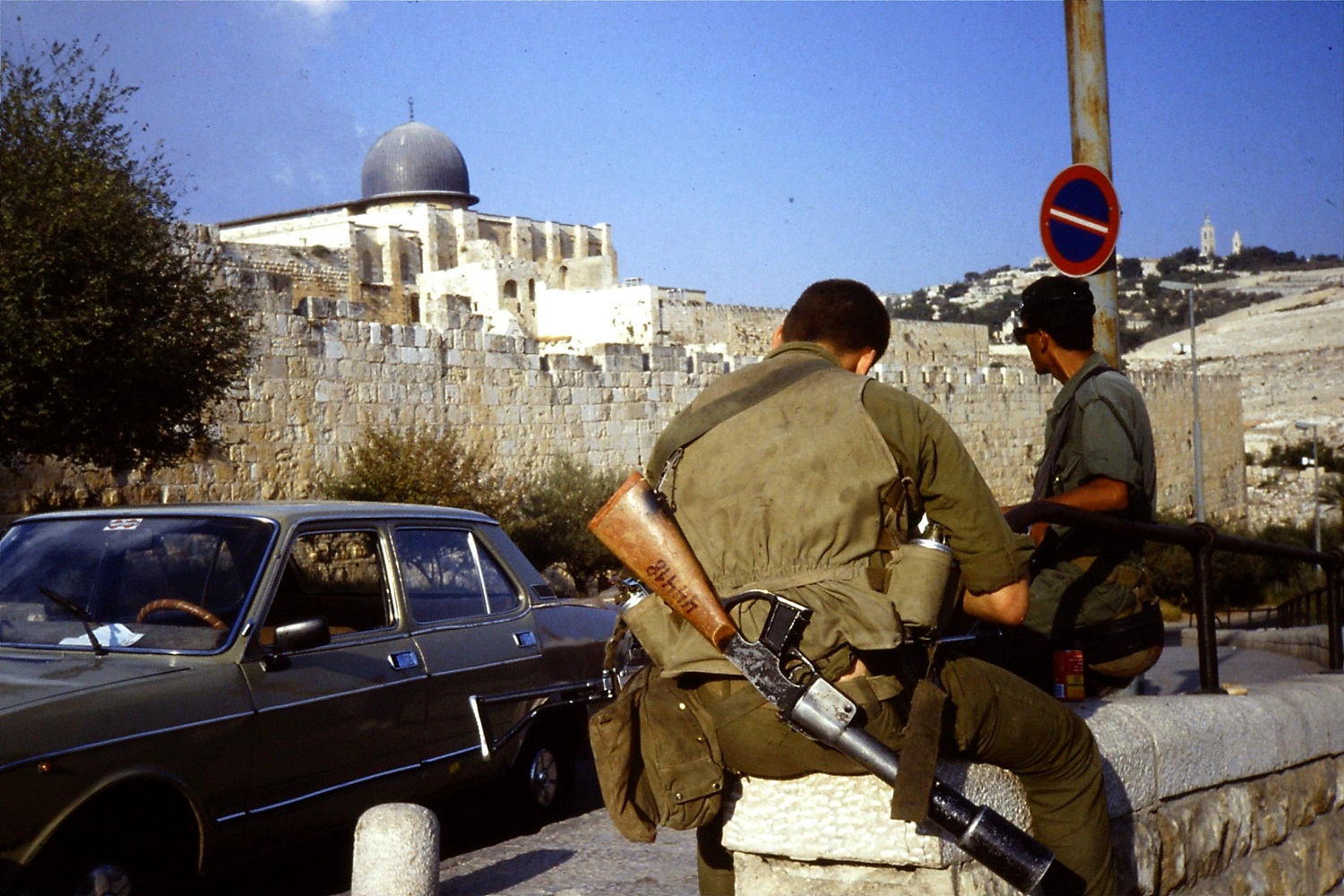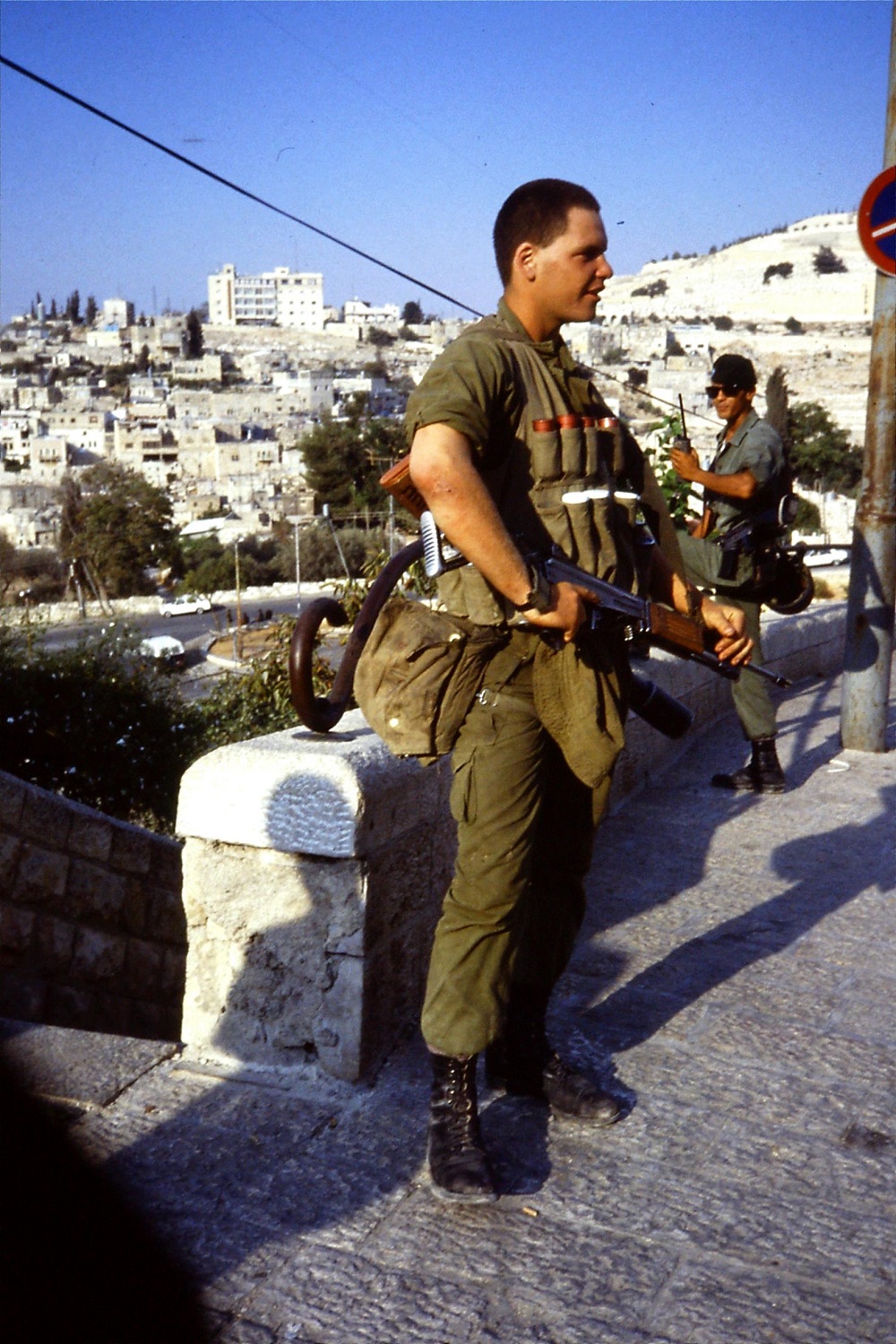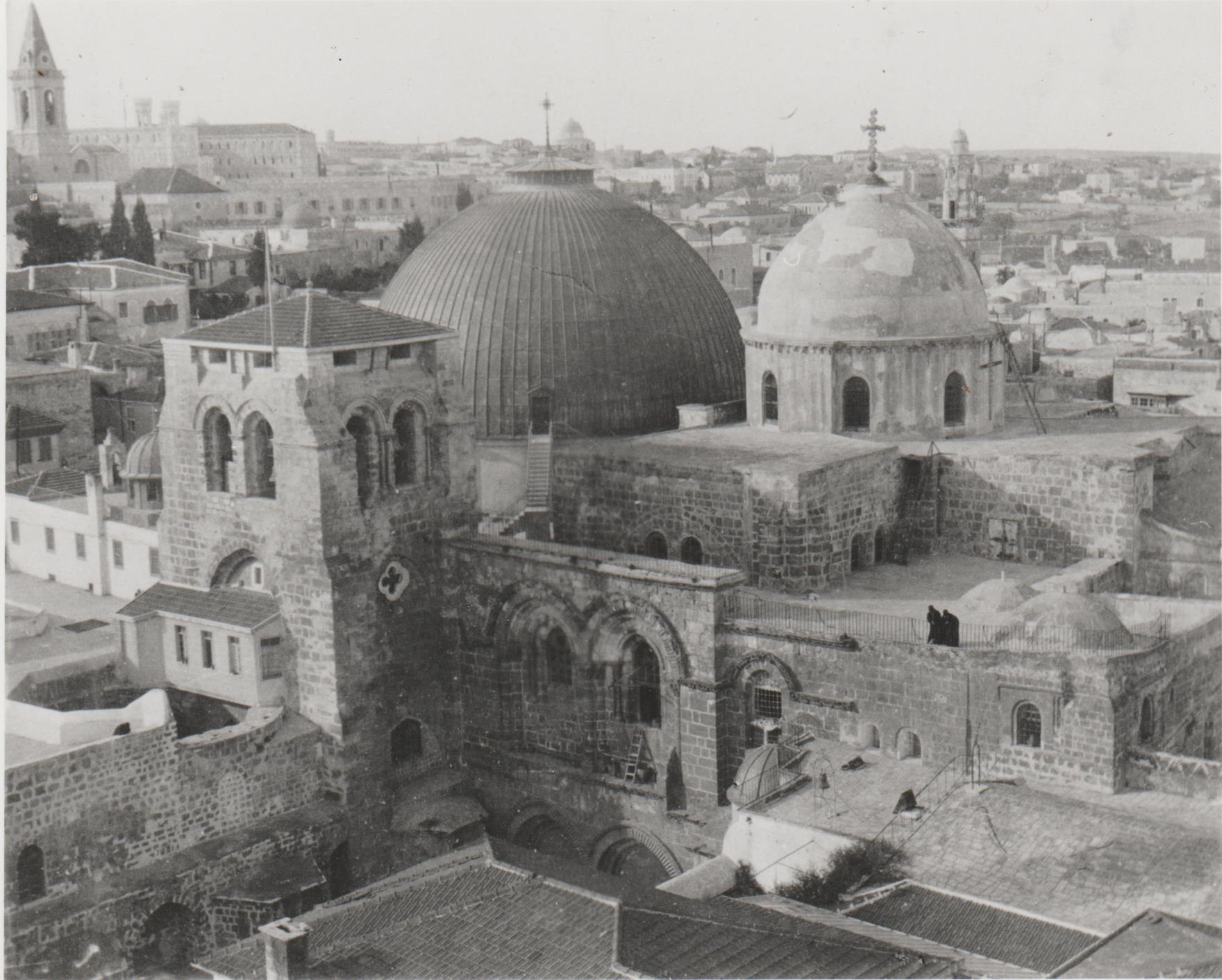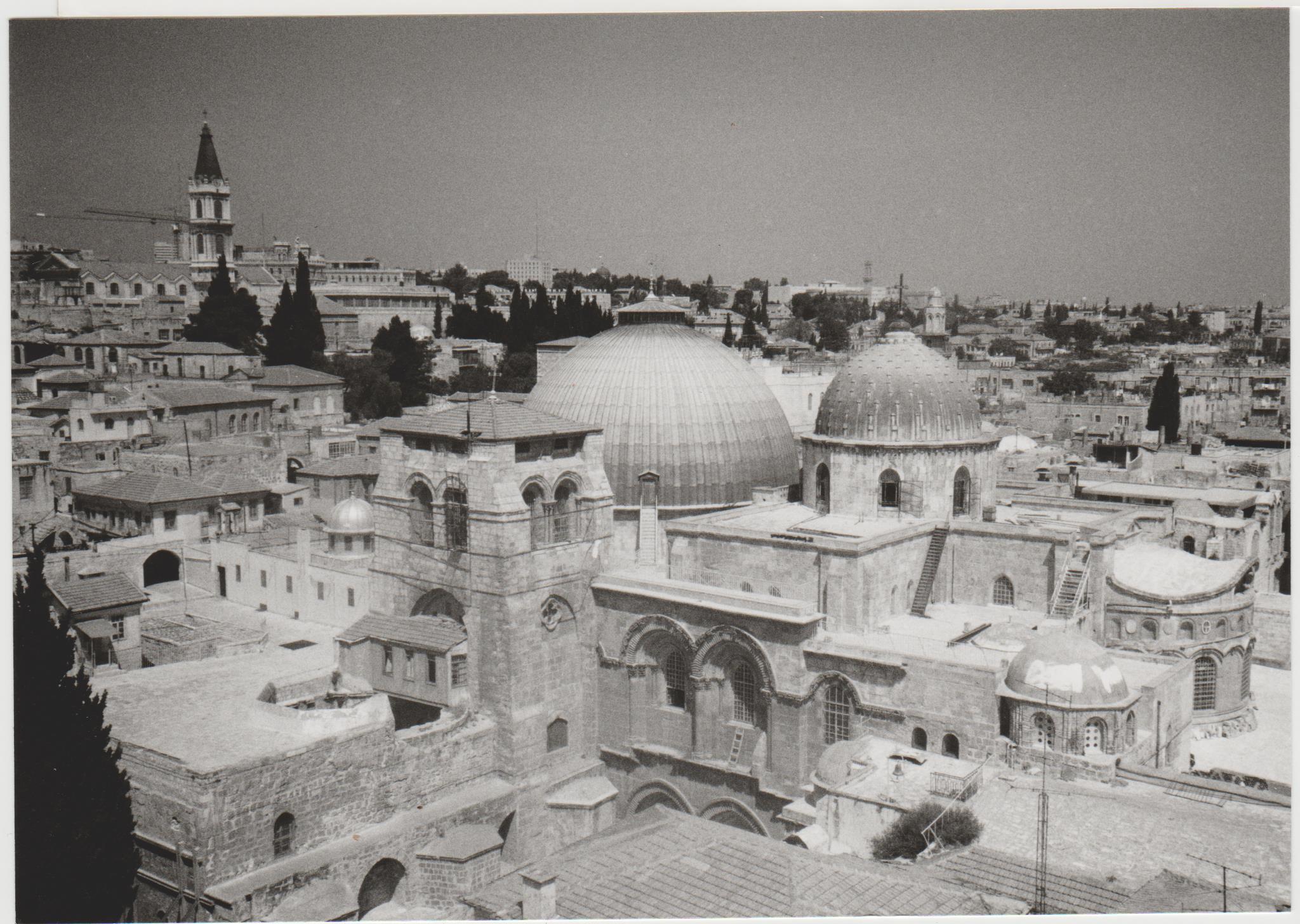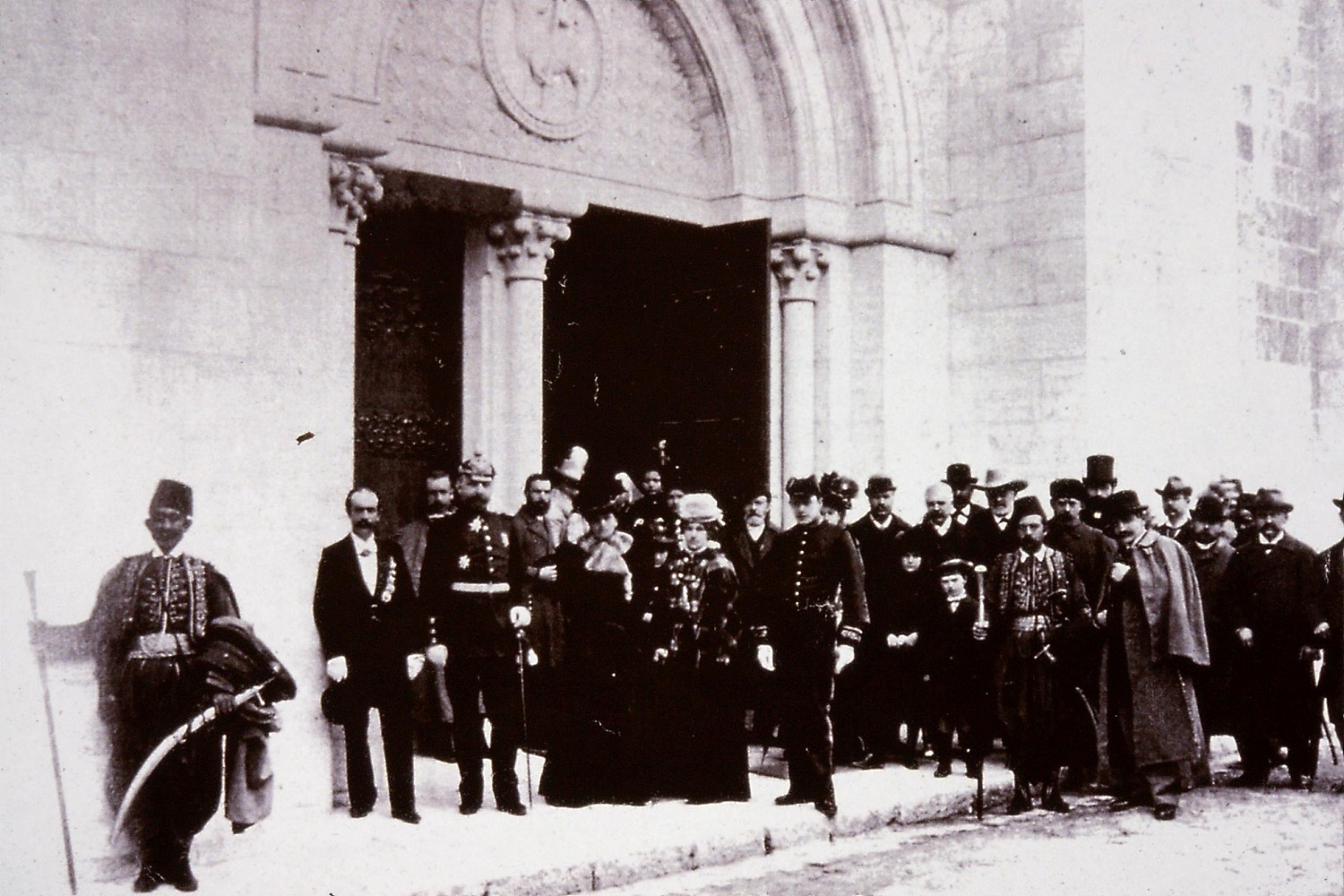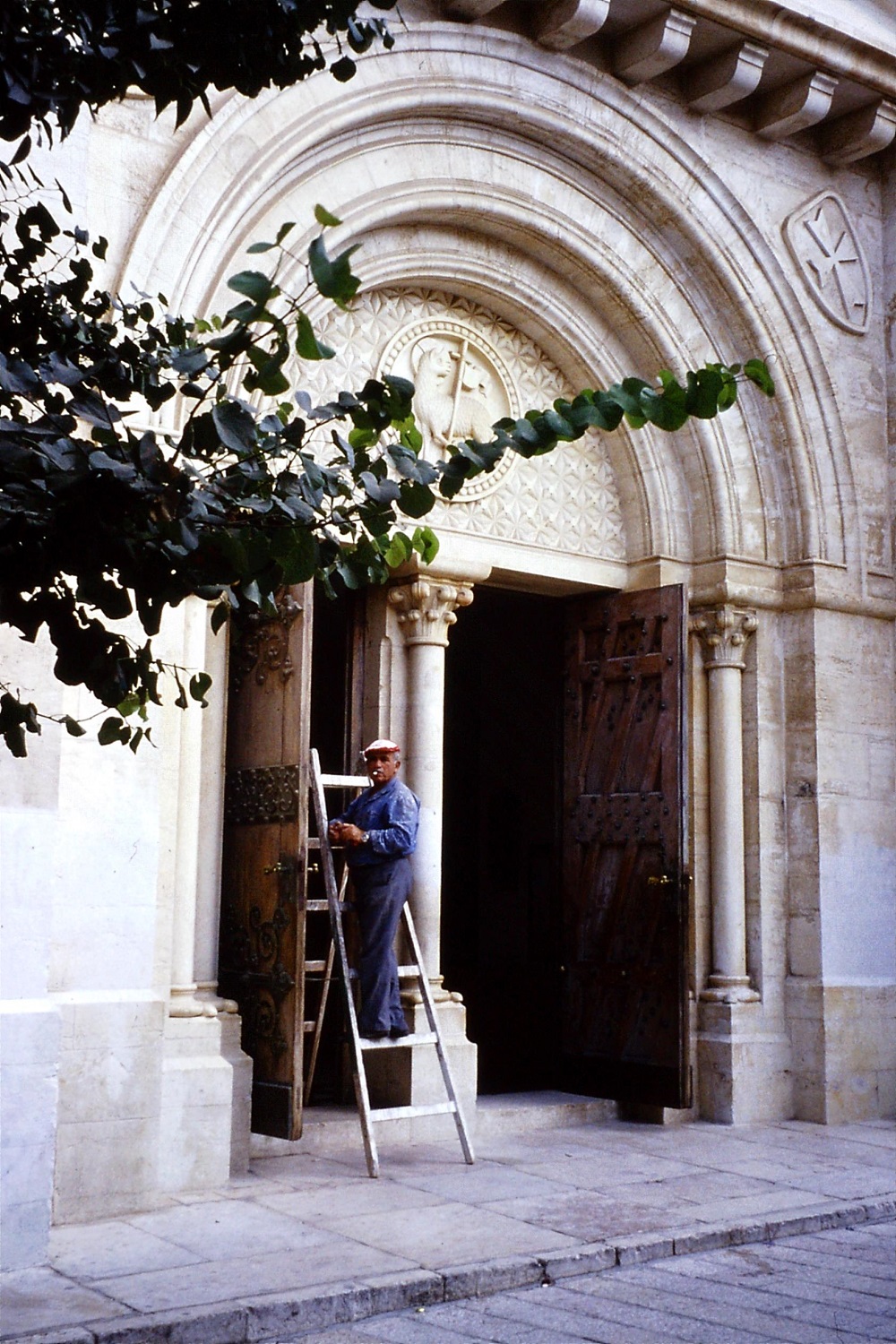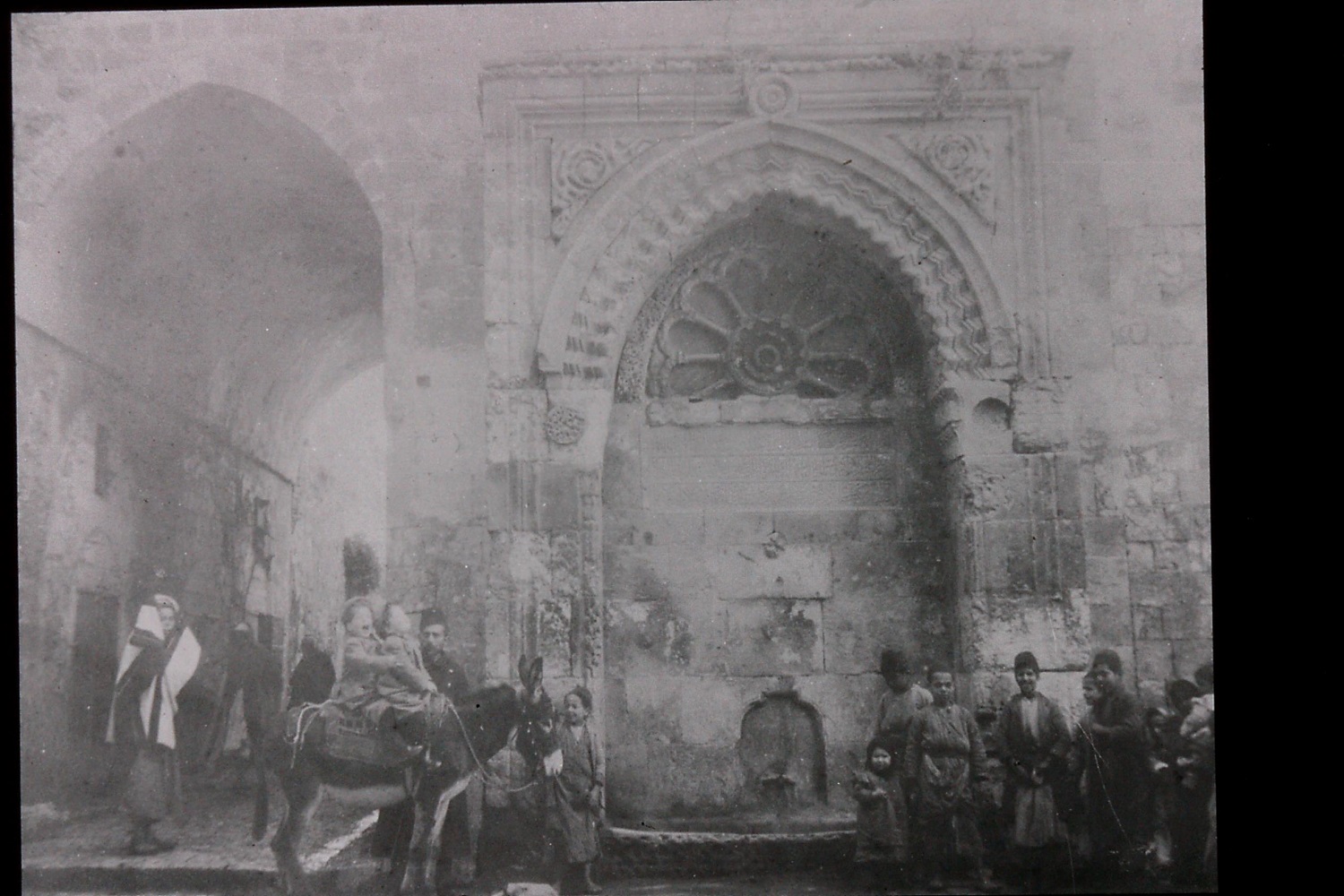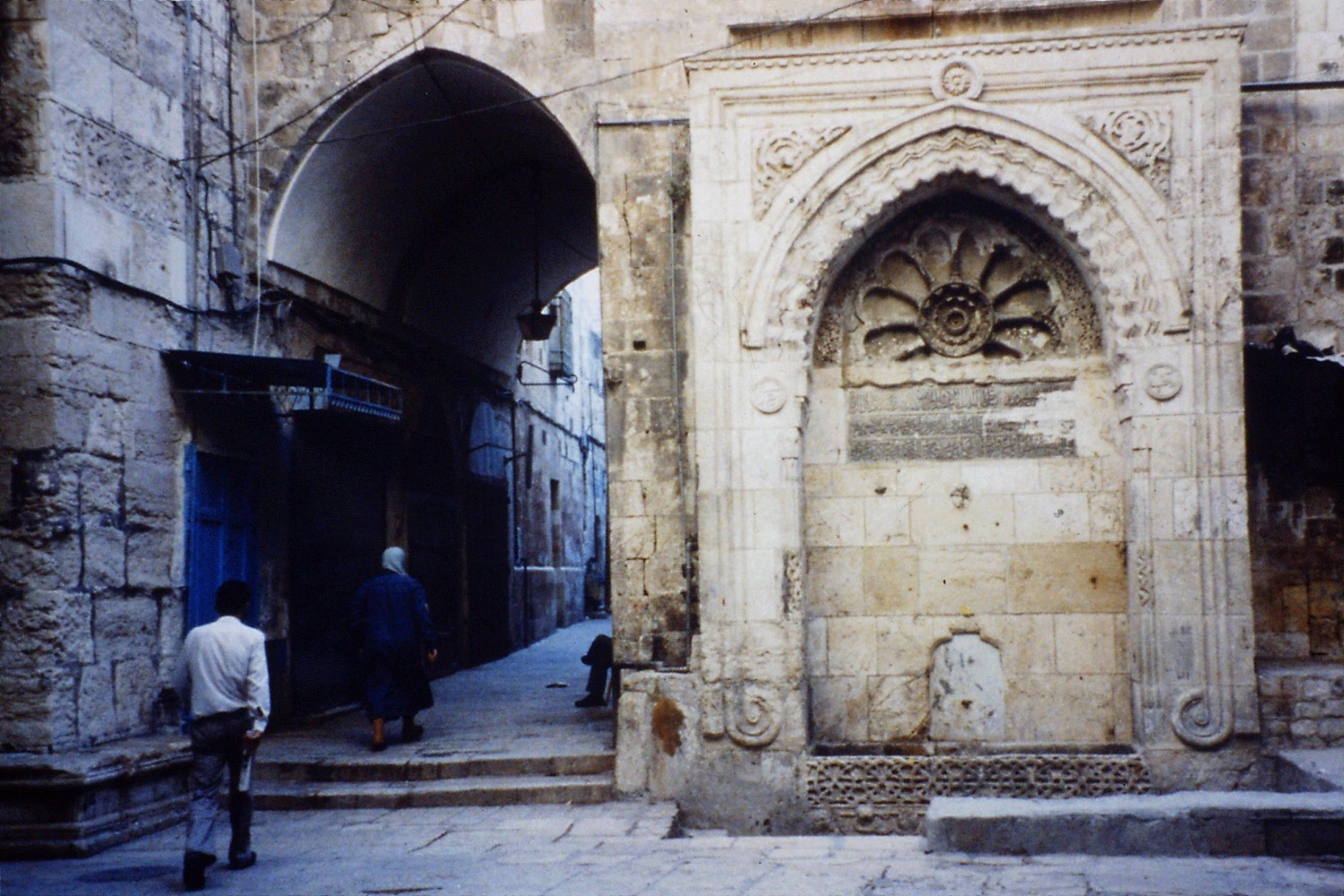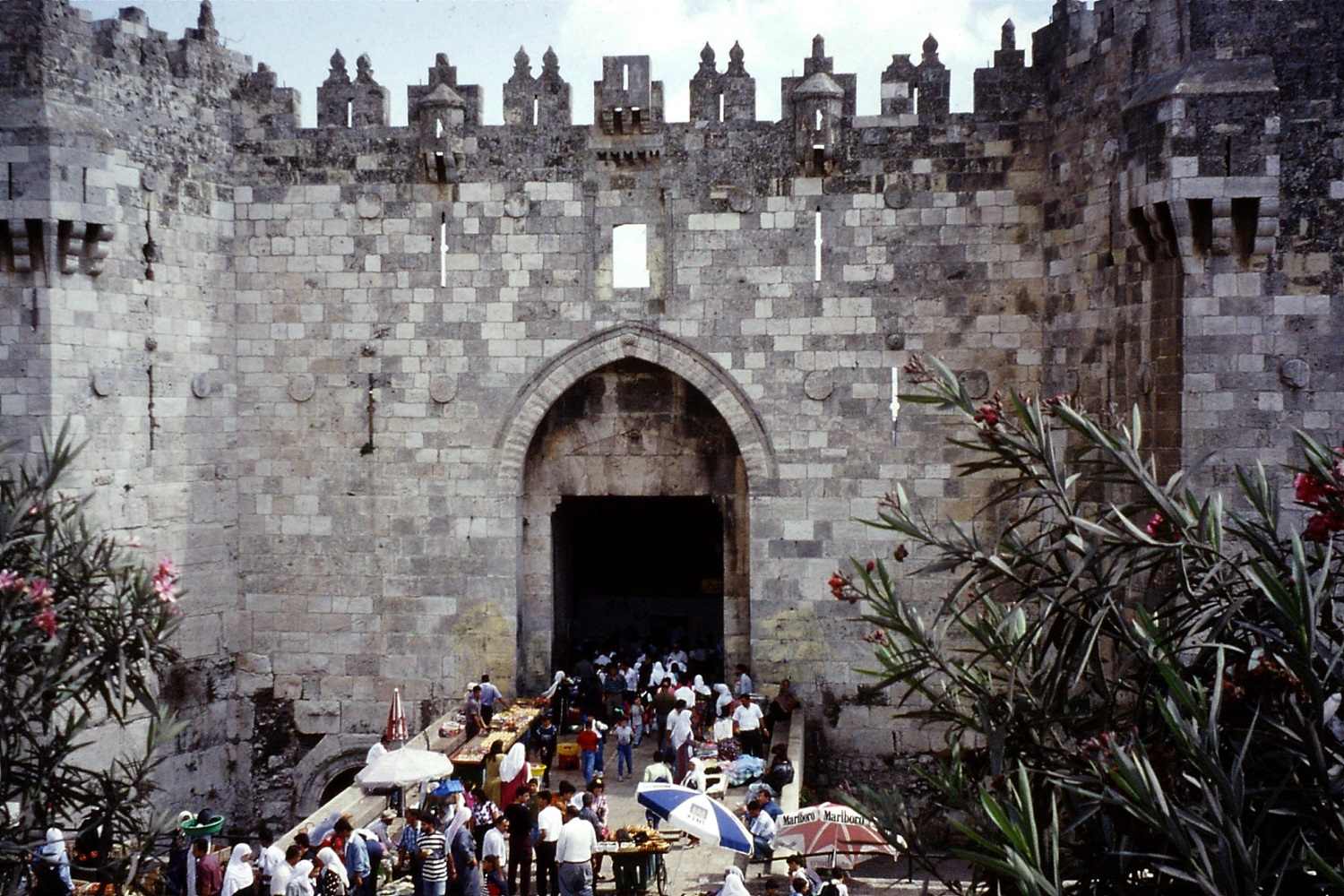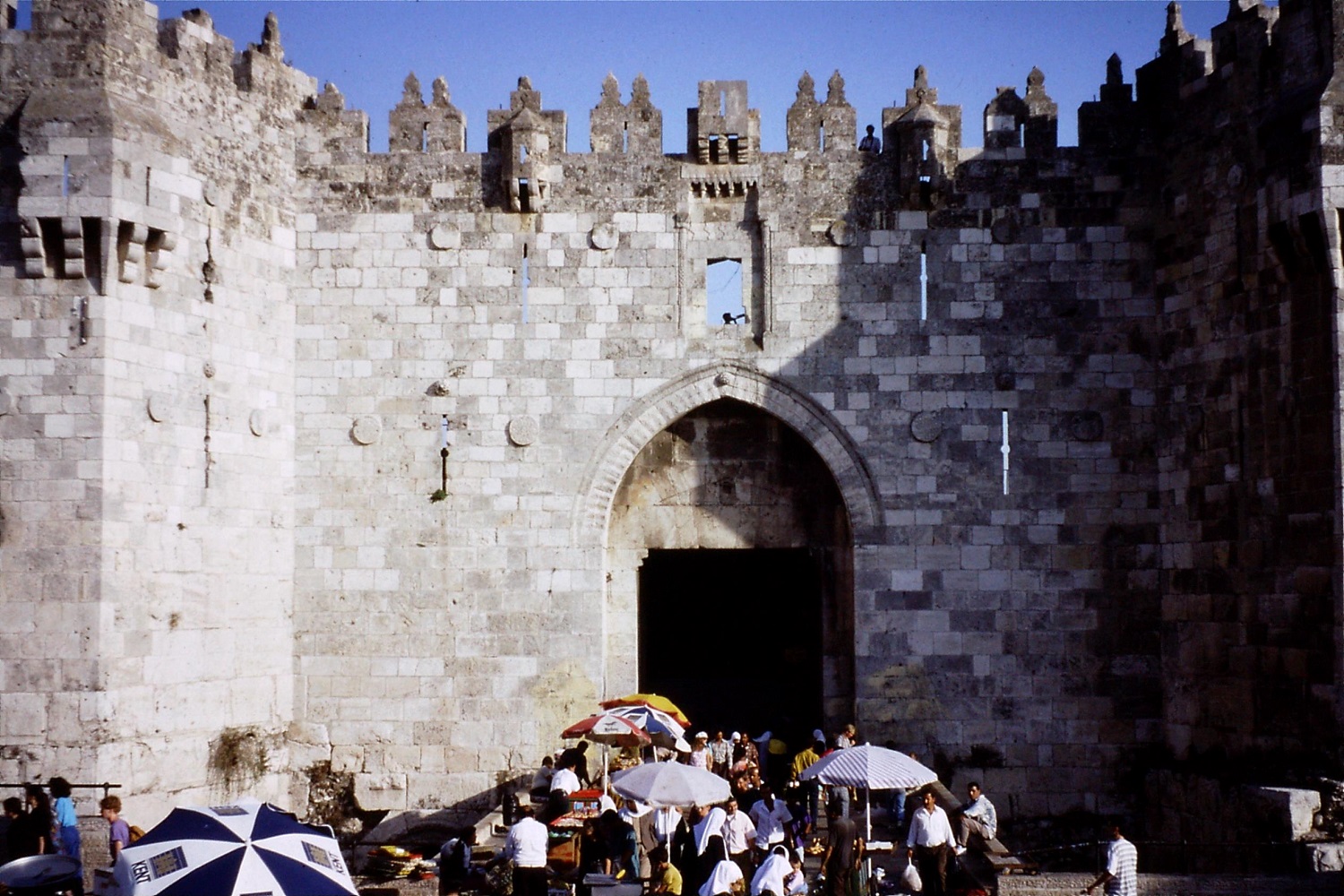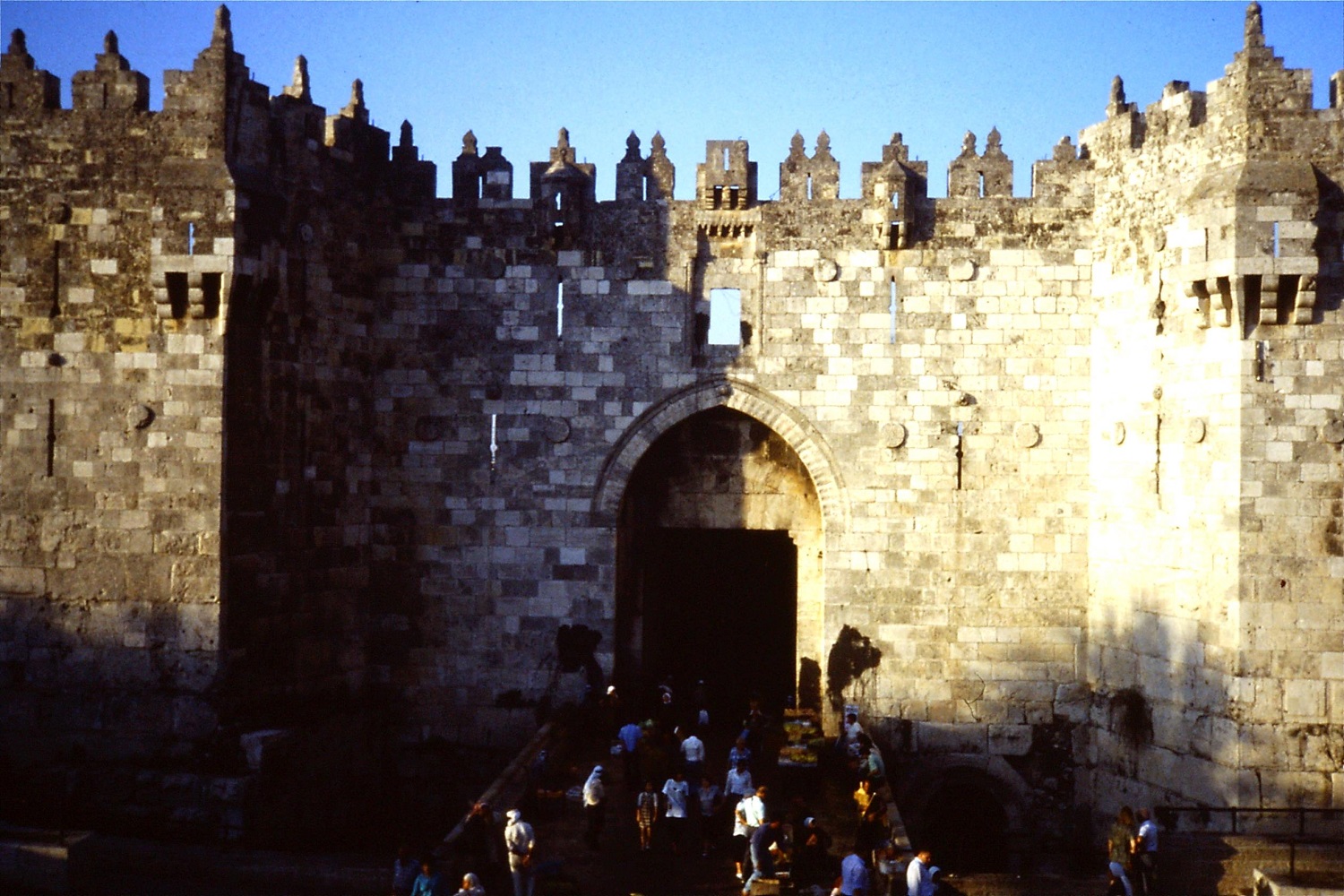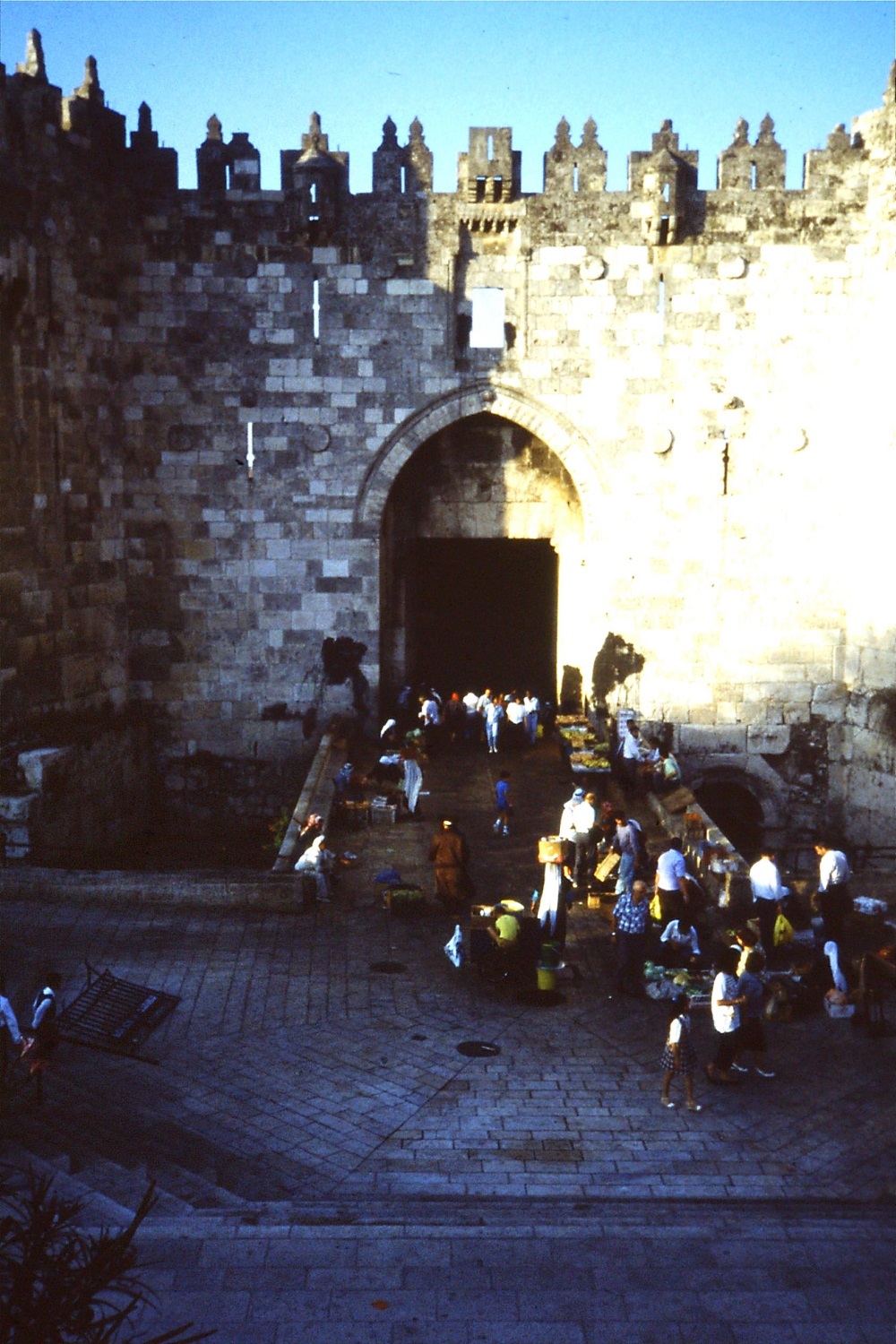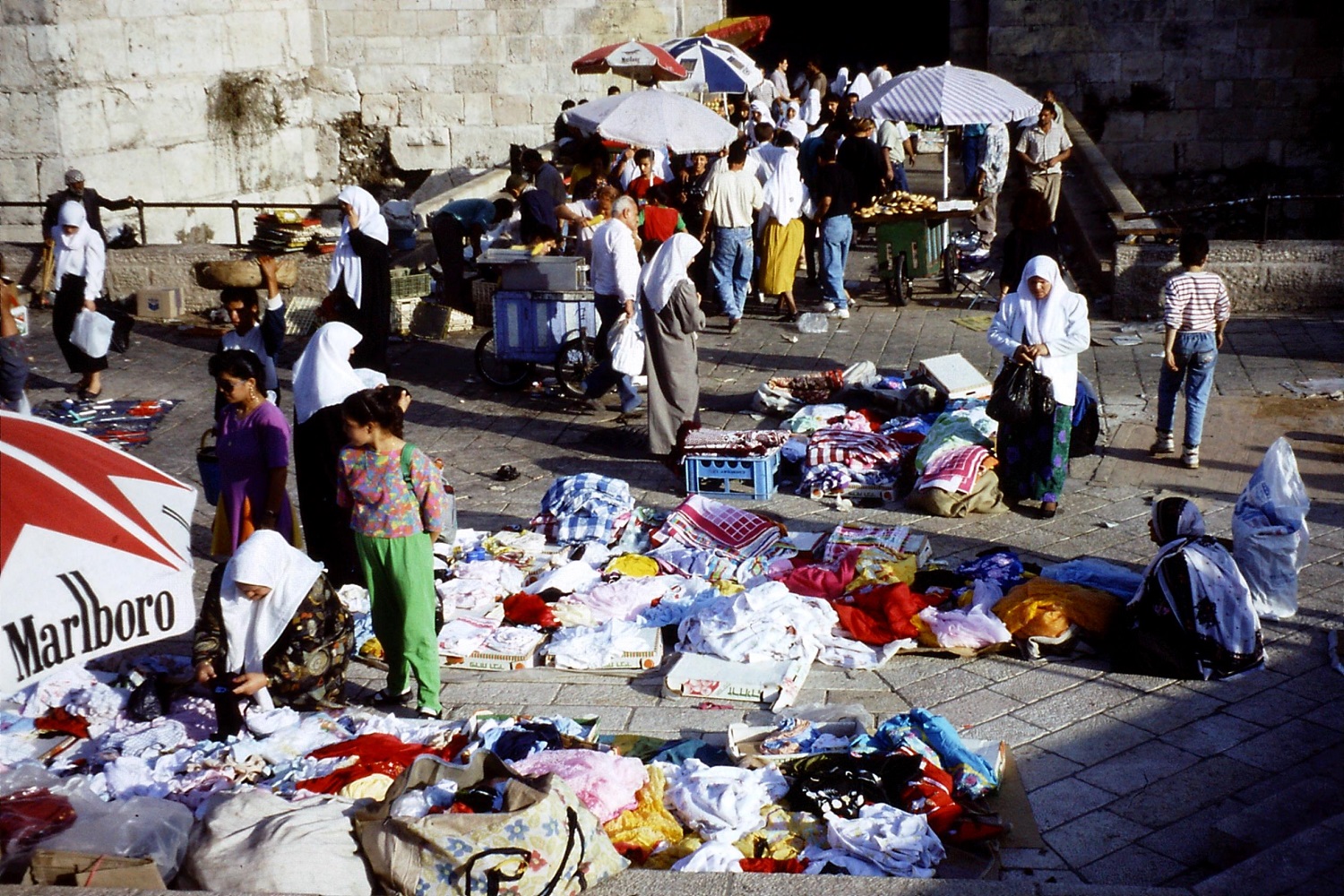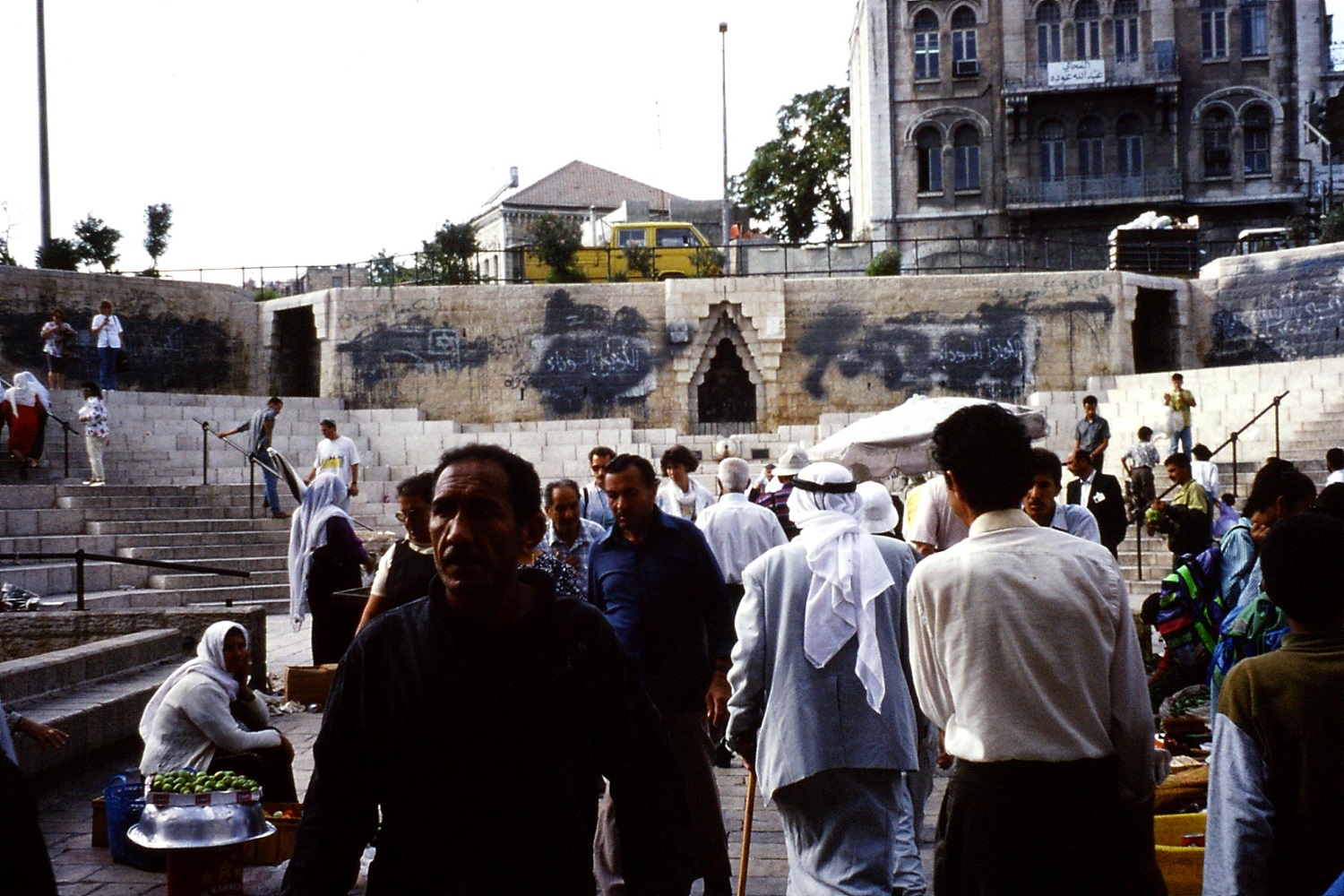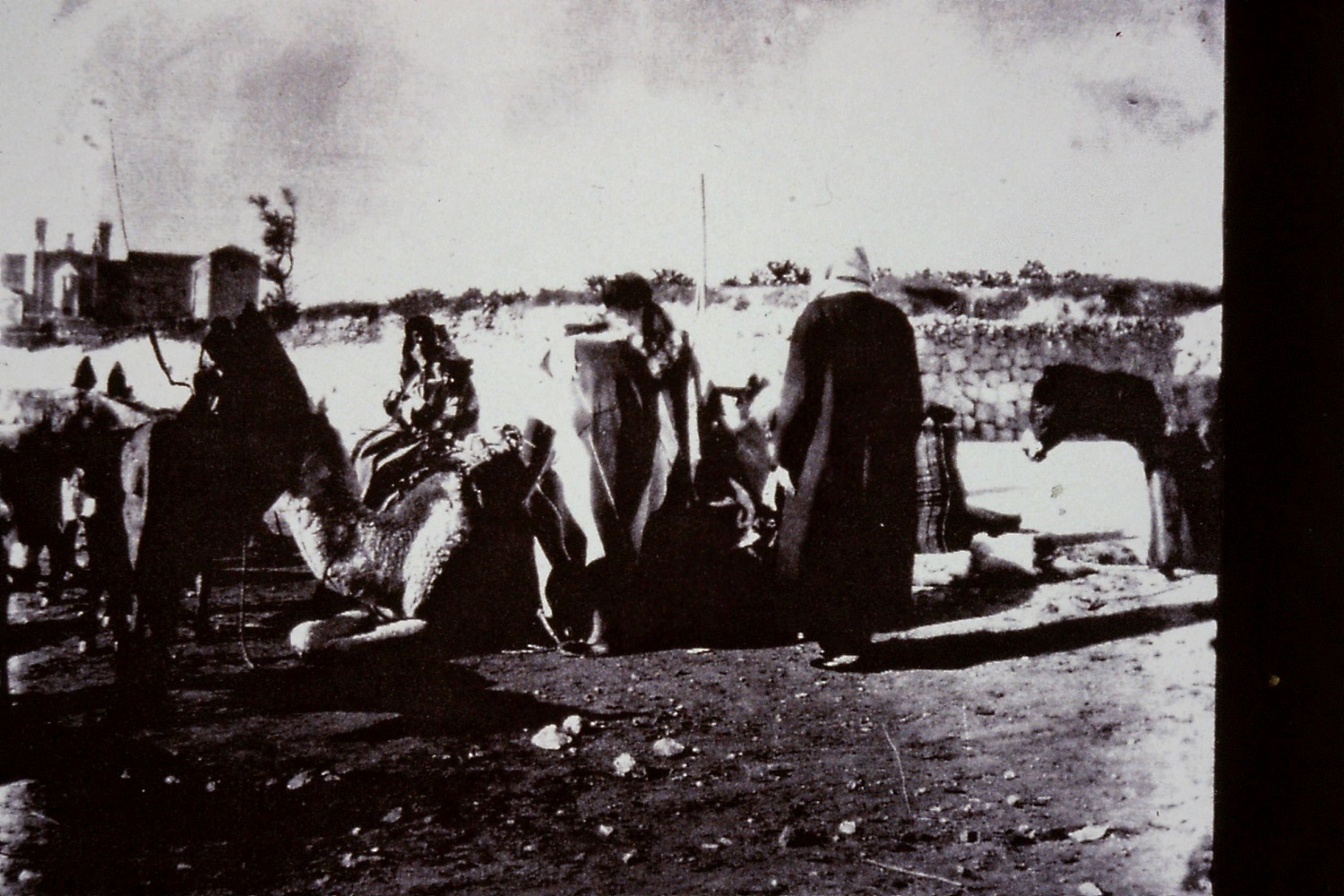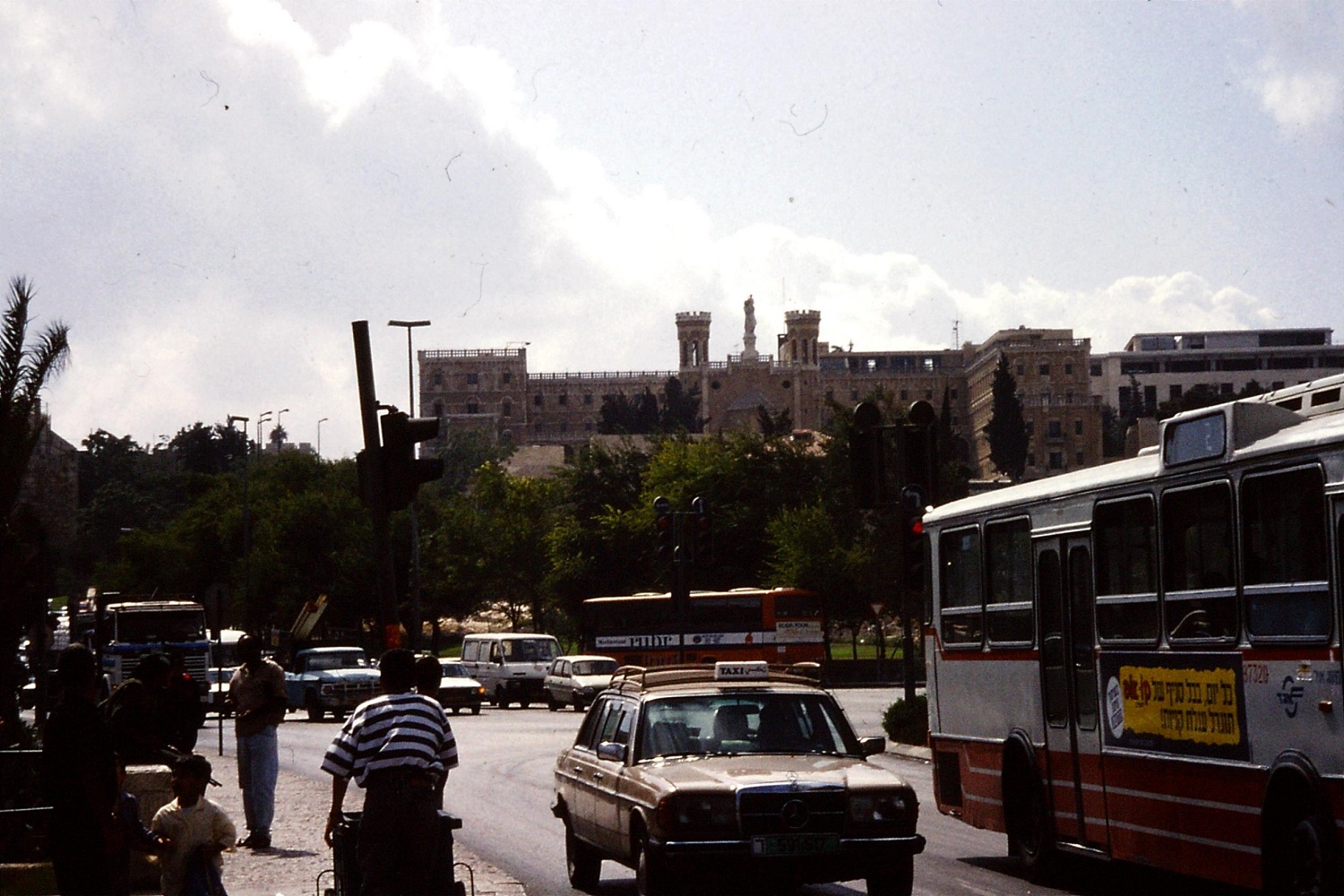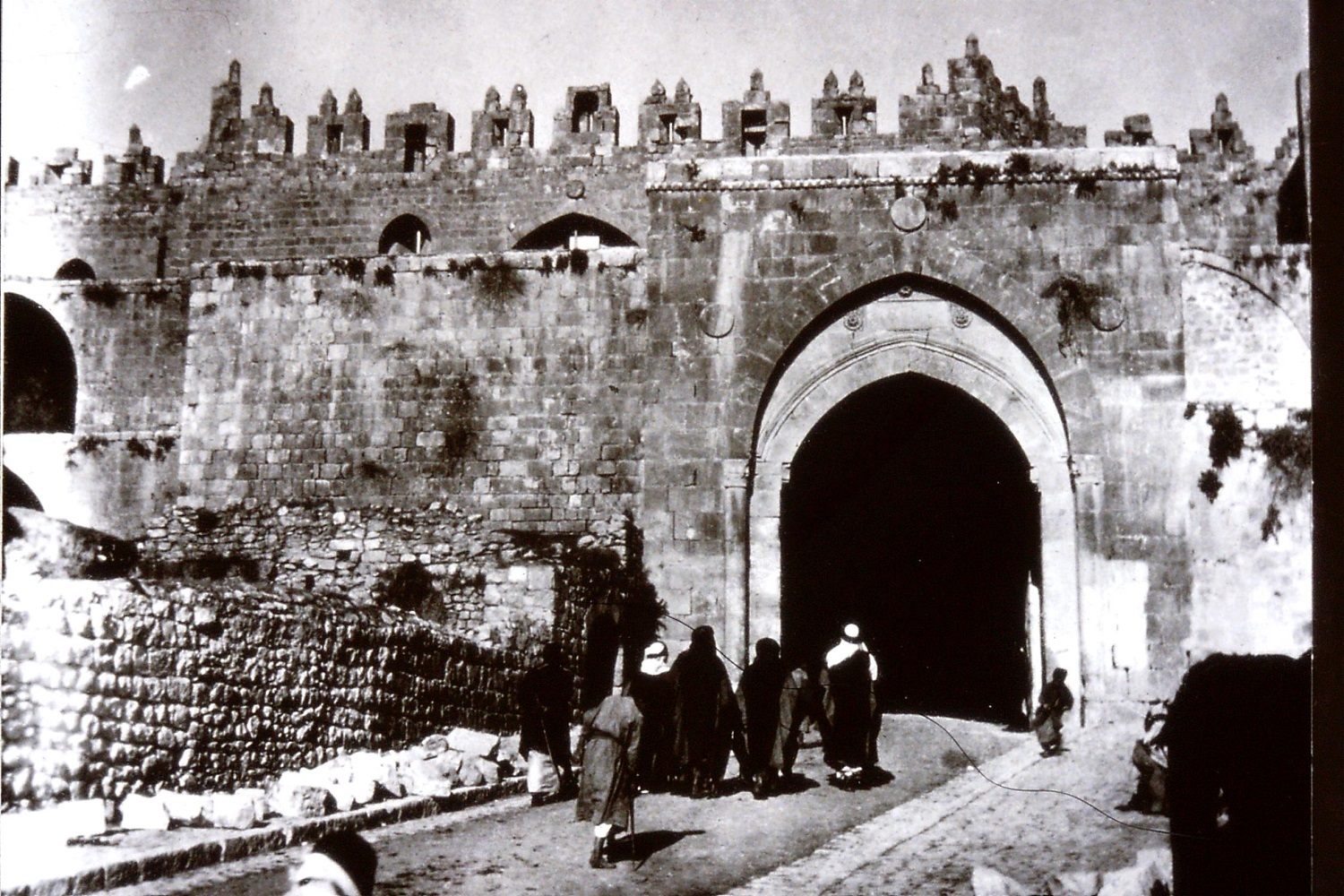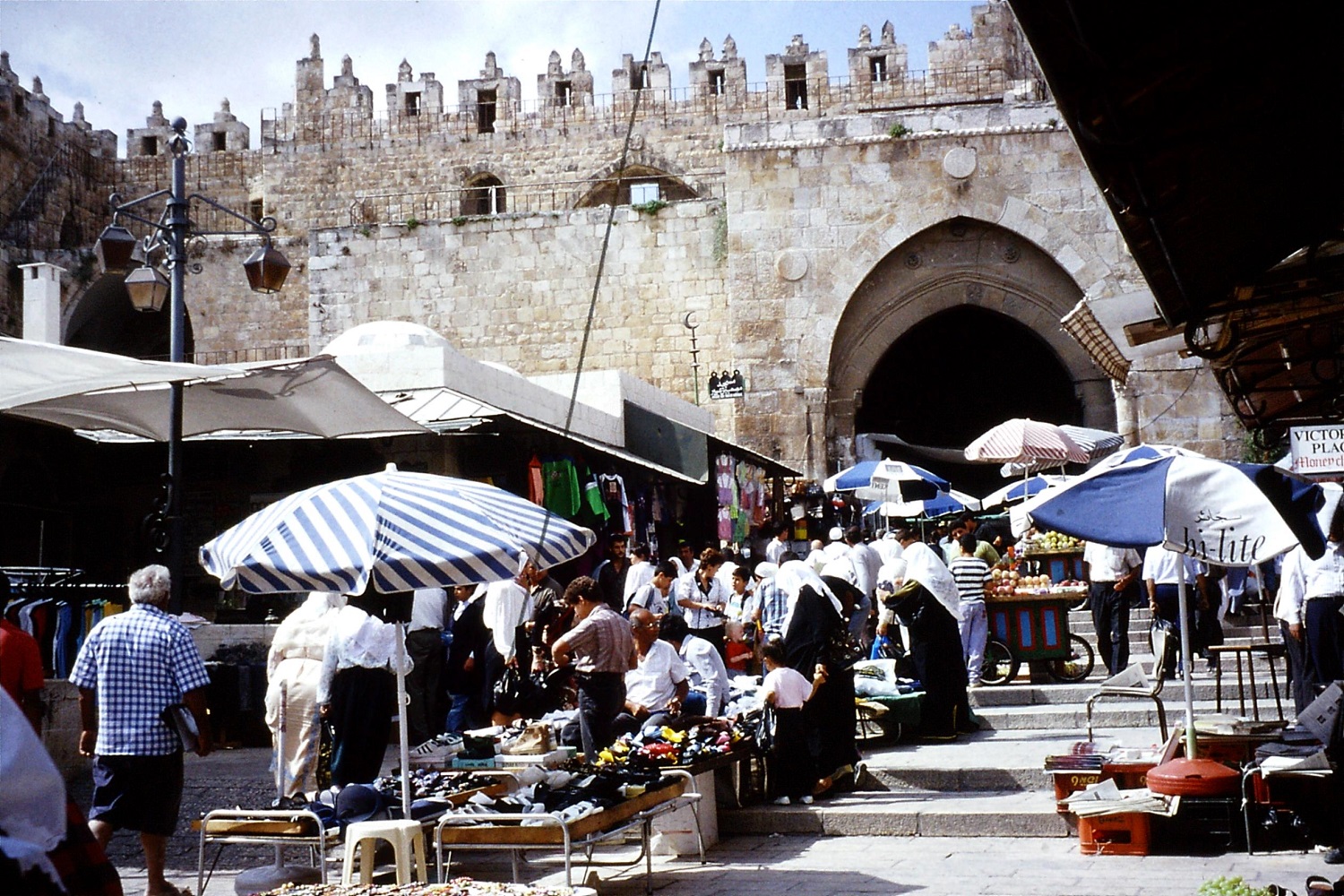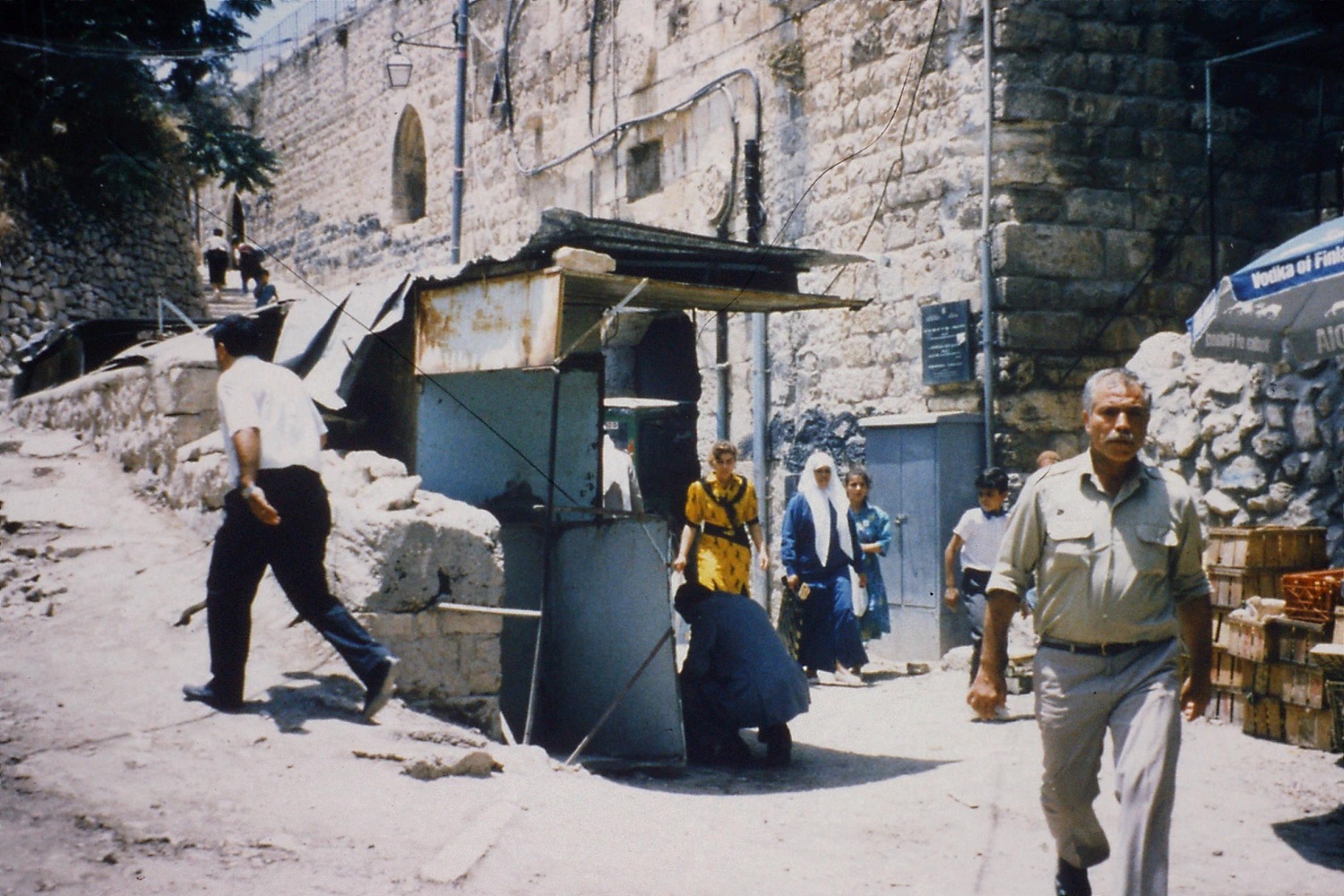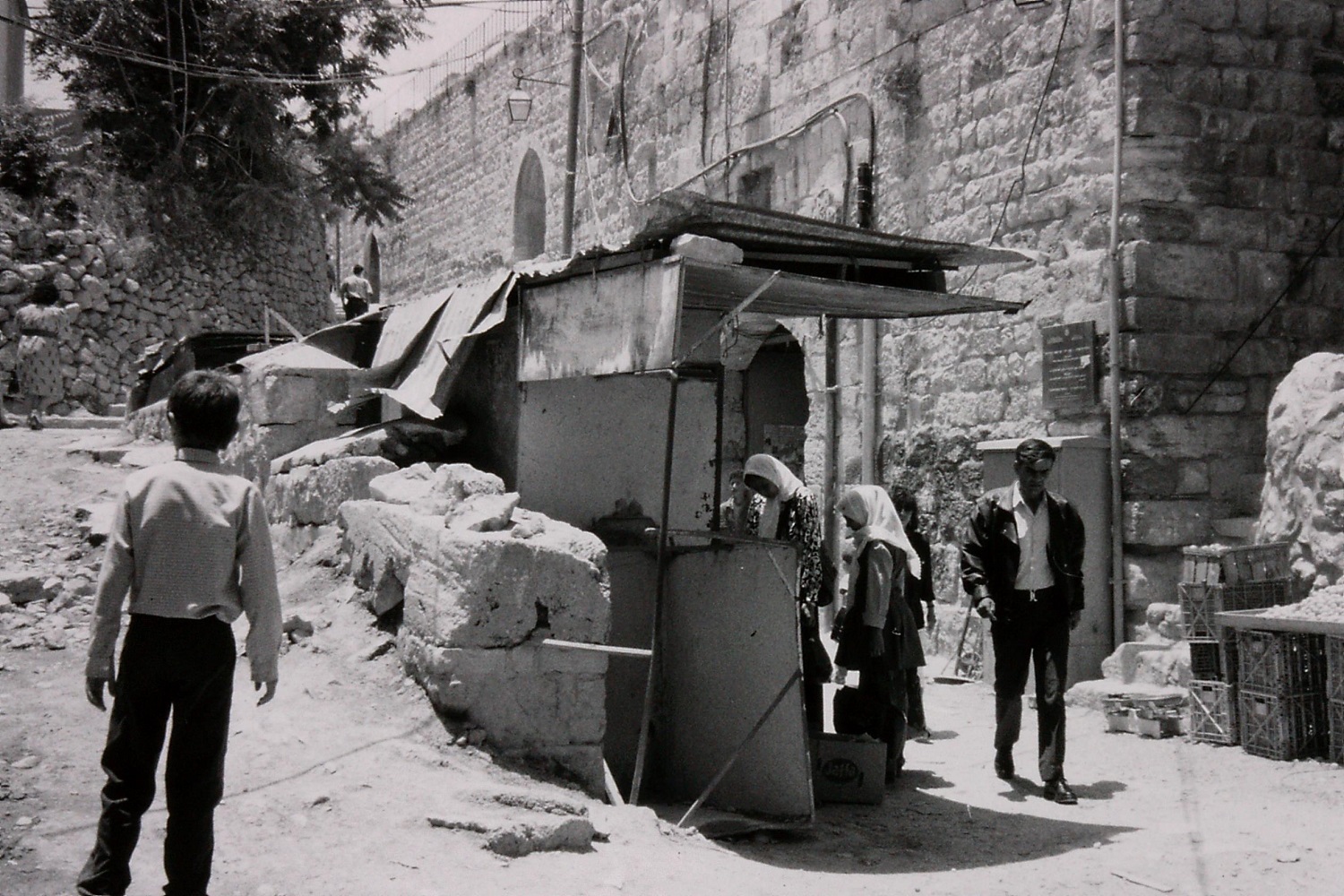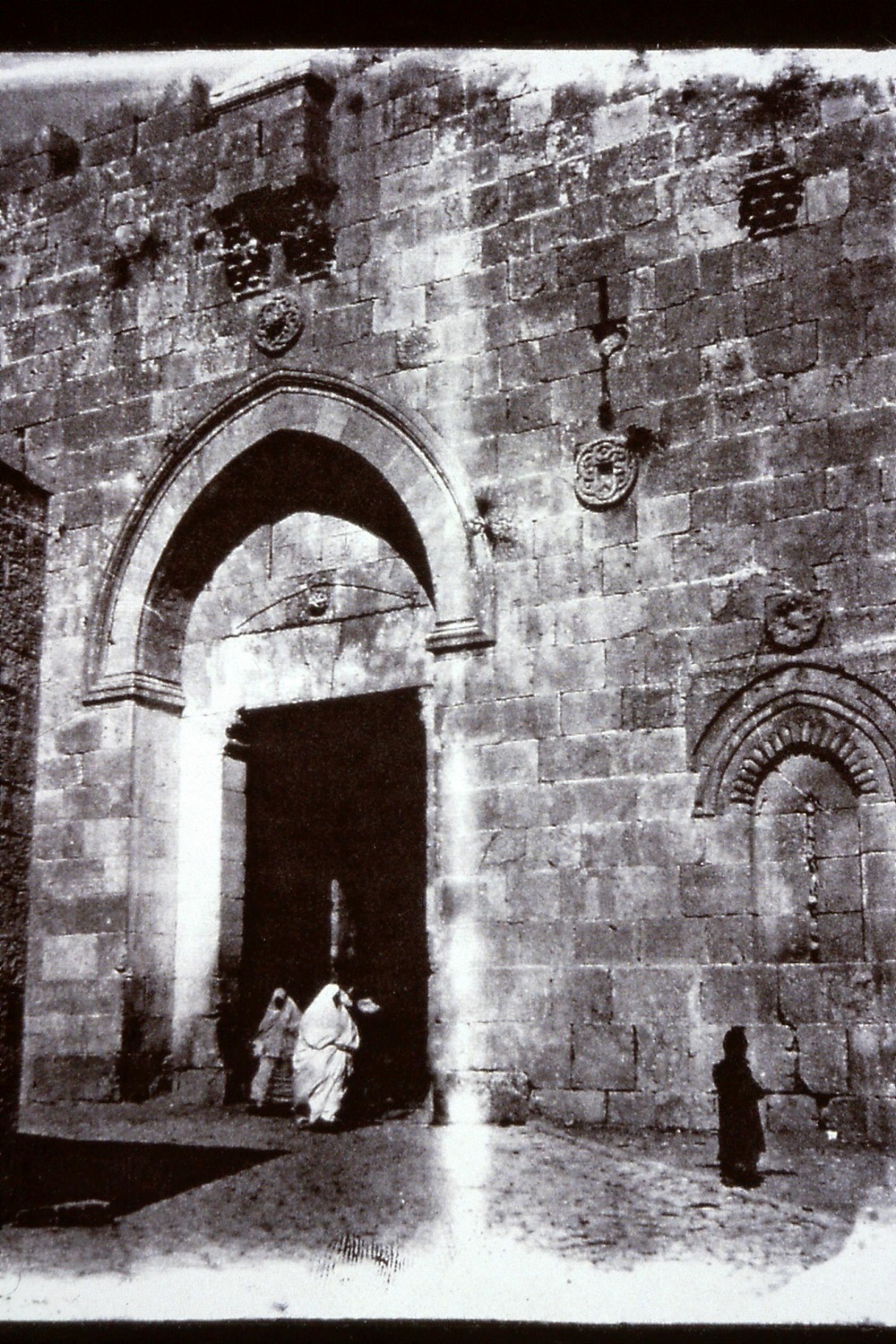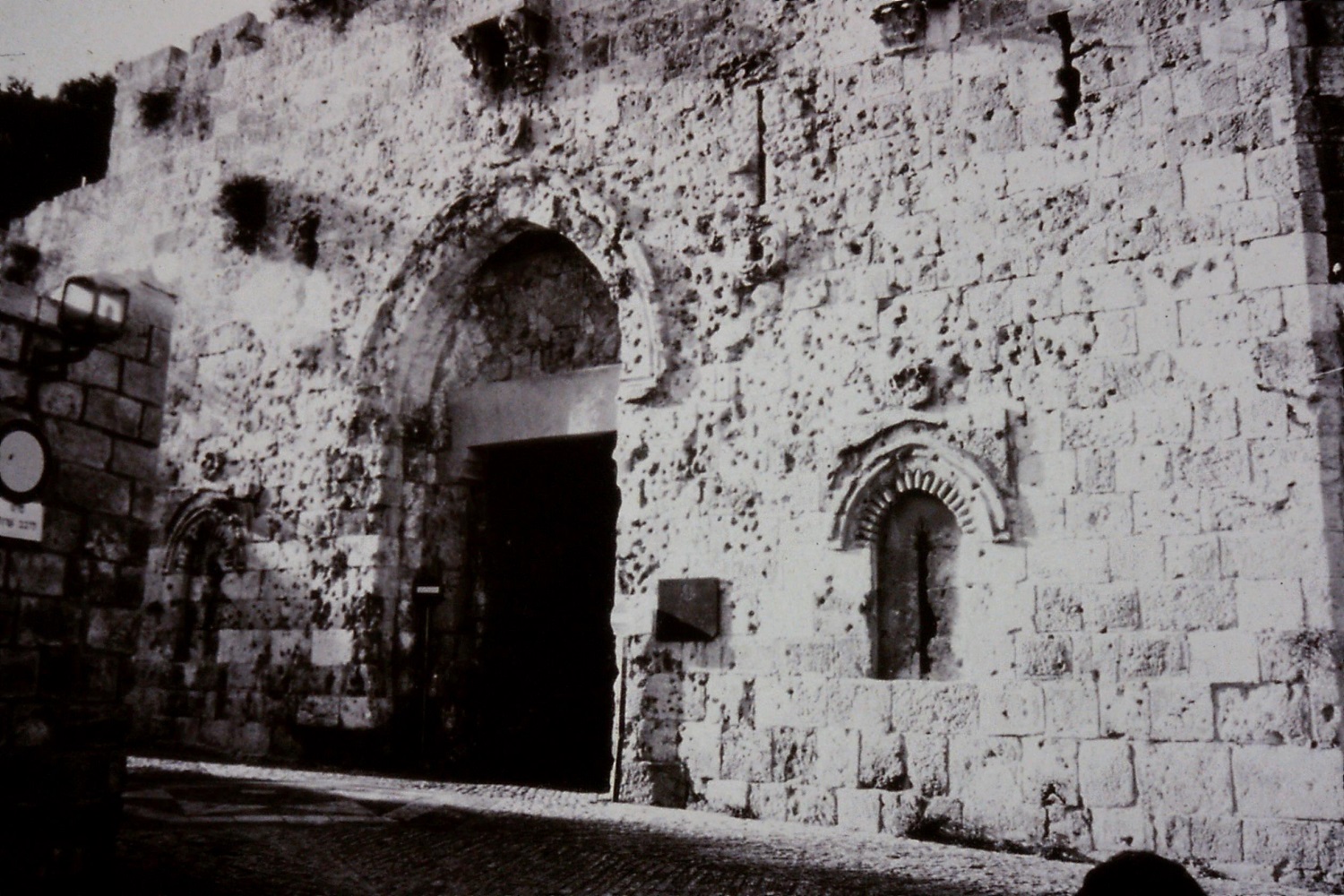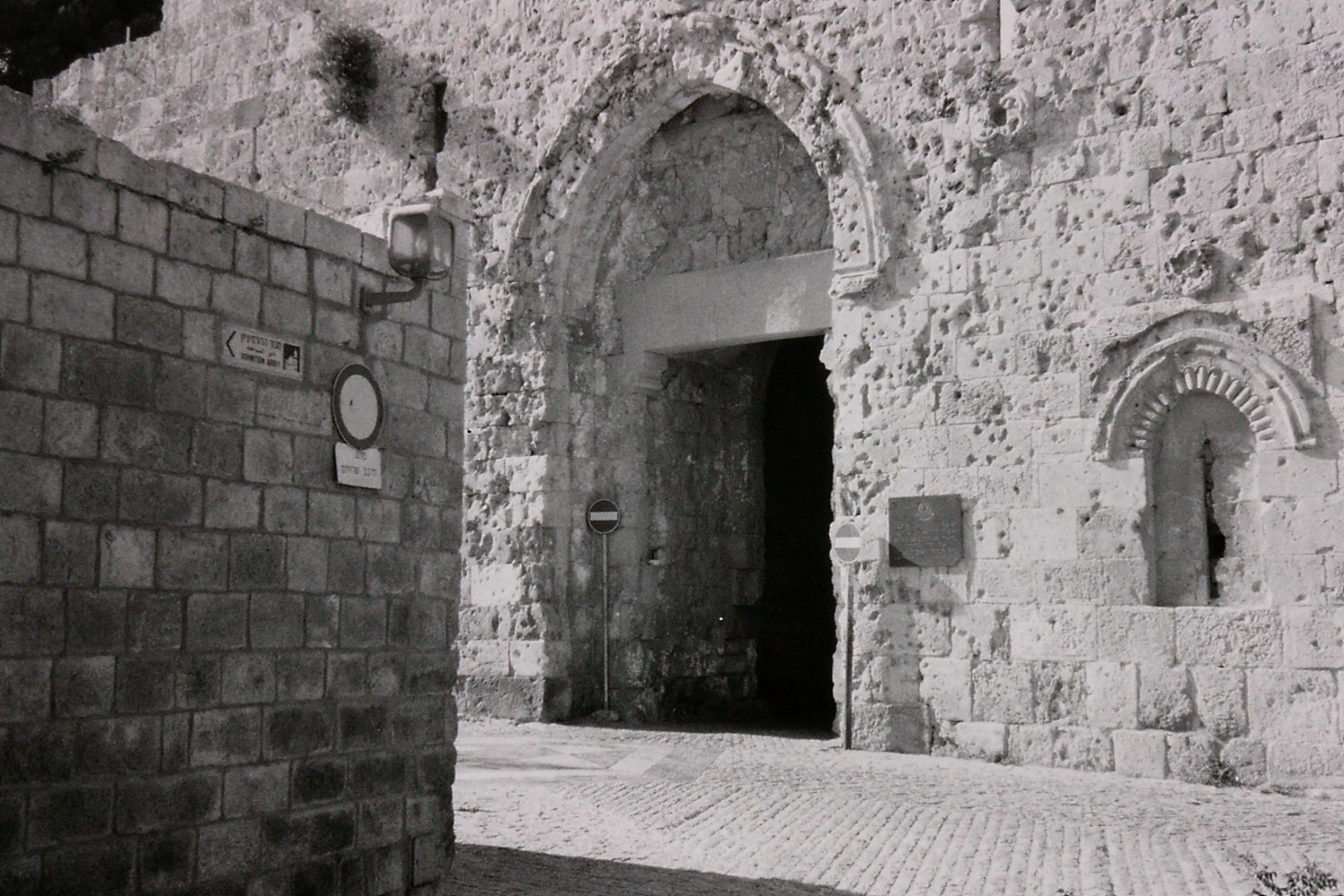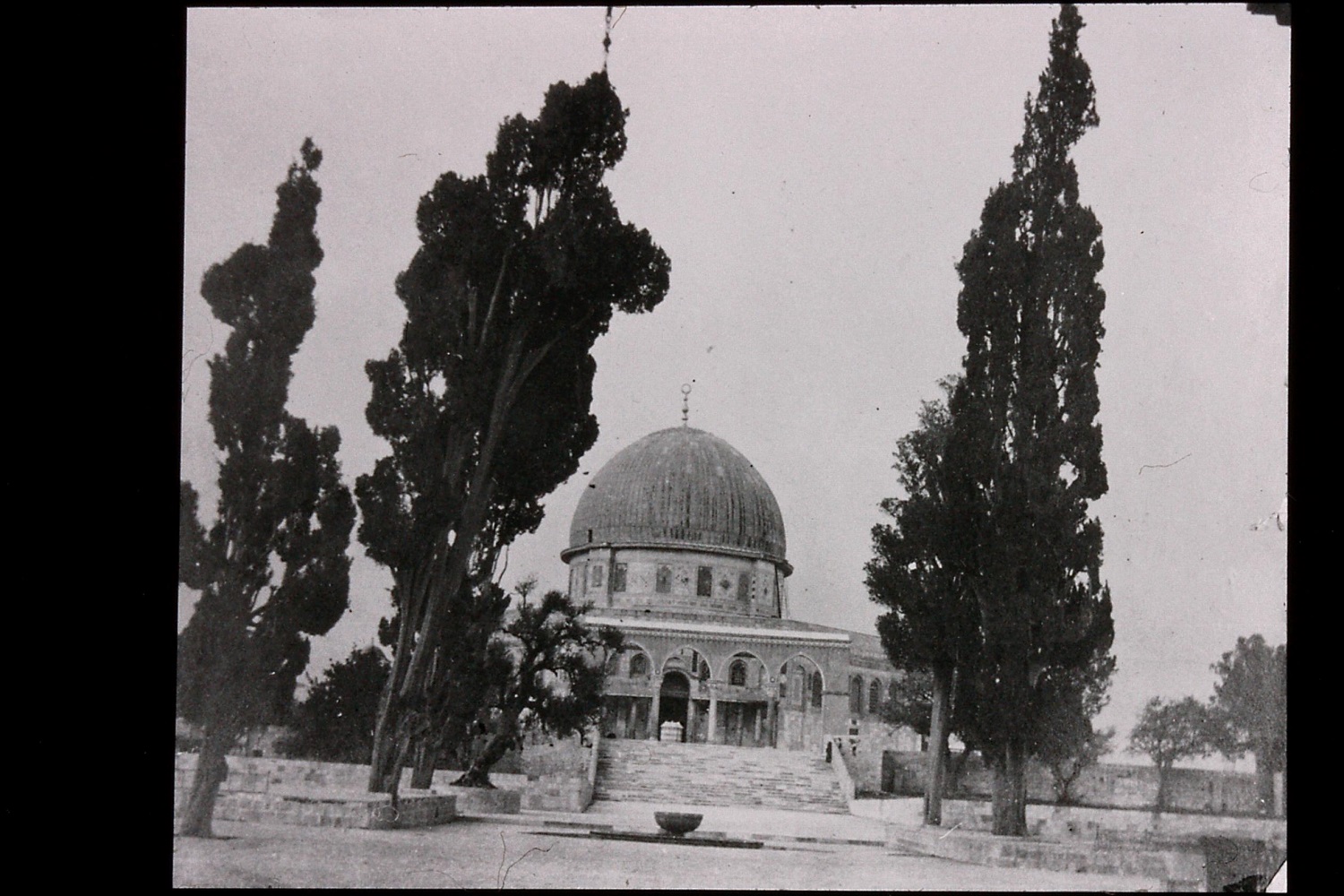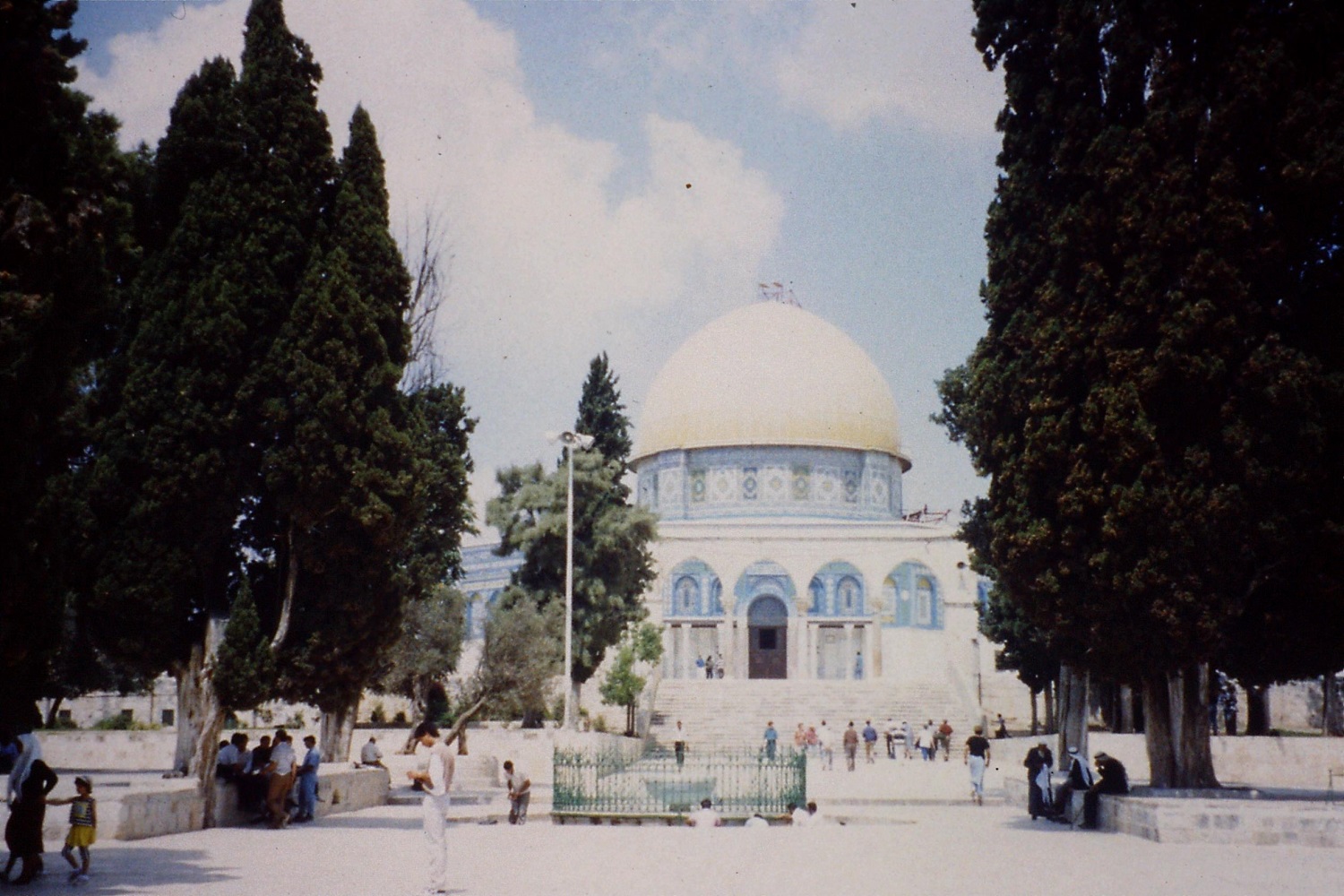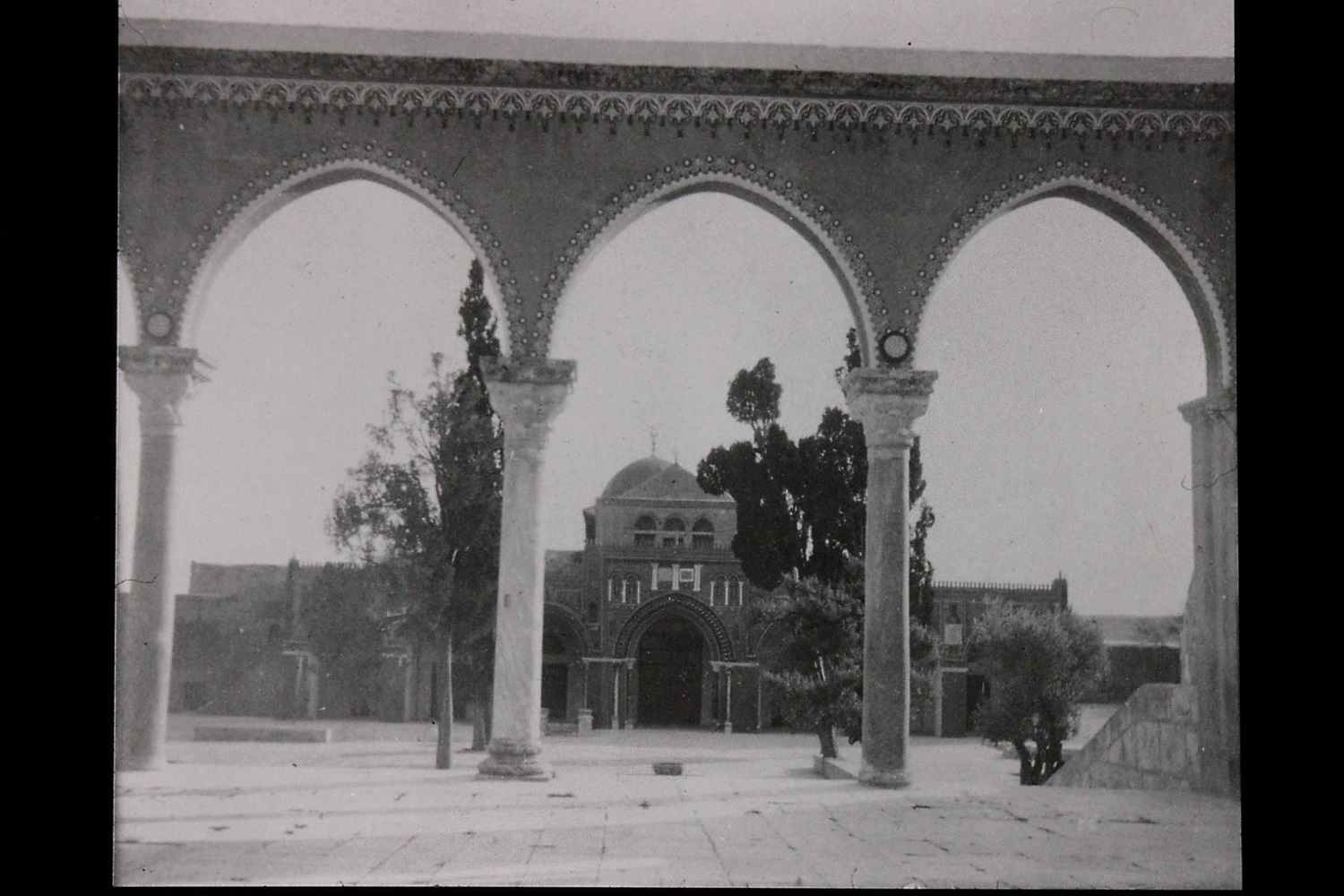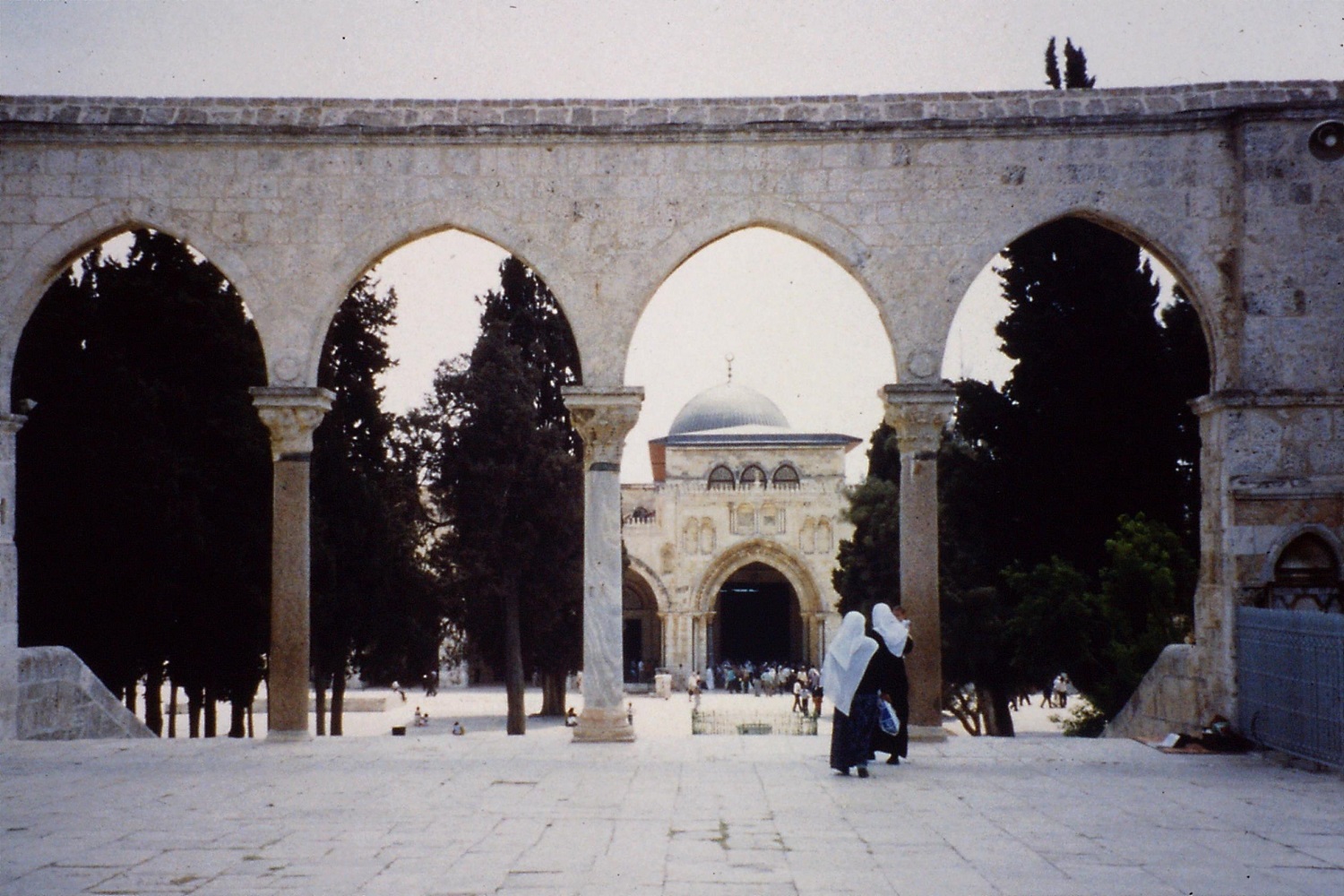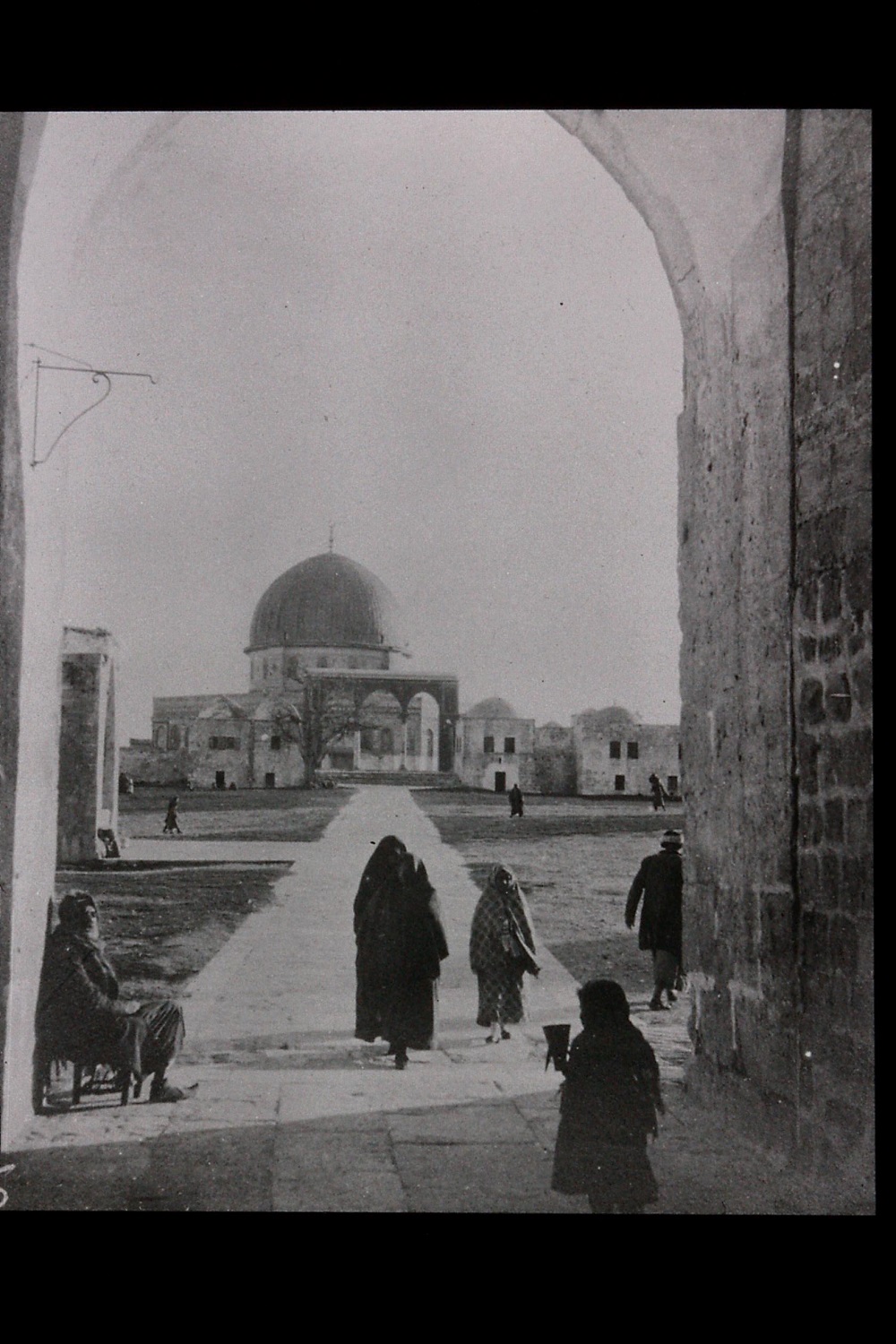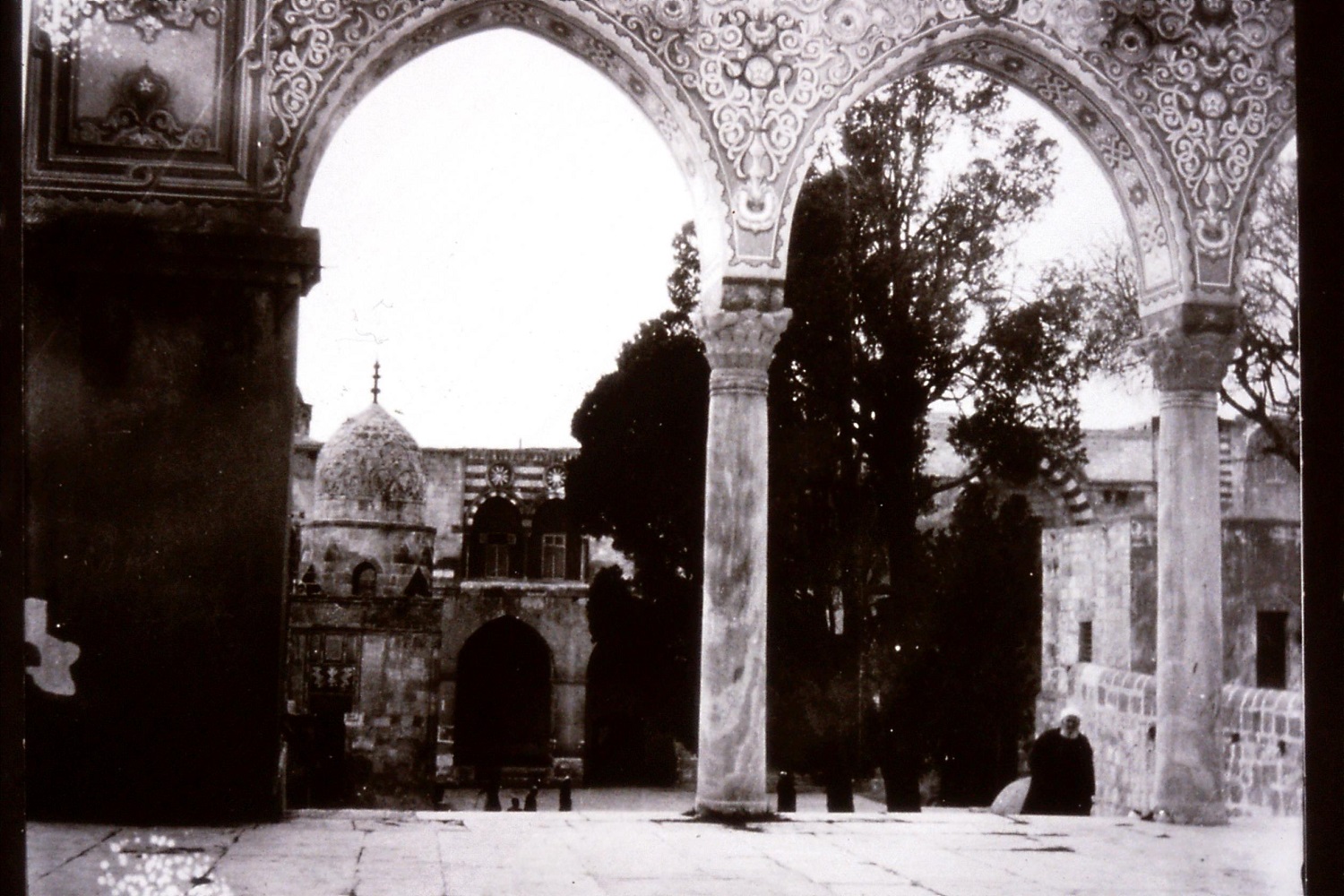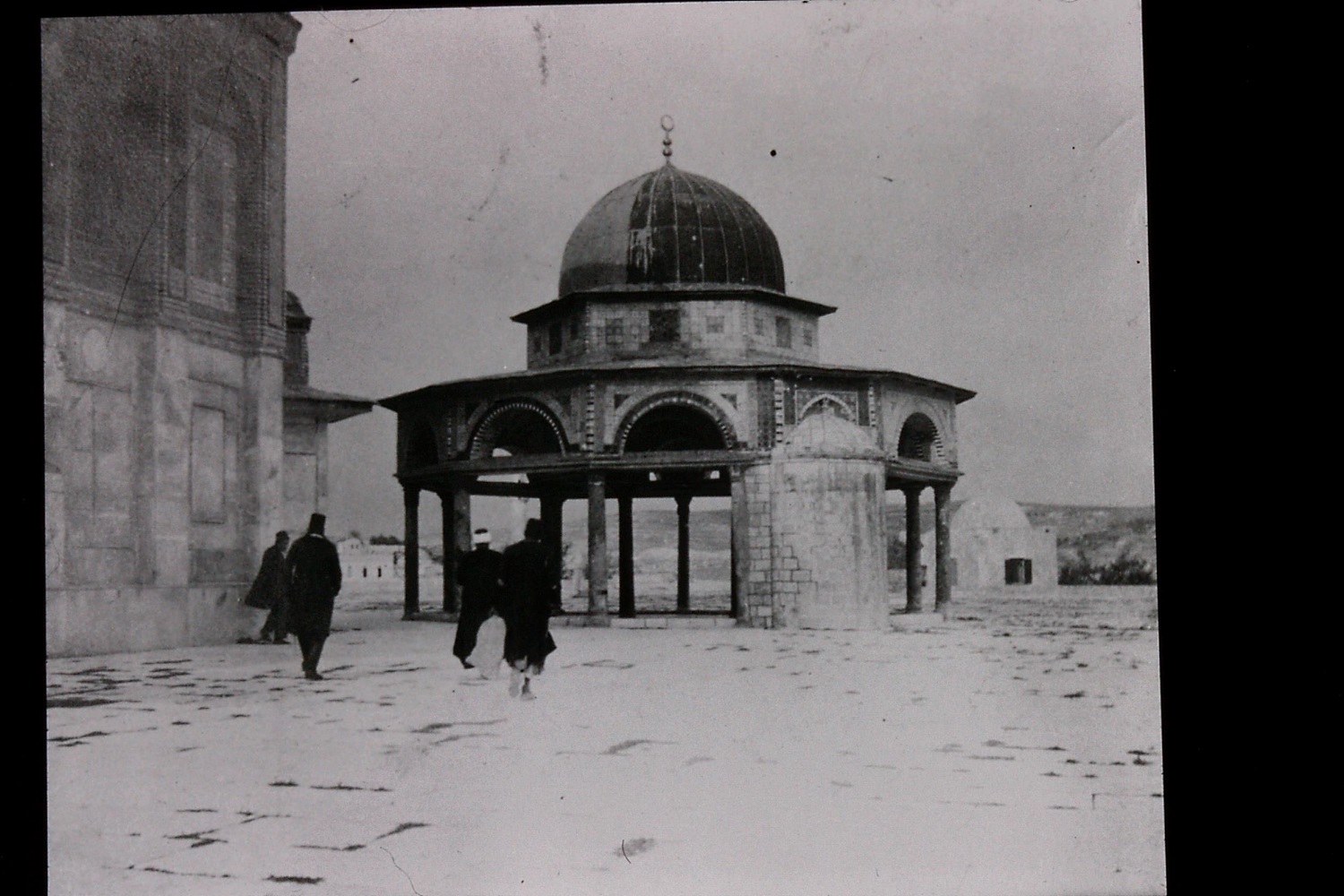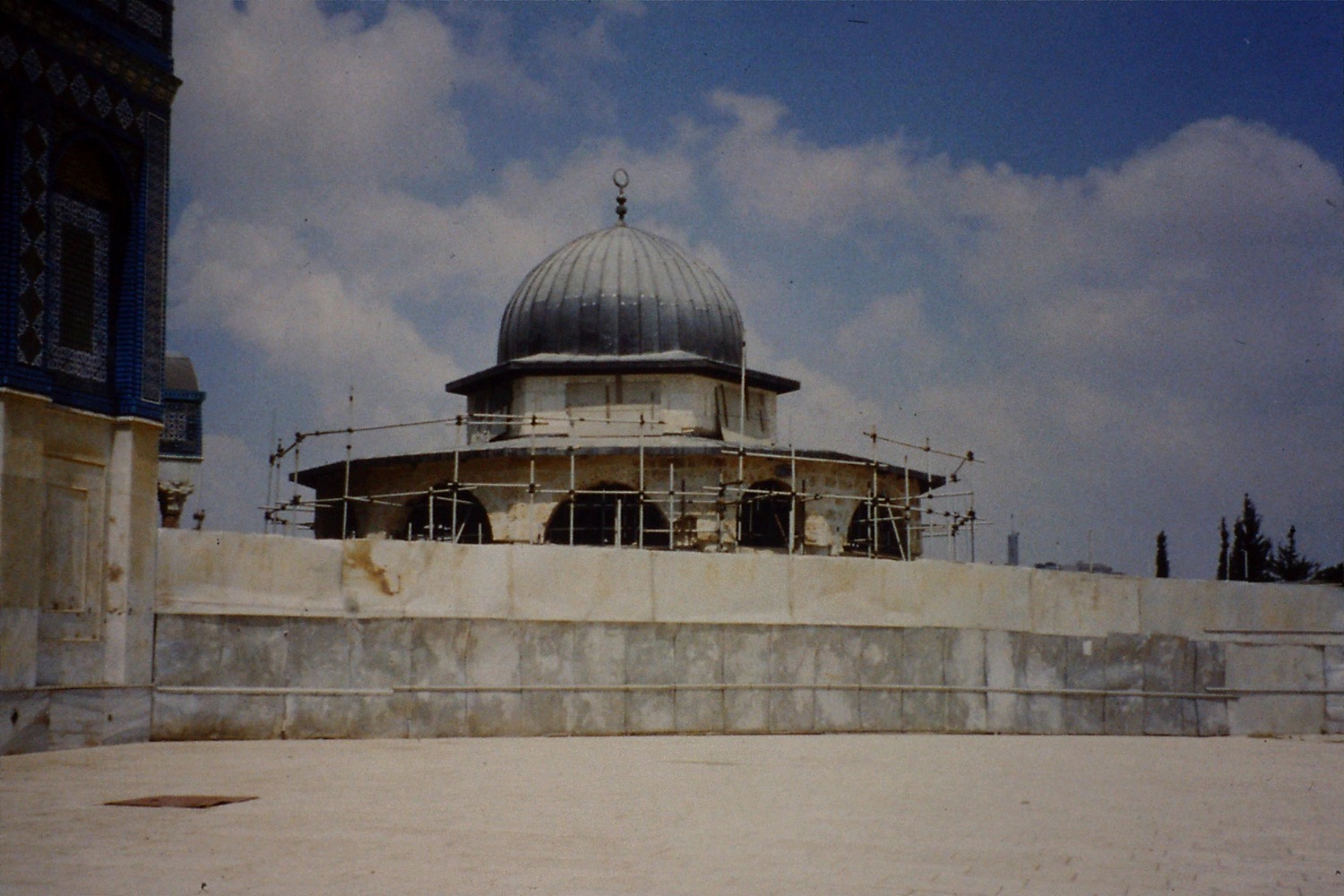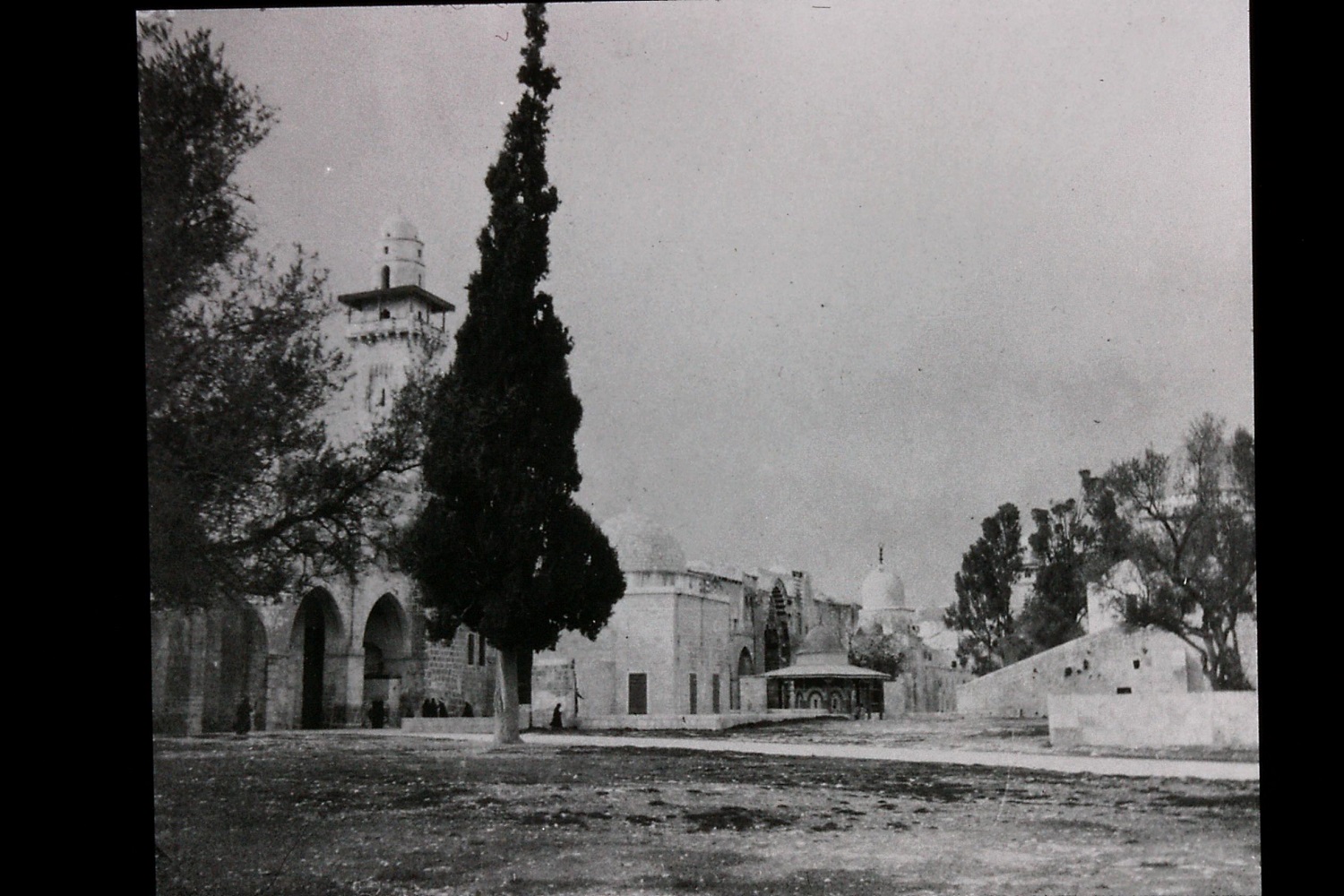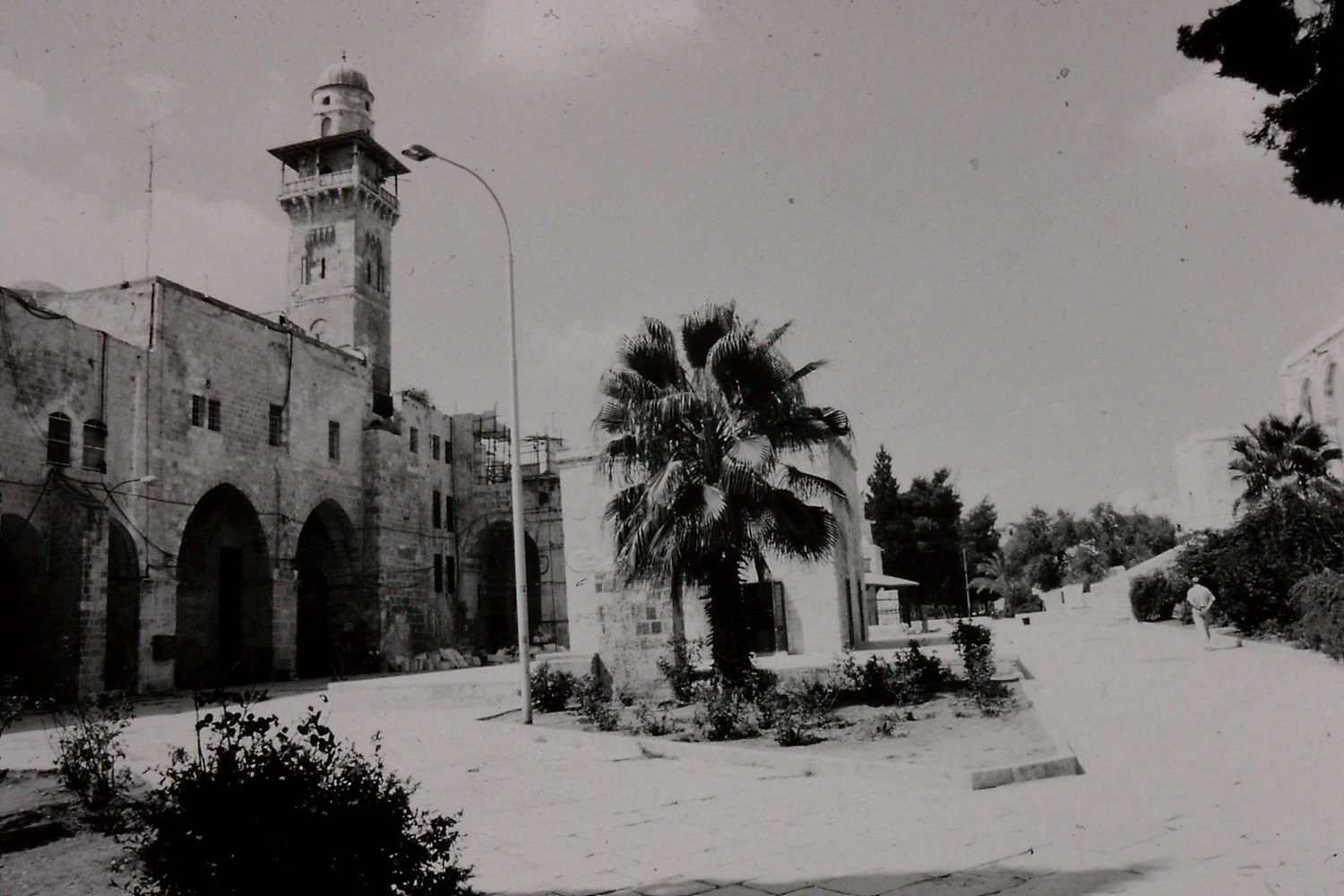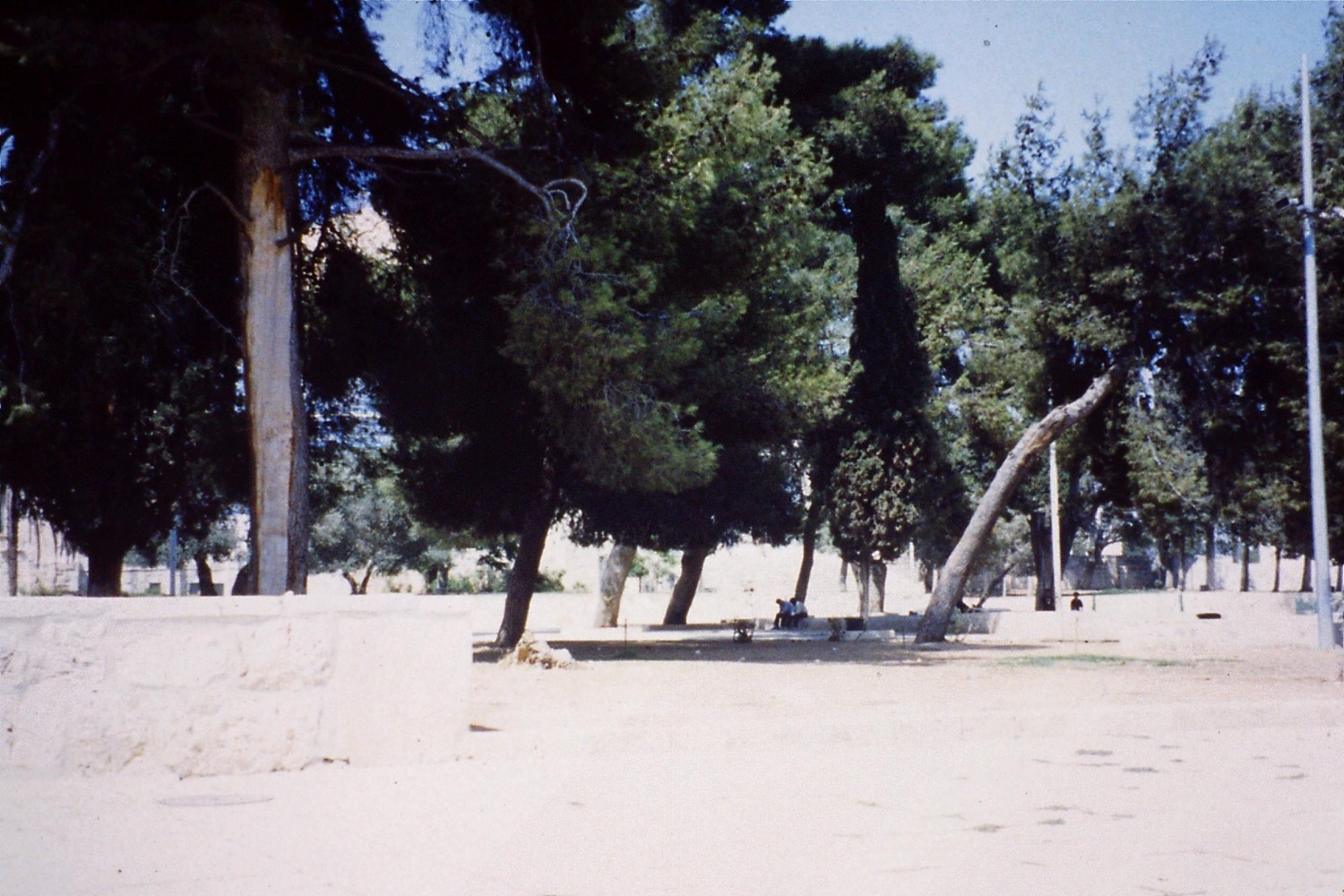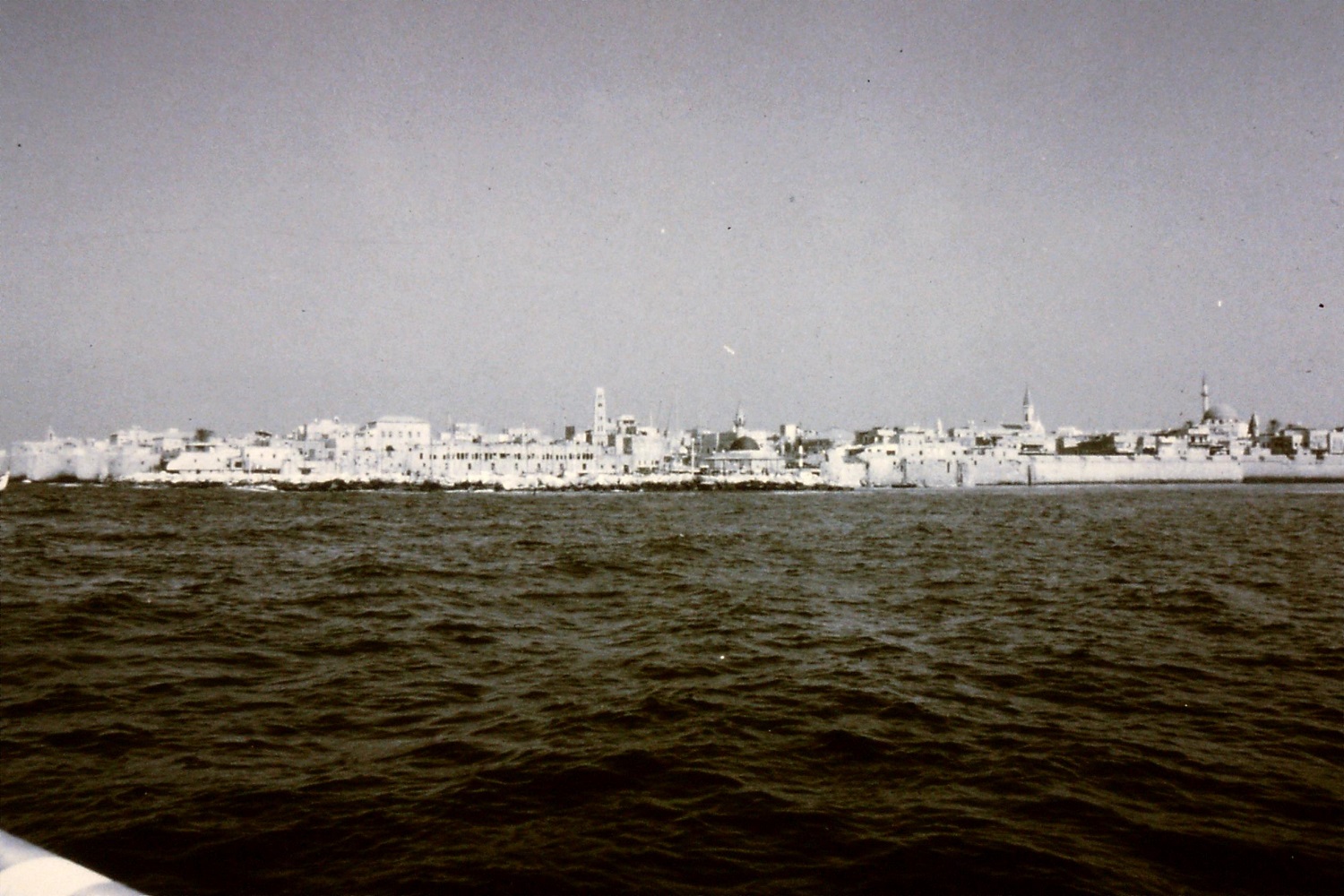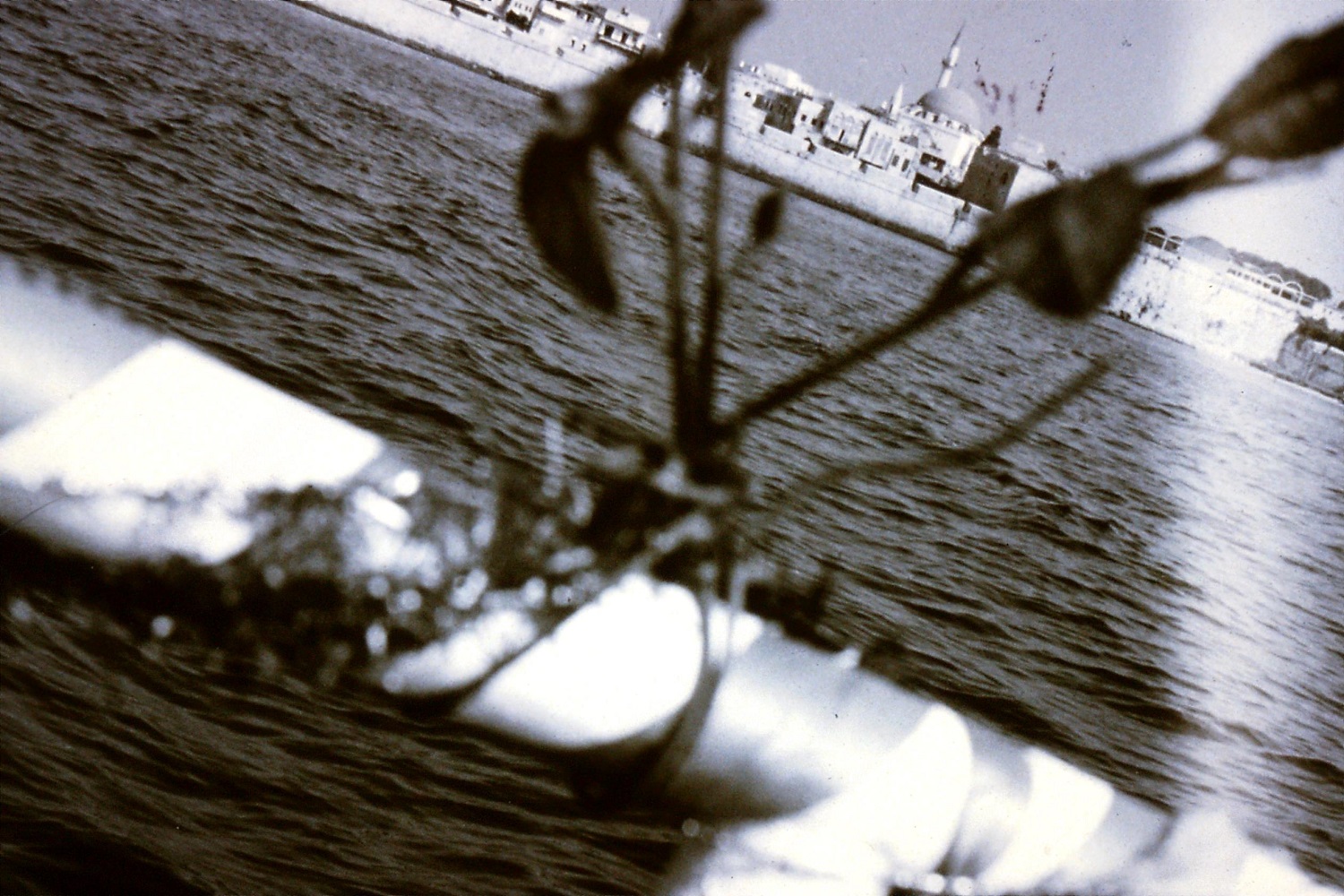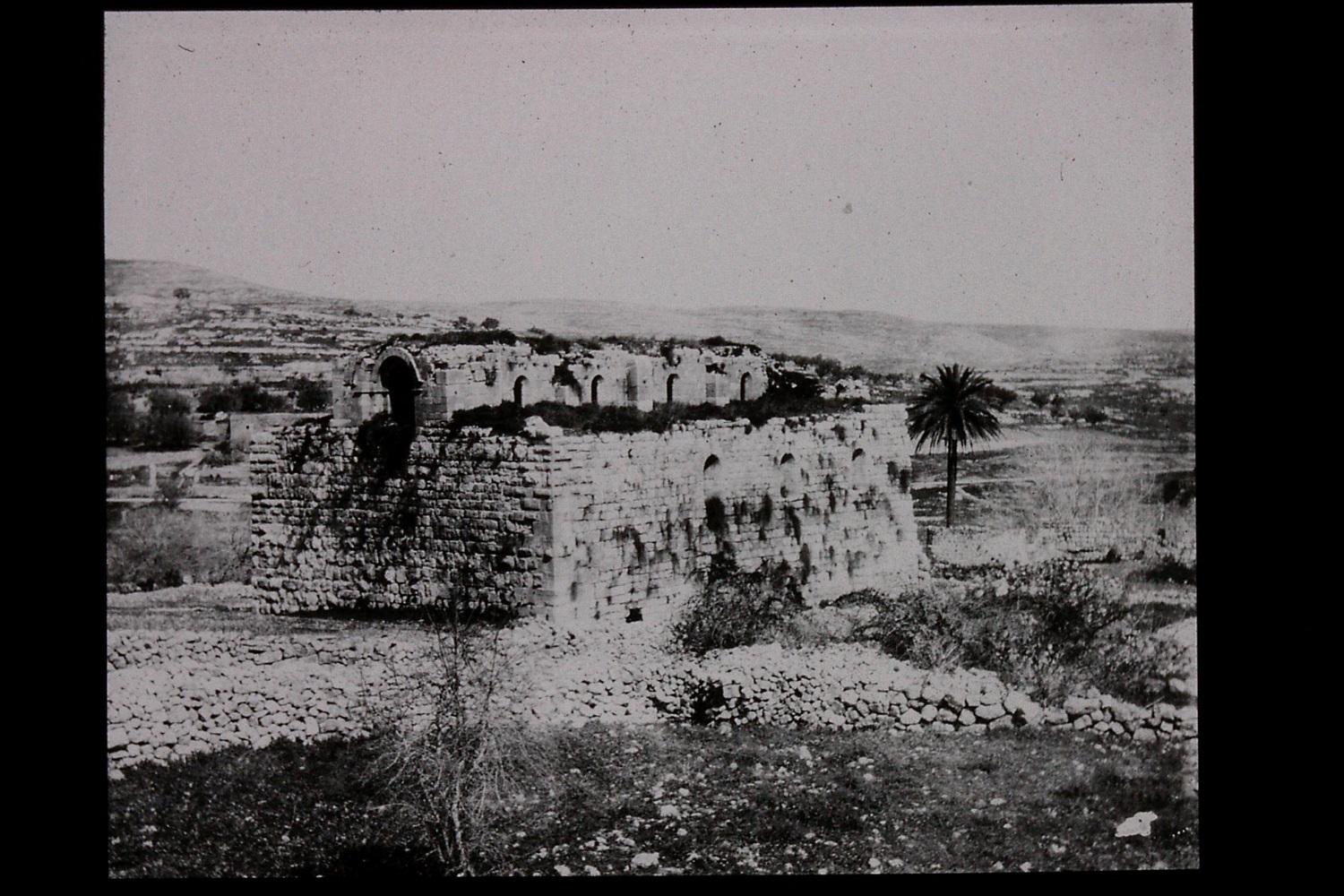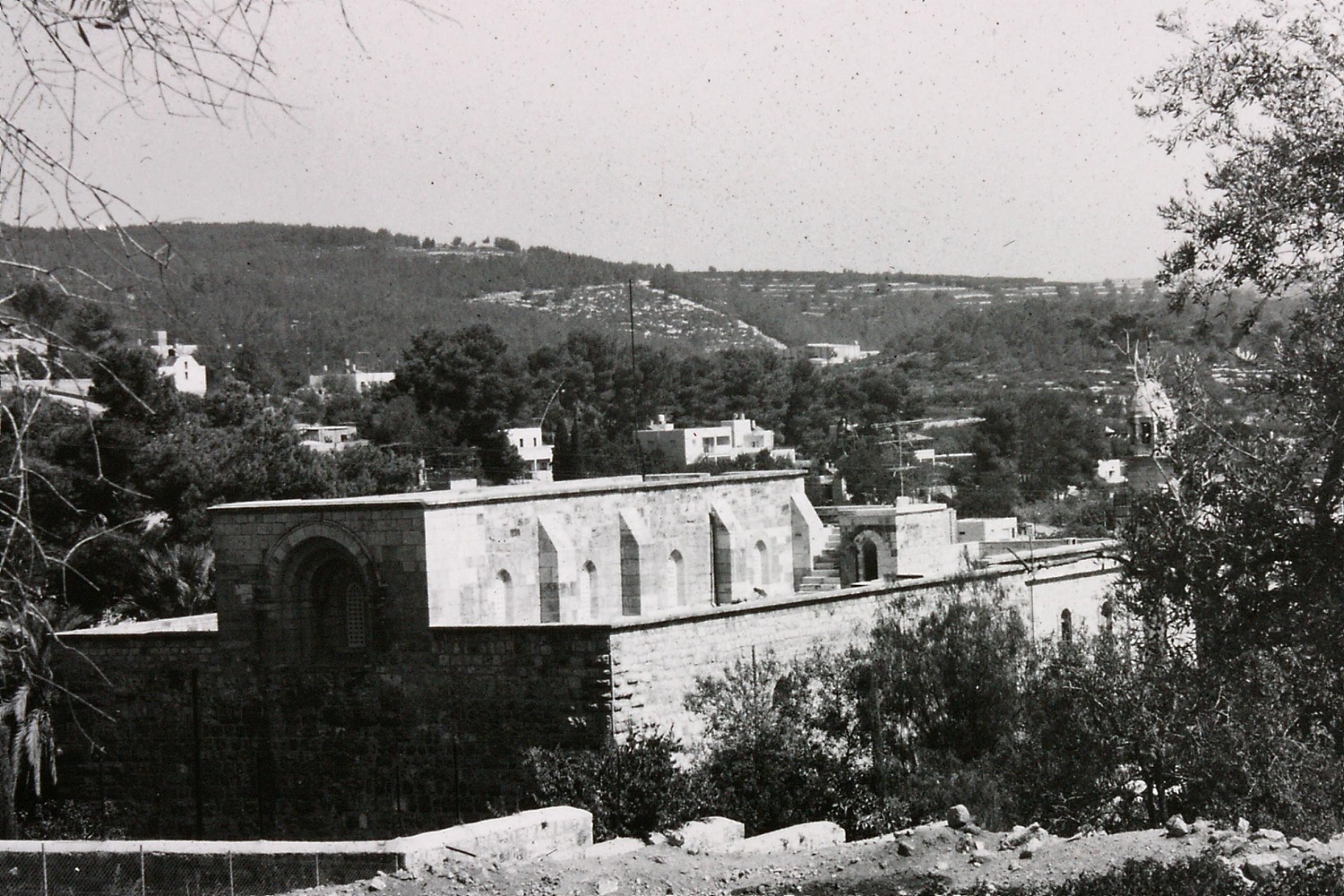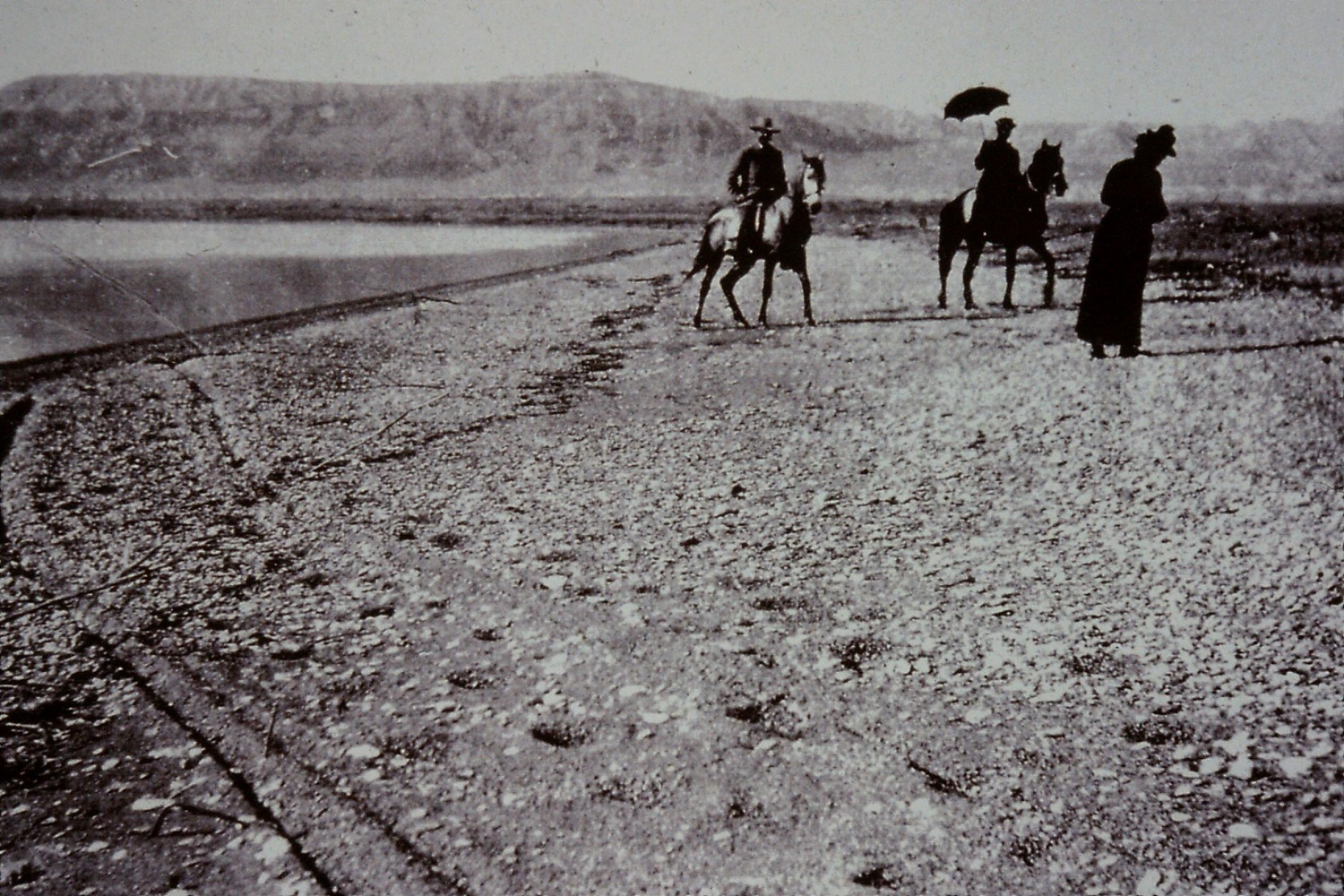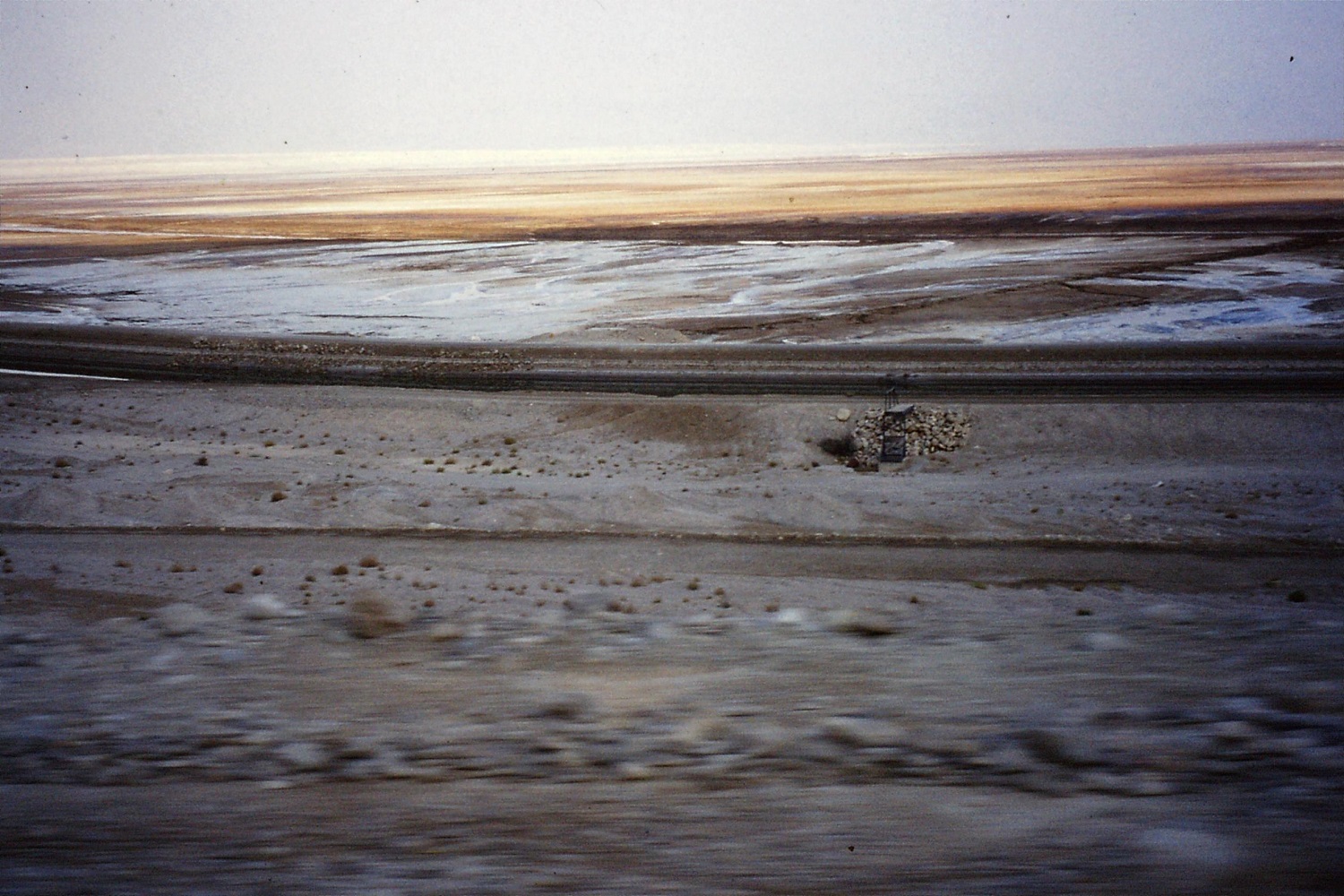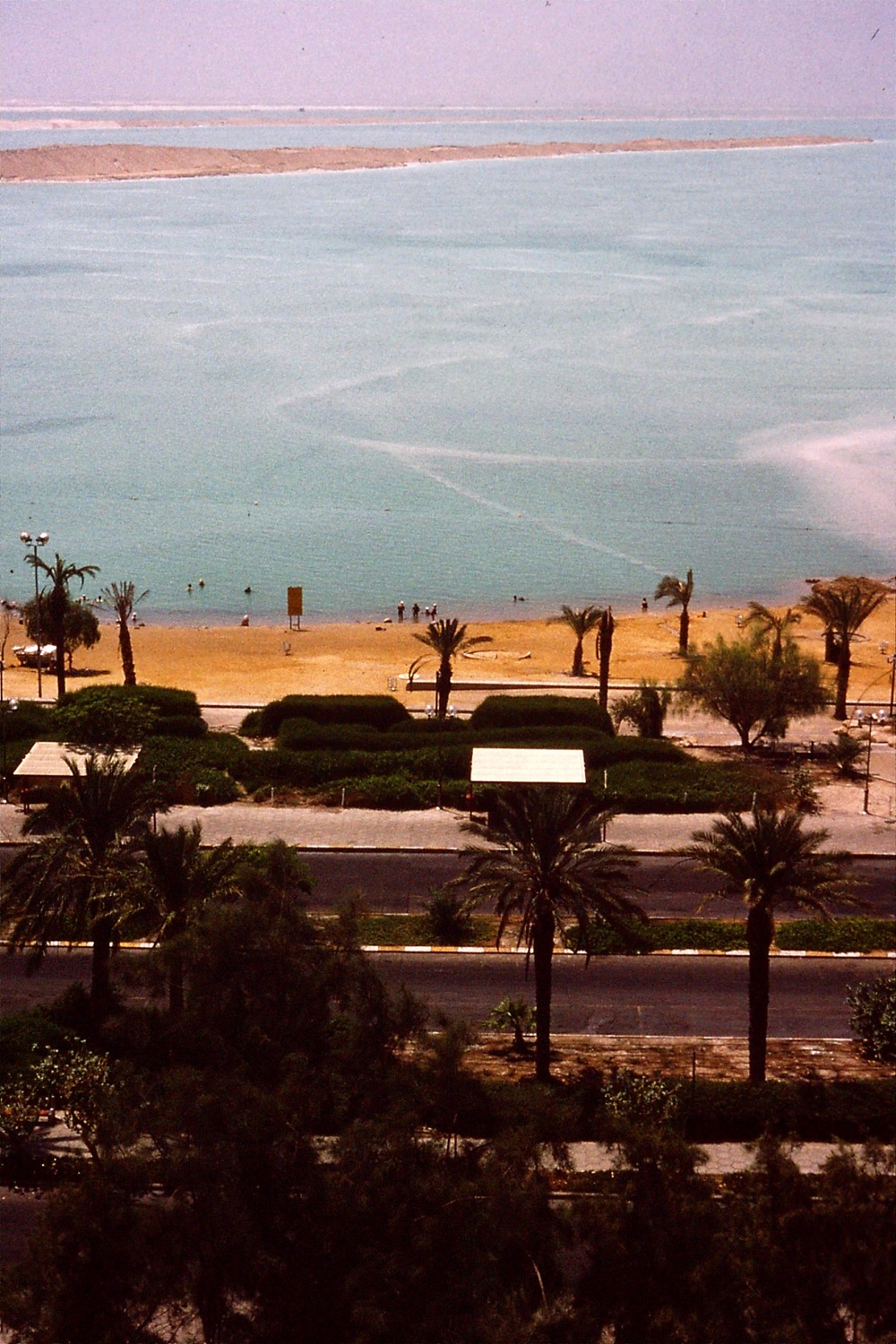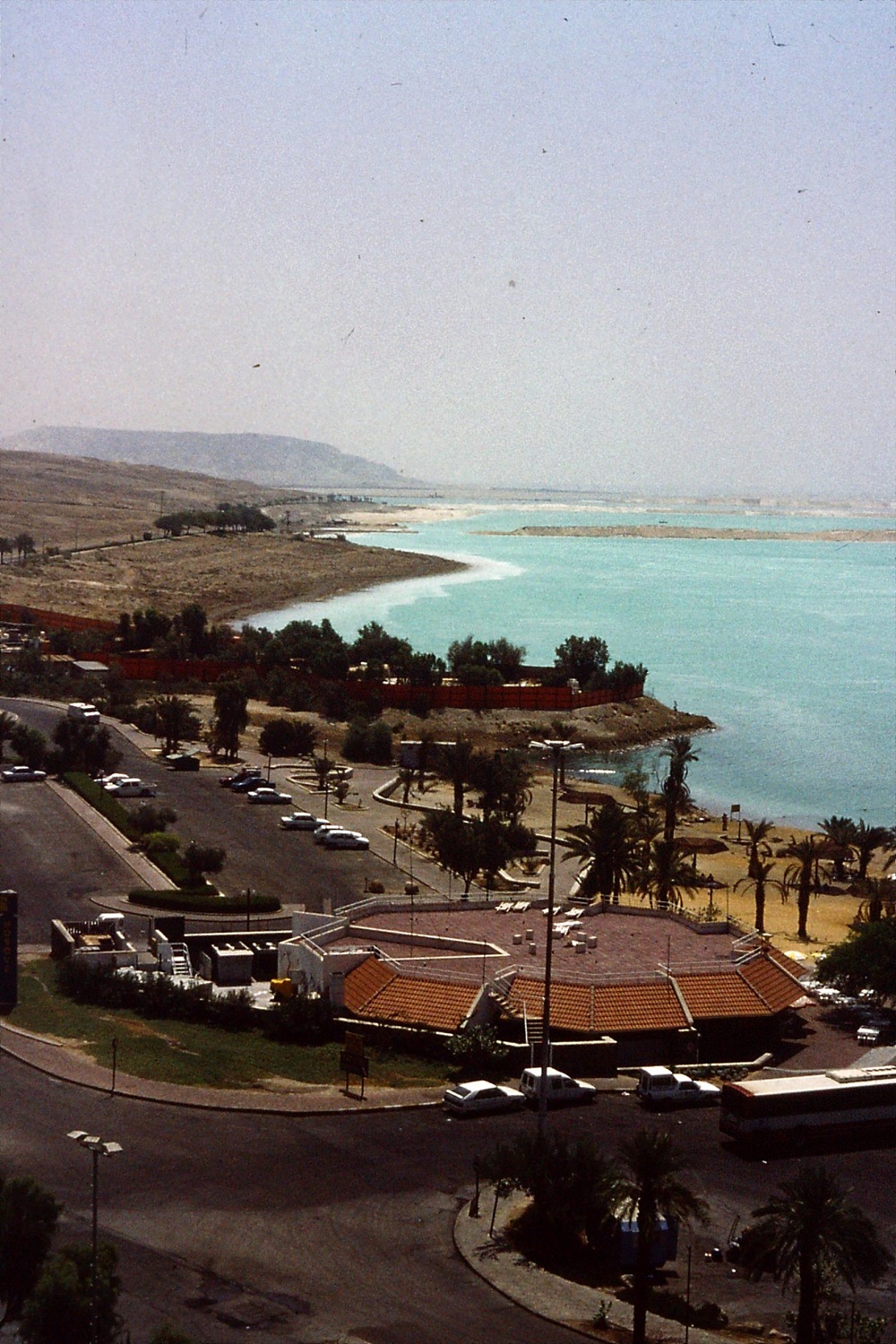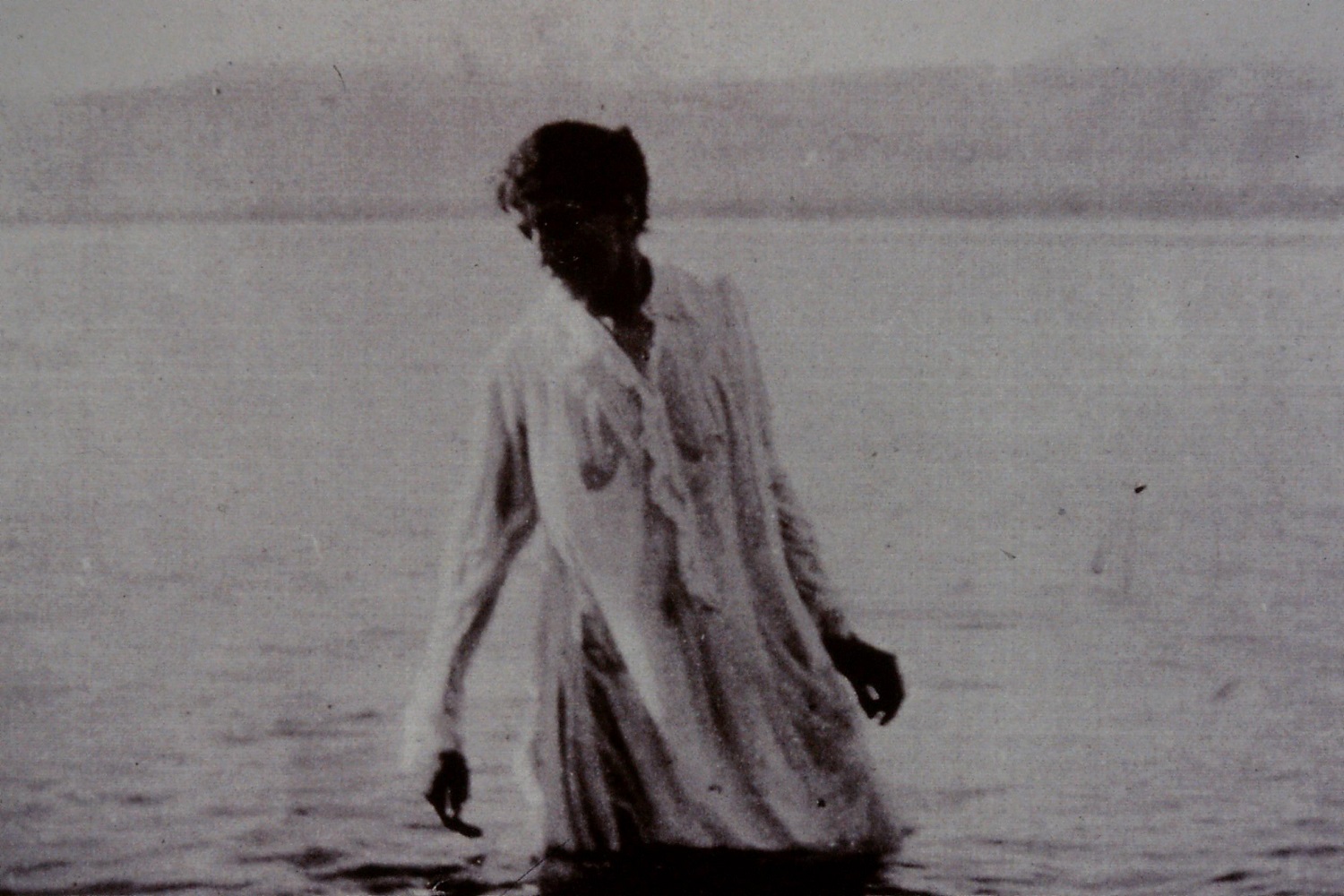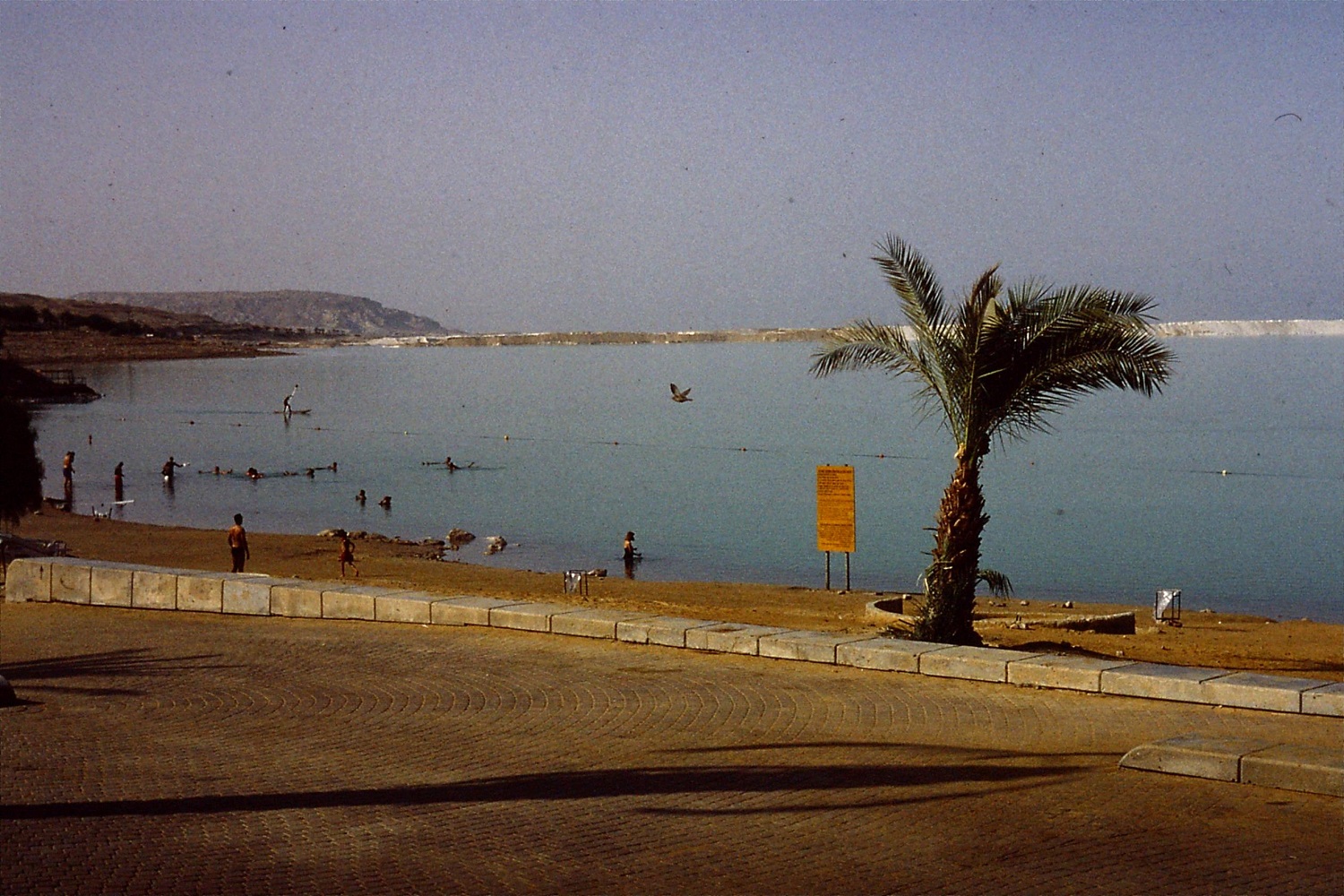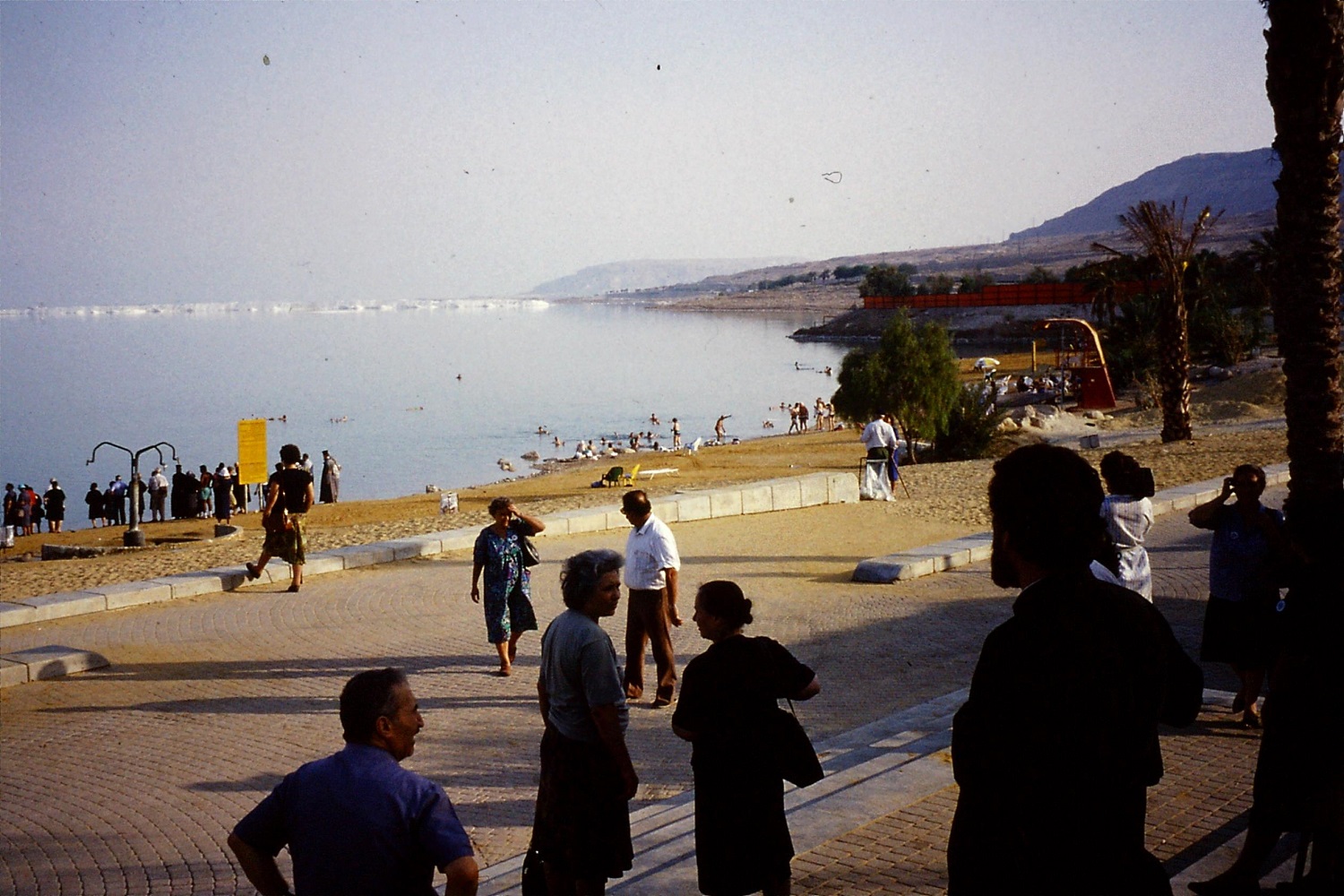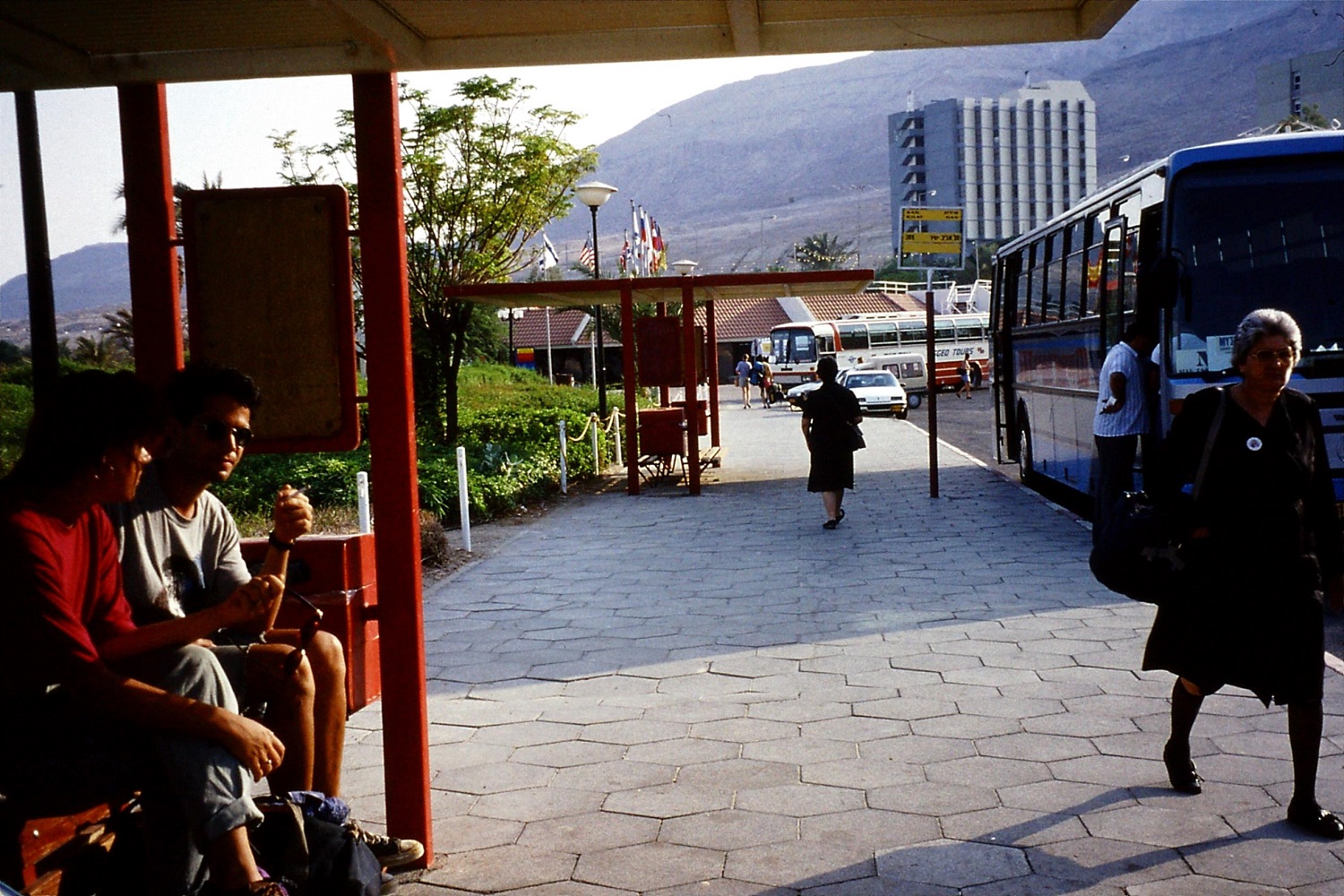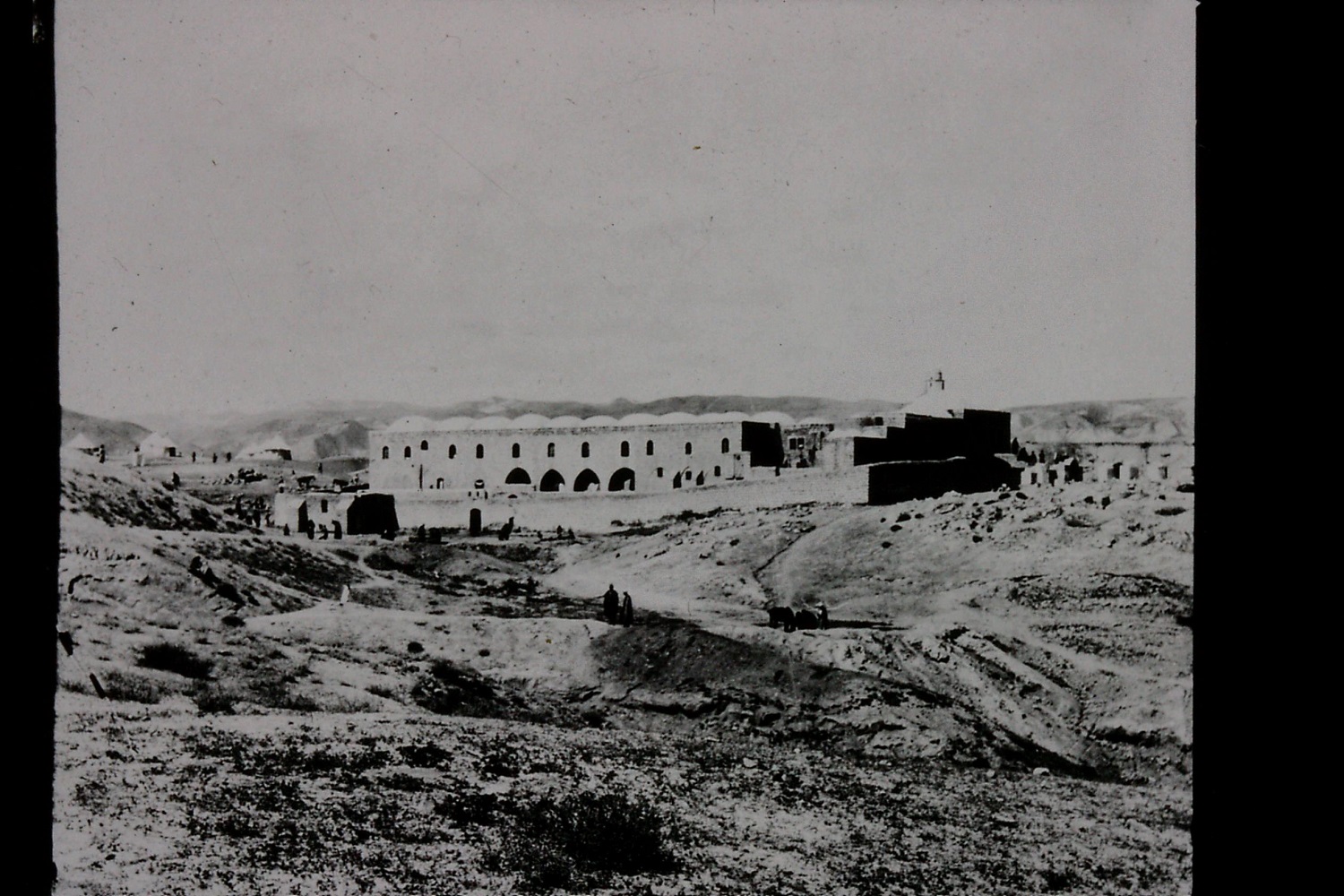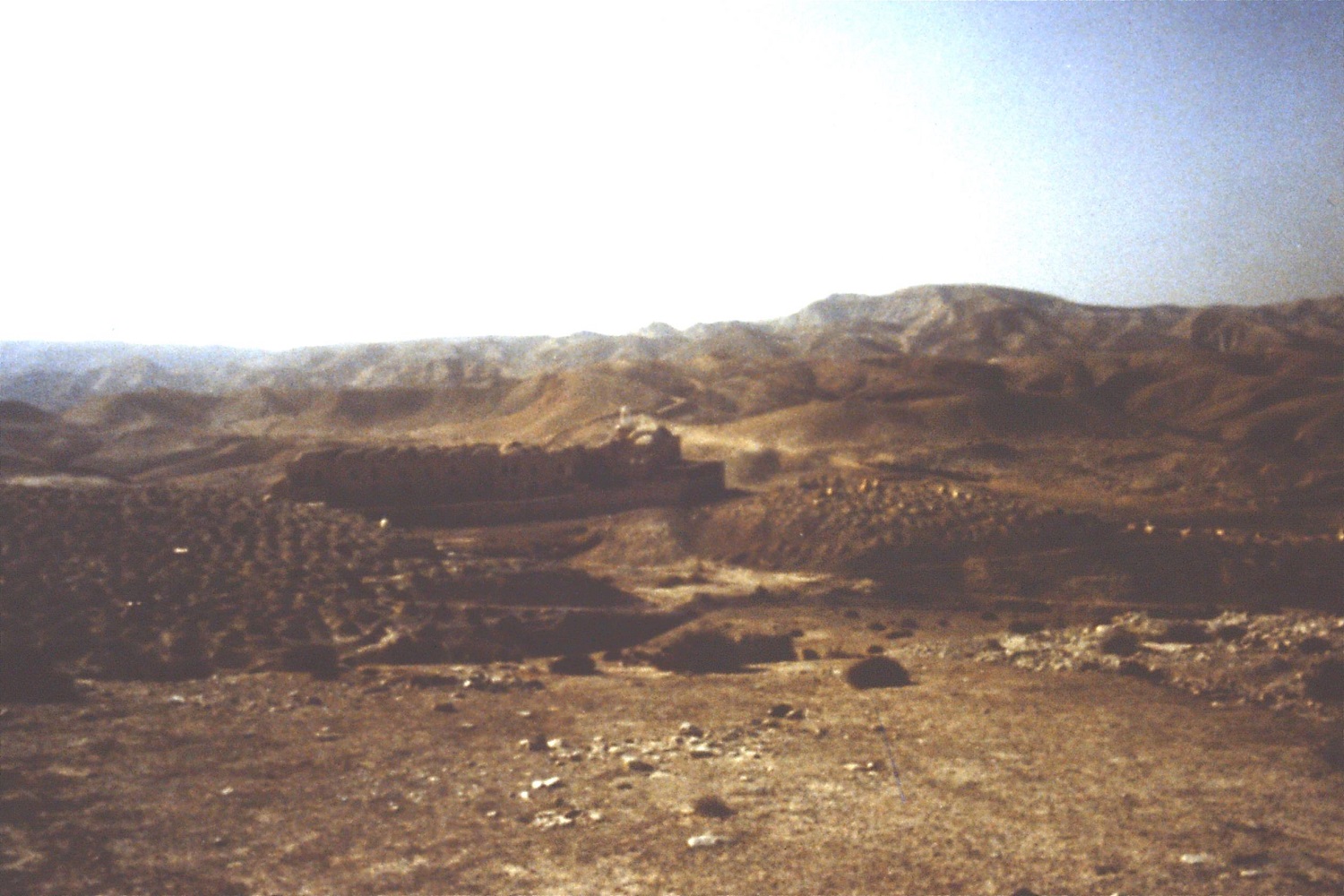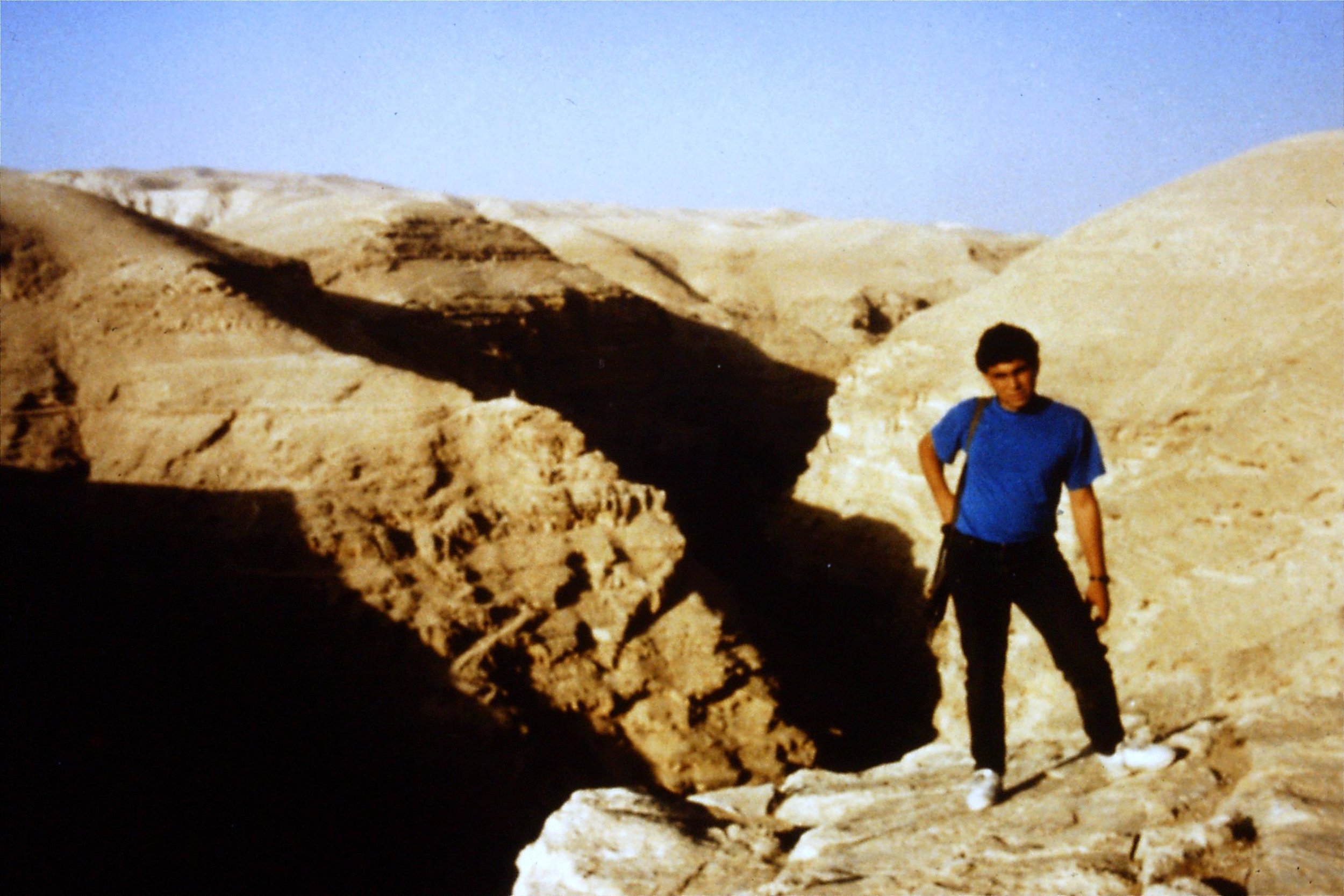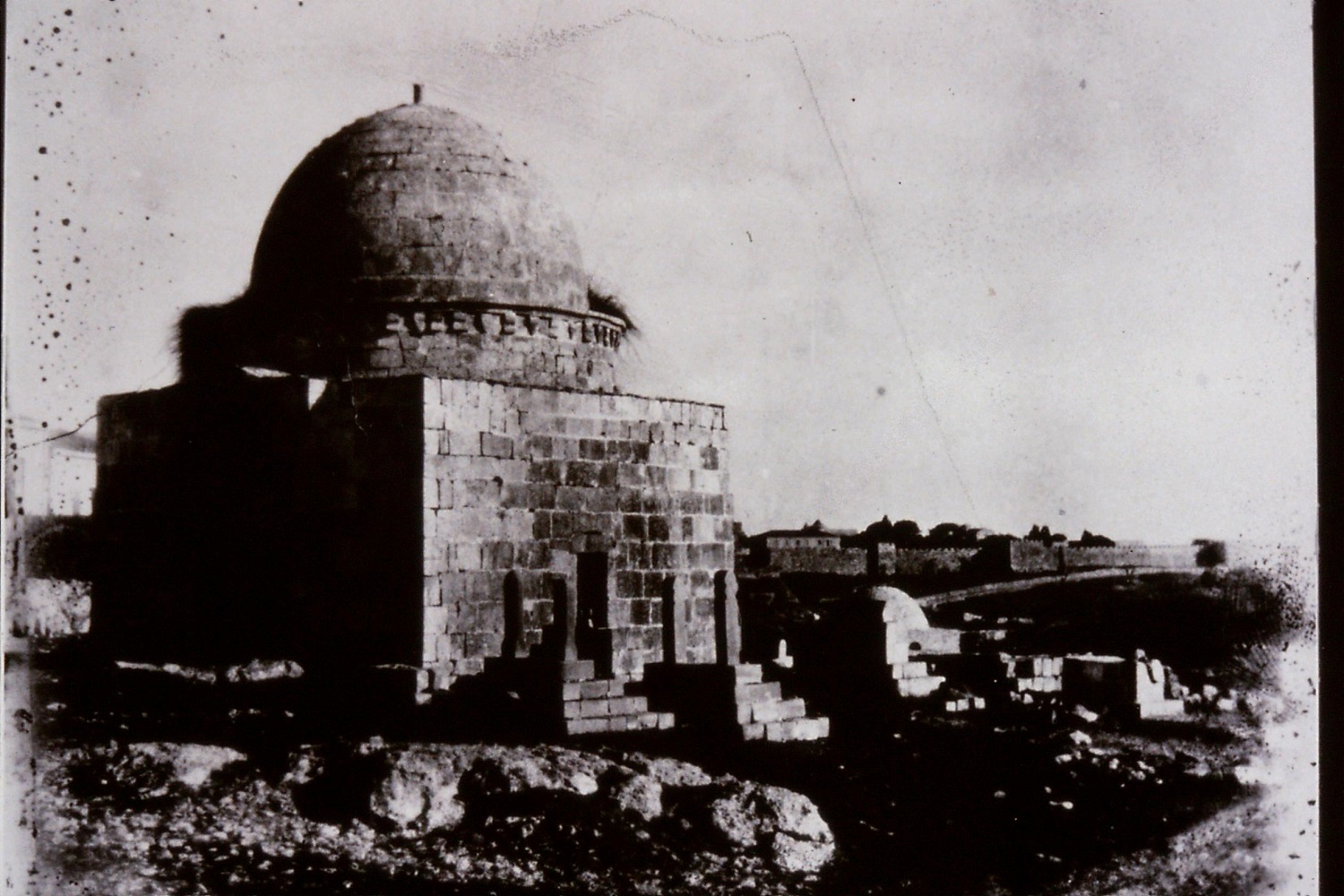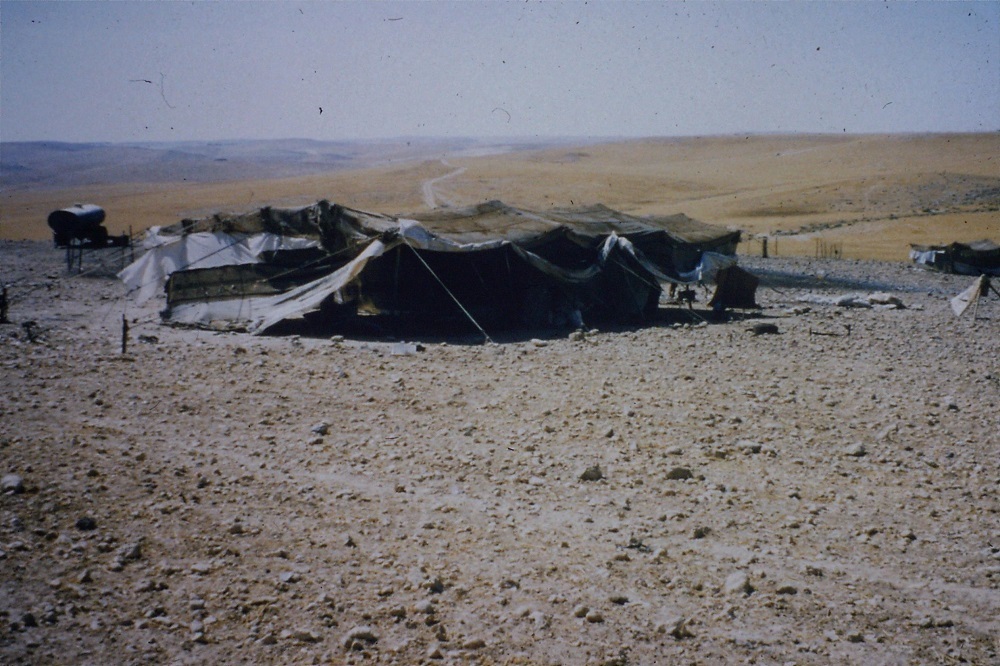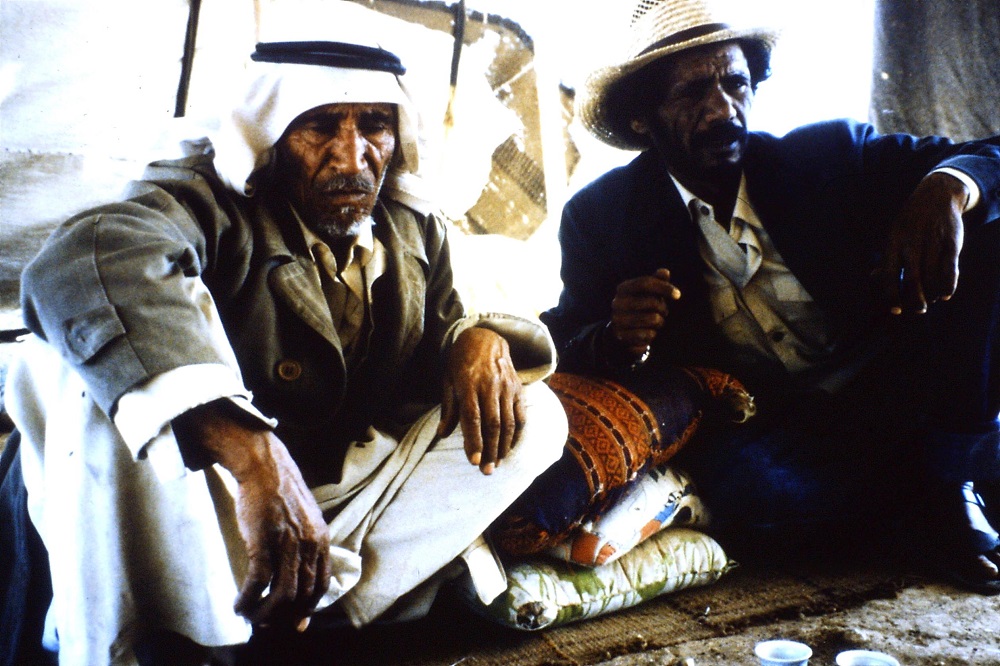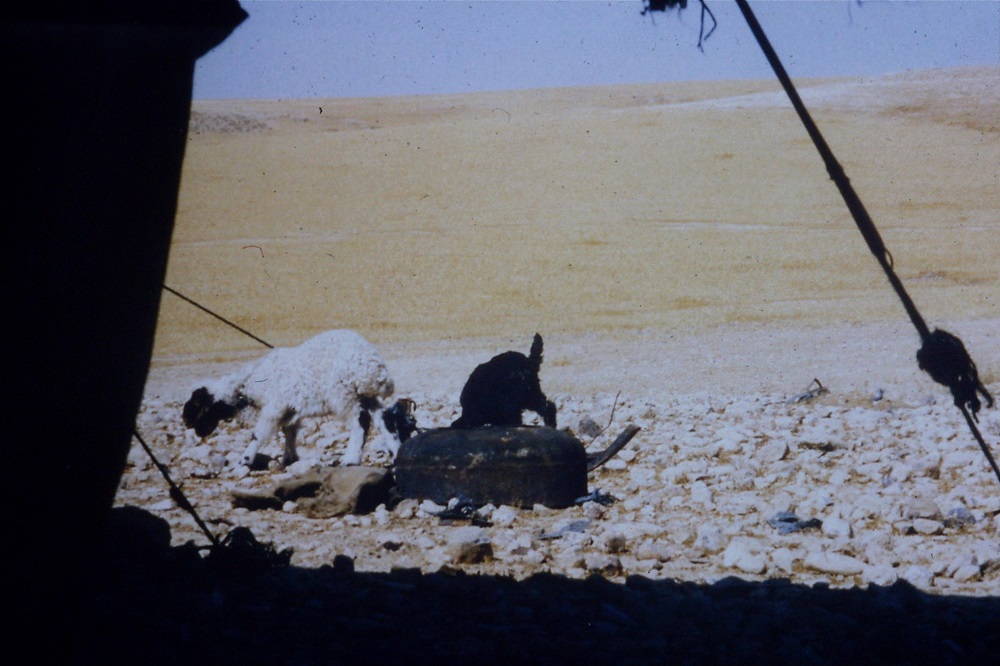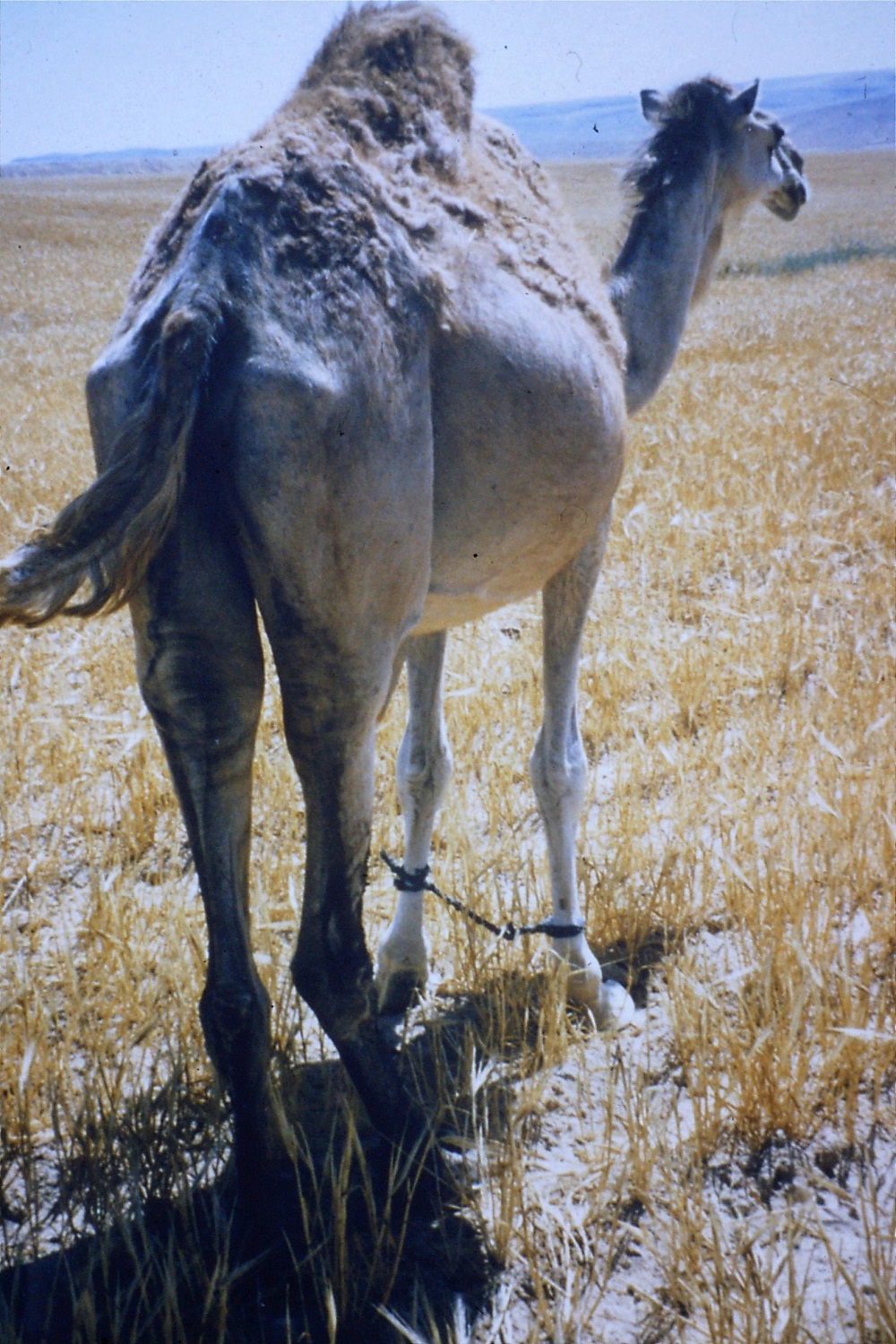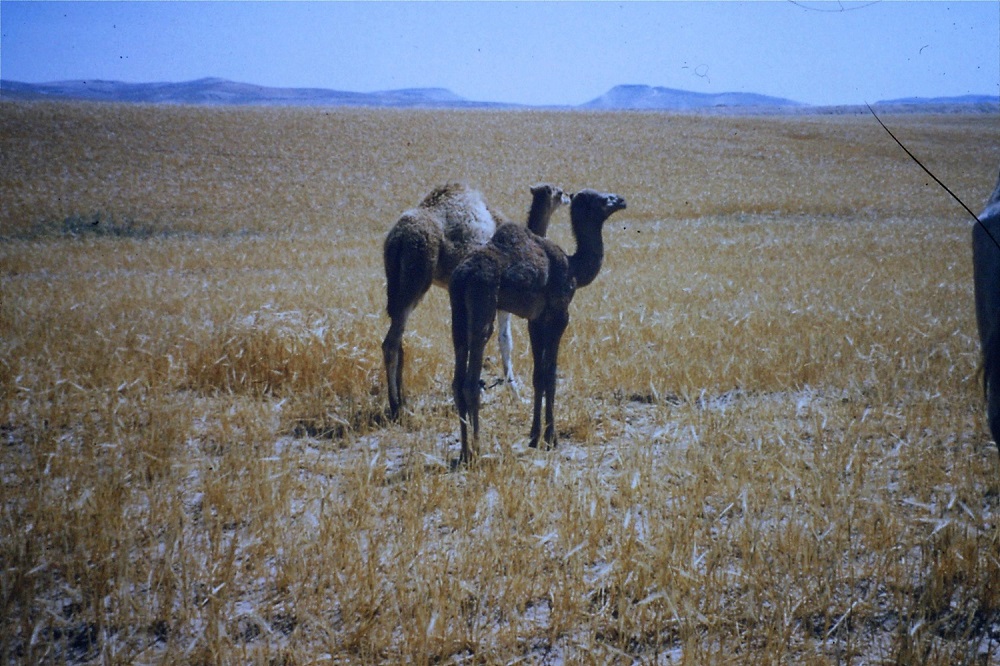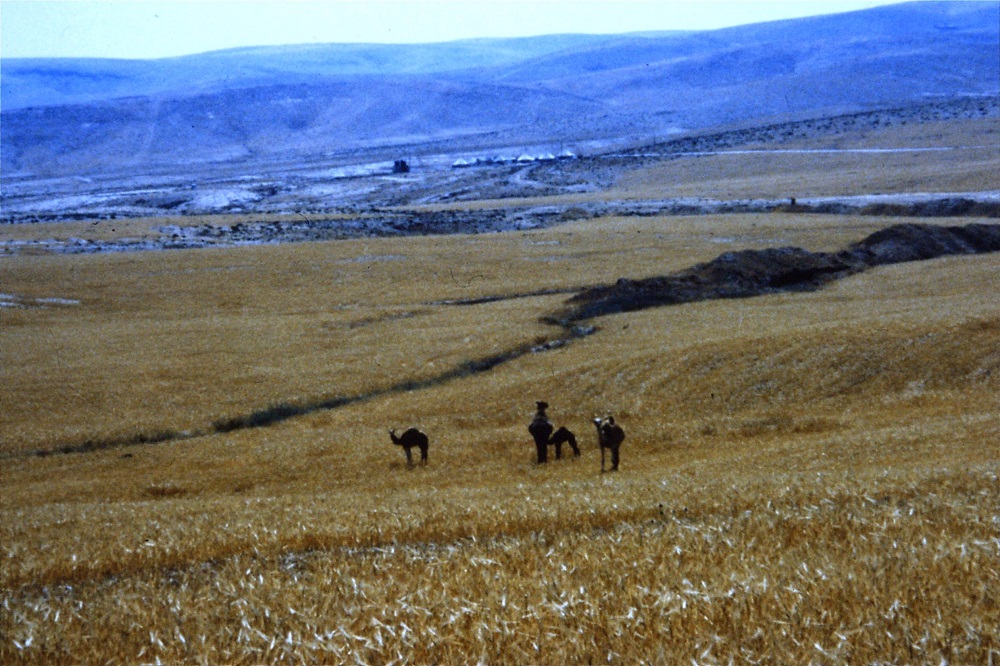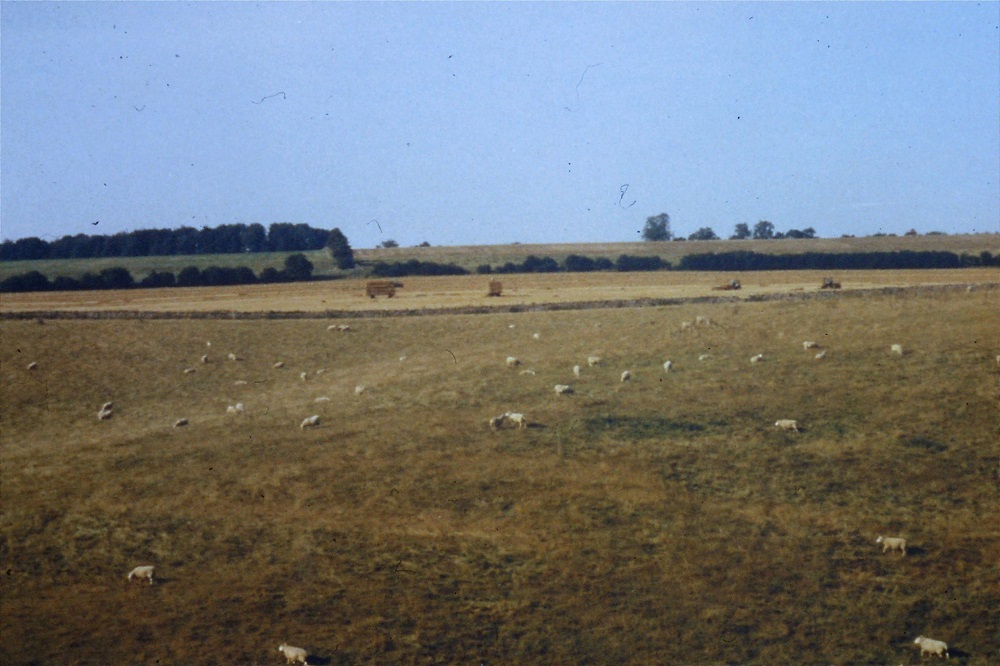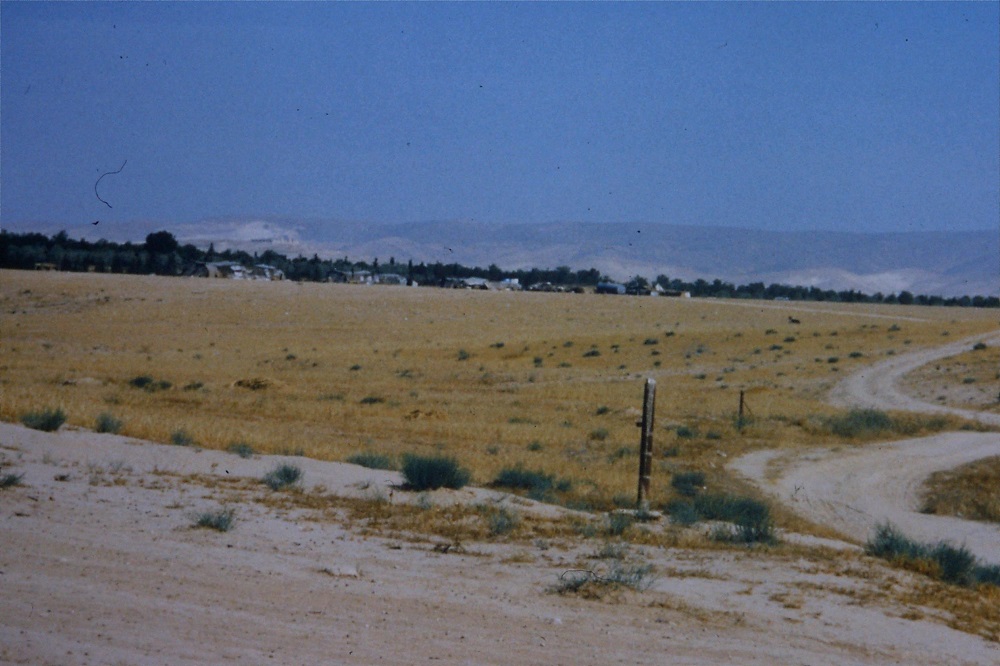THE GERTRUDE BELL PHOTOGRAPHIC ARCHIVE PROJECT
PALESTINE AND ISRAEL 1990-1992
The key resource is Newcastle University's digitised Gertrude Bell archive and I am pleased to acknowledge, with thanks, the University's support and permissions for this Project. I owe a particular debt of thanks to my team (see below), and to Dr Mahmoud Hawari now Director of the Palestinian Museum. Further acknowledgments are at the foot of this page.
Gertrude Bell outside her tent, possibly in Babylon April 1909. Catalogue number K218.
Gertrude Bell's photograph of The West Fort, Kerak, Jordan, 1900. Catalogue number A240.
Gertrude Bell (1868-1926) undertook some of the greatest archaeological journeys ever in the Middle East, notably between 1905 and 1914, photographing monuments, landscapes and people and writing about her travels and herself.
Her formative years of 1899-1900 were spent, with her camera and journals, in Palestine and Jordan (including modern Israel).
In 1989, shortly after completing my PhD studies on Roman villas, I was appointed to a temporary position as archaeological archivist at Newcastle University. My job was to curate and research a number of documentary collections of international importance held by the Department of Archaeology, such as the Libyan Society Archive and the Hadrian's Wall Pictorial Archive. But it was the Gertrude Bell Photographic Archive - comprising about 6,000 images - which really caught my eye, and led me to a research interest that was to take me and a small team of Newcastle University students to Israel and the Occupied West Bank in 1990 and 1991 (as an adjunct to a project I was already undertaking on the Roman landscapes of Palestine).
The Gertrude Bell Project team (from left): Phil Supple, Aiden Glendinning and Alexandra Layman, on the steps of the British School of Archaeology in Jerusalem, East Jerusalem, summer 1990
Gertrude Bell was generally well known as a prolific writer of letters and travel journals, as well as a scholar and political delegate in the Middle East during the carve-up of imperial territories after World War 1. However I wanted to look at her career as a photographer of archaeology, with particular reference to her early work whilst based in the photogenic city of Jerusalem.
Team Member Aiden Glendinning photographing in Old City Jerusalem, summer 1990
Eleanor Scott and team member Phil Supple at the British School of Archaeology in Jerusalem, summer 1990
Team member Phil Supple with camera in Old City Jerusalem, summer 1990
Phil Supple photographing Zion Gate in summer 1990. The bullet holes date to the war of 1948.
It seemed a useful exercise, especially with regard to the scholarship of Palestine, because Gertrude Bell's work had not yet been included in any of the main works that I could find on early (i.e. Victorian era) photography in the region. Based at the British School of Archaeology in Jerusalem, and armed with a plethora of cameras and film types - we were pre-digital and pre-everything - the team embarked on a mission to re-photograph everything that Gertrude Bell had photographed in Palestine between 1899 and 1900. How much would the monuments and landscapes have changed in nearly a century in Israel, the Occupied West Bank and Old City Jerusalem?
It was possible to see and assess levels of preservation, change, and deterioration of structures and whole archaeological sites. Where deterioration has happened, as unfortunately is frequent, Bell's photograph becomes an invaluable source of primary knowledge for it. (How true this now is for sites in Syria, Iraq and much of the Middle East.)
We were operating in a difficult political climate during 1990-1992 in the Old City and the rest of the Occupied West Bank, and I remain hugely grateful to all those who helped us during the intifada and the start of Gulf War 1 with access to places and landscapes and the rapidly changing logistics of plans on almost a daily basis.
There were times we had trouble 'getting the shot' because the landscape had simply changed so much, having been levelled, excavated or re-developed; or physical impediments had appeared, or the photographic subject no longer existed, or access was denied.
I've presented most of the photographs with 'side by side' aspects, i.e. the Bell photograph next to the intifada-era photograph. Where there is a full-width stack of two photographs, for example the views of the Old City, look for the 'side by side' pairing underneath it.
Please also have a look at the Gertrude Bell Gallery on this website. Acknowledgements - and there are many - are at the foot of this article.
Bethlehem, West Bank
ABOVE A91 and A92 (left) Gertrude Bell's photographs of Bethlehem, 'Views of town', January 1900; and (right) the same views taken in 1990, revealing the profound changes over 90 years. Credits: Eleanor Scott and Gertrude Bell Project.
Old City, Jerusalem
Views towards the Western Wall and Temple Mount
Gertrude Bell's photograph of the Old City Jerusalem, December 1899. Catalogue number A45-47.
A45-A47 are labelled by Gertrude Bell (and entered into the official 1985 Catalogue) as being 'From the W Wall'. In fact they are views looking towards the Western Wall [of the Temple] taken from the south wall (Dung Gate) looking north. 'Side by side' views are beneath the 1990 view below.
A45-47. The same view taken in summer 1990. Credit: Eleanor Scott and the Gertrude Bell Project
ABOVE A45-47. One can clearly see the excavation of the Western Wall of the Temple Mount which has taken place, and the clearance of houses known as the Moroccan Quarter which was undertaken by the Israeli administration since they annexed the area after the Six Day War of 1967. The security gates and barriers are also evident in the 1990 view.
ABOVE A34 'Wailing Wall'. The Western Wall of the Temple Mount, (left) taken by Bell in December 1899 and (right) by Gertrude Bell Project in summer 1990. The depth of the post-1967 excavations are apparent.
Outside the City Walls: Bir Ayub (Silwan)
ABOVE A177 and A178, 'Ancient water channel, Bir Ayub', March 1990.
BELOW The subjects of Bell's photograph's A177 and A178 are now located in the Palestinian village of Silwan, in the West Bank just outside Jerusalem, which was very heavily policed by border guards and army in 1990 and extremely difficult to visit. There was little sign of preservation.
Silwan, West Bank, 1990. Credit: Eleanor Scott
ABOVE Border guards and soldiers guard the entry point into Silwan from the Old City, 1990
Church of the Holy Sepulchre
Gertrude Bell's photograph of the Church of the Holy Sepulchre taken from the German Tower, December 1899. Catalogue number A41.
A41 The same view taken in summer 1990. Credit: Eleanor Scott and the Gertrude Bell Project
ABOVE A41. 'Church of the Holy Sepulchre from the German Tower' shows, despite all the extraordinary infighting between different Christian factions resident in and on the Church, a remarkable continuity of appearance. Spot the ladder...
Inside the Old City Jerusalem
ABOVE A511 'Group outside the German Church on the Emperor's birthday', Old City Jerusalem; and A565 Fountain in Old City Jerusalem
The Gates of the Old City Jerusalem
Damascus Gate
Gertrtude Bell's photograph of Damascus Gate, December 1899. Catalogue number A25.
ABOVE A25 Damascus Gate taken between 1990 and 1992, at different times of the day.
BELOW (left) The Palestinian market outside Damscus Gate in 1992. Signs and symbols of the intifada are evident; and (right) A102 Gertrude Bell's photograph of 'men and camels outside the Damascus Gate', January 1900, and the changed city-scape of 1990 looking up to the Vatican Building.
ABOVE A24 (left) Gertrude Bell's photograph of Damascus Gate, inside the Gate, December 1899; and (right) the same view taken in 1992 showing the Palestinian market which has replaced some of the internal walls.
BELOW Compare the photograph taken by Auguste Salzmann in 1854.
Auguste Salzmann 1854, Damascus Gate (Interior)
BELOW And in 1990, this is what we saw when we turned around. Armed Israeli border police on the rooftops, a distinct lack of tourists, and the Palestinian inhabitants of and workers in the Old City.
Inside Damascus Gate looking SE down road towards Haram, summer 1990. Credit: Eleanor Scott and Gertrude Bell Project
Herod's Gate
ABOVE A21 (left) Gertrude Bell's photograph of Herod's Gate, inside the Gate, December 1899; and (right) two photographs of the same view taken in 1990.
Zion Gate
ABOVE A115 (left) Gertrude Bell's photograph of Zion Gate, January 1900; and (right) two photographs of the same view taken in 1990. The bullet holes date from the war of 1948.
Haram esh-Sharif, the Temple Mount, Jerusalem
Gertrude Bell's photograph of 'the Mosque of Omar' (the Dome of the Rock), December 1899. Catalogue number A55.
A55 view, summer 1990. Credit: Eleanor Scott and Gertrude Bell Project.
Gertrude Bell's photograph of Al Aqsa Mosque through archway. Catalogue number A51.
A51 view taken in summer 1990. Credit: Eleanor Scott and Gertrude Bell Project.
ABOVE A35 'Temple Mount (Haram Esh Sherif) entrance gate'
Gertrude Bell's photograph of 'the view up to the Dome of the Rock through entrance archways, AD 691', December 1899. Catalogue number A53.
ABOVE A53 in December 1899, and summer 1990
A53 The same view taken in summer 1990. Credit: Eleanor Scott and the Gertrude Bell Project.
Gertrude Bell's photograph of view through decorated archways, December 1899. Catalogue number A52.
A52 view taken summer 1990. Credit: Eleanor Scott and Gertrude Bell Project.
Gertrude Bell's photograph of Qubbet Al-Silsila (The Dome of the Chain), December 1899. Catalogue number A48.
A48 view taken in summer 1990. Credit: Eleanor Scott and Gertrude Bell Project.
Gertrude Bell's photograph of general view of Haram esh-Sharif (Temple Mount), December 1899. Catalogue number A54.
A54 view taken in summer 1990. Credit: Eleanor Scott and Gertrude Bell Project.
Gertrude Bell's photograph of the Dome of the Rock, view from Moroccans Gate. December 1899. Catalogue number A44.
A44 view taken in summer 1990. Credit: Eleanor Scott and Gertrude Bell Project.
Acco (Acre)
ABOVE A508 'Acre' (Acco), 'view from sea' (far left), photograph by Gertrude Bell. To the right of this photograph is the team's shot in 1990 of the same view, having hired a boat, a trip which didn't always go as planned...
Crusader Church, Abu Ghosh
Gertrude Bell's photograph of 'Crusader Church, Abu Ghosh (El Qubeibeh), 12th C', March 1900. Catalogue number A140.
ABOVE The 12th century Crusader Church at Abu Ghosh, as it appeared in 1900. For the architectural historian, the Bell photograph is much more important than the modern view of the reconstructed monument (BELOW). (See also 'side by side' aspect, BELOW.)
A140. The same view taken in summer 1990. Credit: Eleanor Scott and the Gertrude Bell Project.
The Bell print suggests a fortified rural church, a single nave structure with a surprisingly large number of high windows on its flanks; and the buttressing suggests a high superstructure i.e. a high clerestory, which makes the presence of flank windows very interesting. The platform is angled, with rough projecting stonework, and access was presumably by ladder, The church is in a location which makes it prominent in the landscape, and which gives it a defensive appearance.
The modern image of the reconstructed church tells a very different story. The church has been deliberately rebuilt - going way beyond consolidation of an ancient monument - and the landscape around has been developed and remodelled. It can be determined by comparison with the Bell photograph that this is not a faithful reconstruction. The walls appear to be far too neat, and the platform is now a smooth vertical feature, and is less defensive looking. The church body is also levelled off and the windows appear to be blocked, presumably darkening the interior.
(Additional credits: photography Aiden Glendinning and Phil Supple; architectural information Neil Christie.)
The Dead Sea
ABOVE A137 and A556 at the Dead Sea (B&W) by Gertrude Bell, 1899. Colour photo credits: Eleanor Scott 1990-1992.
Neby Musa and Ain Farah, West Bank
ABOVE A196 Bell's photograph of Neby Musa desert monastery ('Neby Musa Procession'), April 1900. I couldn't 'get the shot' in 1990 because it wasn't considered a good idea for me to leave the vehicle, was told to keep the windows wound up, and the (armed) Israeli archaeologists who took me out there weren't minded to divert off the road or stop the vehicle except for a few minutes at (right) Ain Farah (where Bell had taken photographs A467-470).
Cemetery, East Jerusalem
ABOVE A29 'Cemetery and N Wall, 1543 (N Wall)'. Bell's photograph was taken in December 1899; ours in summer 1990. Trees and other plant growth around and on the monument are evident.
Bedouin, Judean Desert
Gertrude Bell's photograph of Bedouin encampment, near Mar Saba, 1900. Catalogue number A477.
Gertrude Bell's photograph of Bedouin encampment, near Mar Saba, 1900. Catalogue number A474.
ABOVE Gertrude Bell's photographs of Bedouin encampments near Mar Saba, 1900. Mar Saba is in the Judean Desert between Jerusalem and the Dead Sea, where Bedouin - at least in 1990 - were still living, although the majority were located in the Negev and leading increasing sedentary lives. Catalogue numbers A477 and A474.
ABOVE Bedouin in Israel and the West Bank 1990. Thanks to Musa Salam, park ranger at Masada National Park, for taking me to visit his family home on the edge of the Judean Desert where the Negev begins.
BELOW Musa Salam's family's livestock and the landscape around their family home.
Photo credits: Eleanor Scott, with many thanks to Musa Salam
Musa Salam, Bedouin and Park Ranger, Masada National Park. Credit: Eleanor Scott
Acknowledgements
The Gertrude Bell archive was donated to Newcastle University by the Bell family.
My thanks to Newcastle University and in particular to the Department of Archaeology for their support for my undertaking the Gertrude Bell Photographic Archive Project in Israel and the Occupied West Bank in 1990-1992.
The project could not have been undertaken without the Catalogue of the Gertrude Bell Photographic Archive compiled by Stephen Hill, Lynn Ritchie and Barbara Hathaway. Jeremy Johns lent me his annotated copy and unpublished lecture notes, and Lynn Ritchie talked me through many aspects of the archive and diaries and allowed me to see material prior to publication. Lindsay Allason-Jones was a major support back in Newcastle whilst I was both there and in Jerusalem. Thanks to Newcastle University for all the support and permissions, especially Lindsay, Jeremy Johns, Georgina Howell and Jim Crow.
The team in Jerusalem comprised myself, Phil Supple, Aiden Glendinning and Alexandra Layman. The team members worked in extremely difficult conditions, where access to some places was not only logistically arduous but also at times pretty dangerous. We couldn't get all the shots we wanted, but we did our very best.
I am extremely grateful to Dr Mahmoud Hawari for accompanying me on one particular day around the Haram. Without his assistance I wouldn't have successfully completed that portion of the Project in the time available.
I'd additionally like to thank a number of scholars staying at the British School of Archaeology in Jerusalem in the summer of 1990 for their support, notably Audrey Hamilton and Brian Boyd. Audrey Hamilton, David Amar and Ofer Shimon accompanied me to photograph sites in the West Bank. Many thanks too for advice from Sy Gitin at the W F Albright Institute of Archaeological Research, and Richard Harper the Director of the British School of Archaeology in Jerusalem.
We depended frequently on The Rough Guide to Israel and the Occupied Territories, the Blue Guide to Jerusalem, and Palestinian service taxis and their drivers. The East Jerusalem British Consulate staff registered us calmly and efficiently after the Iraqi invasion of Kuwait in the summer of 1990.
Funding, sponsorship and support came from the British Academy, the Anglo-Israel Archaeological Society, KODAK, the Palestine Exploration Fund, Newcastle University and the British School of Archaeology in Jerusalem; and I am extremely grateful to all of them. I remember fondly the late Richard Harper, not least for keeping the place well stocked with gin and for putting up with us all. He was a notable character and imbued with much patience.







